Roman Forum
Tickets sell out fast in Rome: check availability now »
Journey into the heart of Ancient Rome at the Roman Forum.
Discover the center of Roman society at the Forum, where laws were decreed, politics discussed, and goods bartered.
This is the beating heart of Ancient Rome : an unmatched social, economic, religious, and political powerhouse.
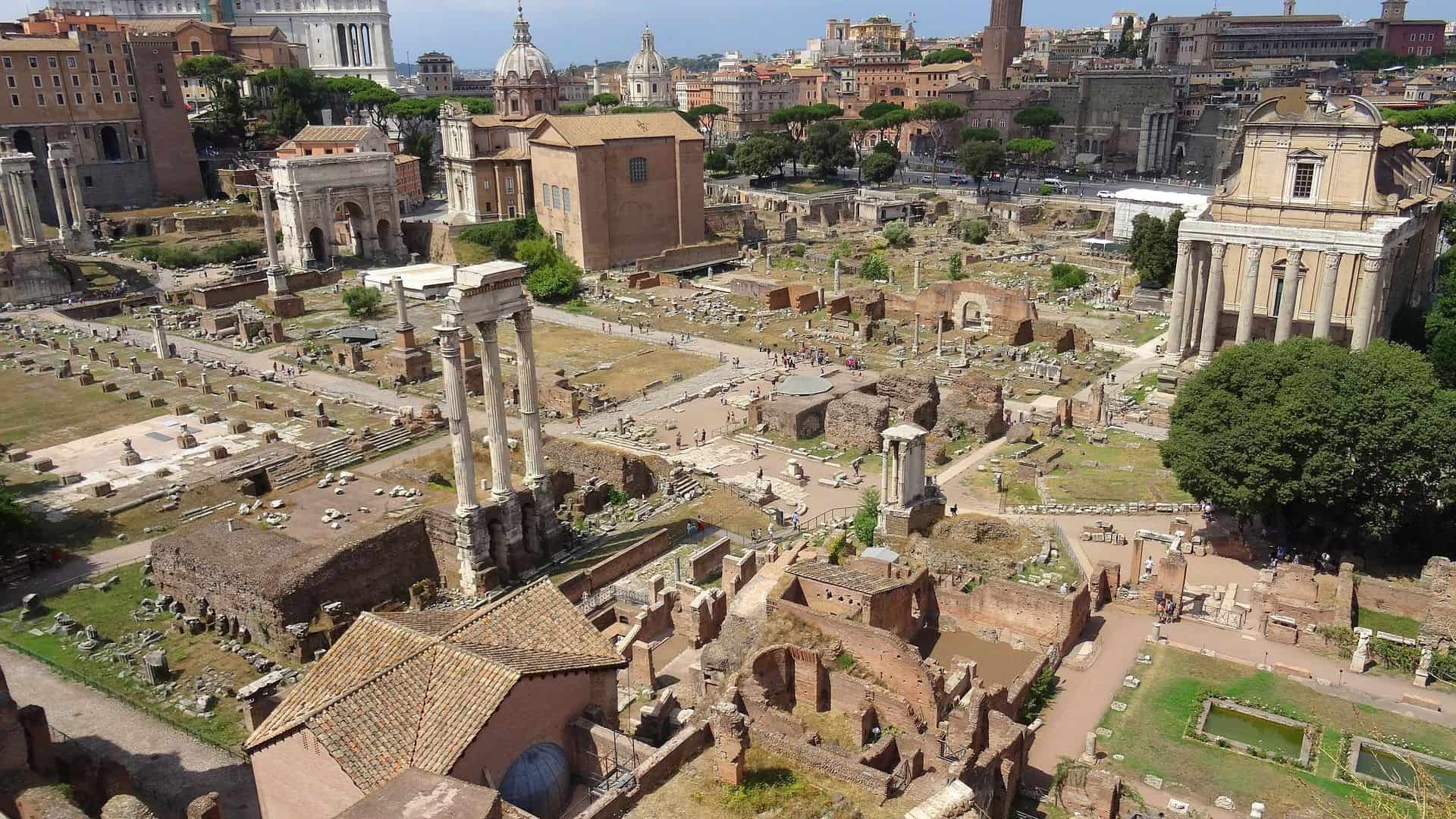
- Wander down the Via Sacra, the Main Street of Ancient Rome.
- Visit the temple and home of the Vestal Virgins – and discover where they would tend to the sacred eternal flame of Rome.
- Weave between the ruins of temples, meeting halls, and monuments in the Forum, and see the gravesite of the infamous Julius Caesar.

Everything You Need to Know About Visiting the Forum
Your entry to the Roman Forums and the Palatine Hill is usually included with your Colosseum ticket since the Forum is part of the same archeological park ( Parco Archeologico del Colosseo ).
The great thing is that it’s valid for 24 hours before or after your entry to the Colosseum. This means you are not obliged to see both on the same day. In fact, for reasons I’ll go through with you below, I would wholeheartedly recommend you see the Roman Forum first (ideally the afternoon before) and then see the Colosseum the following morning.
To get there, you have two options. Either you take the main entrance via Via Sacra (opposite the Colosseum) whereby you enter through the Arch of Titus OR enter from Via di Gregorio (just after the Arch of Constantine) for a more relaxed way in.
I’ll show you the Via Sacra entrance way as, while the busiest, is also the most evocative. But it’s your call.
This guide assumes you have a prebooked ticket with no guide.
Tickets & Prices
Explore the Roman Forum with ease by purchasing a ticket beforehand. You won’t have to waste extra time in the purchasing queues and can breeze through the ancient site.
Find out which of these Roman Forum tickets is best suited to you.
- Colosseum, Roman Forum & Palatine Hill (Priority Entrance) – Skip the line with this priority entrance ticket.
- Colosseum, Roman Forum & Palatine Hill (Last Minute Priority Entrance) – Last minute ticket for Colosseum entry.
- Rome Tourist Card (Bestseller) – See the best of Rome with this popular combi-ticket. Includes access to The Colosseum, Roman Forum and Palatine Hill, Vatican Museums & Sistine Chapel, St. Peter’s Basilica (official guided tour), and more…
- Rome Super Pass with Public Transport – Skip-the-line entrance to some of Rome’s best attractions with this combi-ticket. Includes unlimited public transport PASS (metro, bus, tram).
Tickets for Colosseum, Roman Forum & Palatine Hill
Entrance to the neighboring ancient sites of the Colosseum and Palatine Hill is also included with these tickets. You get to skip the queues and also download a digital guide to teach you the history of your surroundings.
Important Ticket Information:
- The tickets are valid for two days (including the day of activation).
- Re-entry is not possible once you leave the site.
- Palatine Hill is open from 10:00 – 19:15. While both the Colosseum and the Roman Forum are open 09:00 – 16:30. The last admission is an hour before closing.
- You should head to the Via dei Fori Imperiali entrance to enter the Roman Forum.
- You can choose between 5 visit routes, which vary from 30 minutes to 2.5 hours.
Rome Tourist Card
The Rome Tourist Card is the ultimate pass for new visitors to Rome. It grants you access to the city’s most iconic sights, from Palatine Hill and the Colosseum to the Sistine Chapel .
It’s perfect for people hoping to tick off all the main tourist spots during their visit.
- Includes skip-the-line access.
- The Colosseum, Roman Forum and Palatine Hill, St. Peter’s Basilica, Vatican, and Sistine Chapel are the attractions included.
- It is a digital pass.
- There isn’t a time limit on the Rome Tourist Card – it can be used and remain valid throughout your stay.
- You can book time slots online.
Getting There
Take the Metro to Colosseo – on the B (blue) line, two stops after Termini.
Exit the station, and the Colosseum will be right in front of you.
You will be tempted to start taking photos immediately but trust me, there are way better spots from where to snap a selfie.
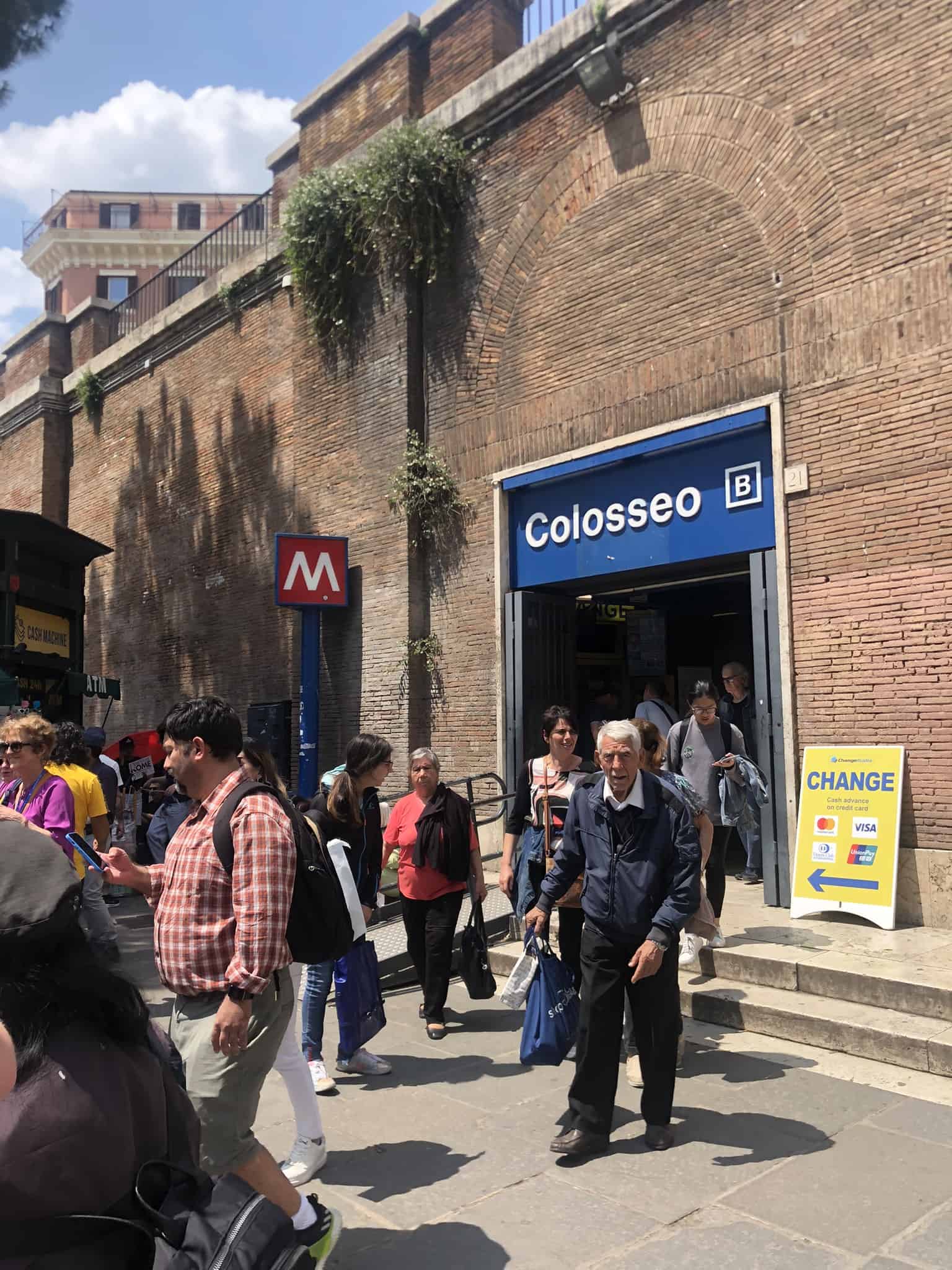
Neverending stream of people exiting the Metro statio
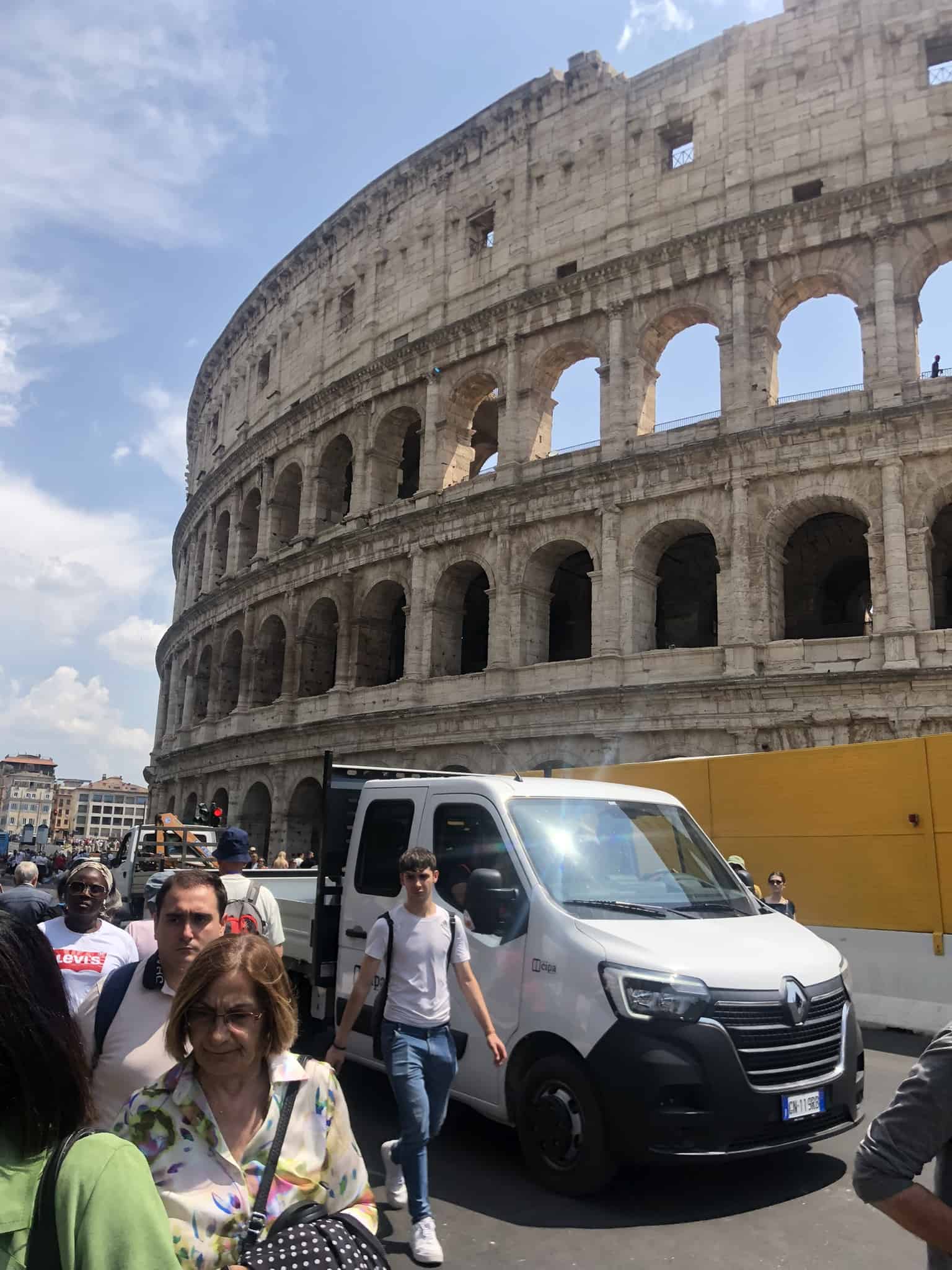
The Colosseum is directly opposite the Metro station.
The white and yellow panel obscures a construction site for a new Metro stop for the C Line.
It’s been a work in progress for over 20 years now, so something of a running joke among Romans.
- Top tip: Warning – there are two exits: lower level and upper level. After you come up the stairs and go through the ticket barriers, you’ll be on the lower level. Go straight out. You’ll be within sniffing distance of the Colosseum. You can’t go wrong. (Lots of guided tours have their meeting point at this exit of the Colosseum Metro.)
If, on the other hand, you walked or took a taxi , you’ll most likely be taken to the upper level exit (either by your phone’s GPS or the taxi driver).
Enter the Metro station and take the stairs down. You’ll arrive at the lower floor level of the station, opposite the Colosseum.
There are a lot of illegal ticket touts still operating in this area. Think of them like the sun. Make no direct eye contact. Ever. No need to be rude or get angry with them if they pester you. Just keep walking.
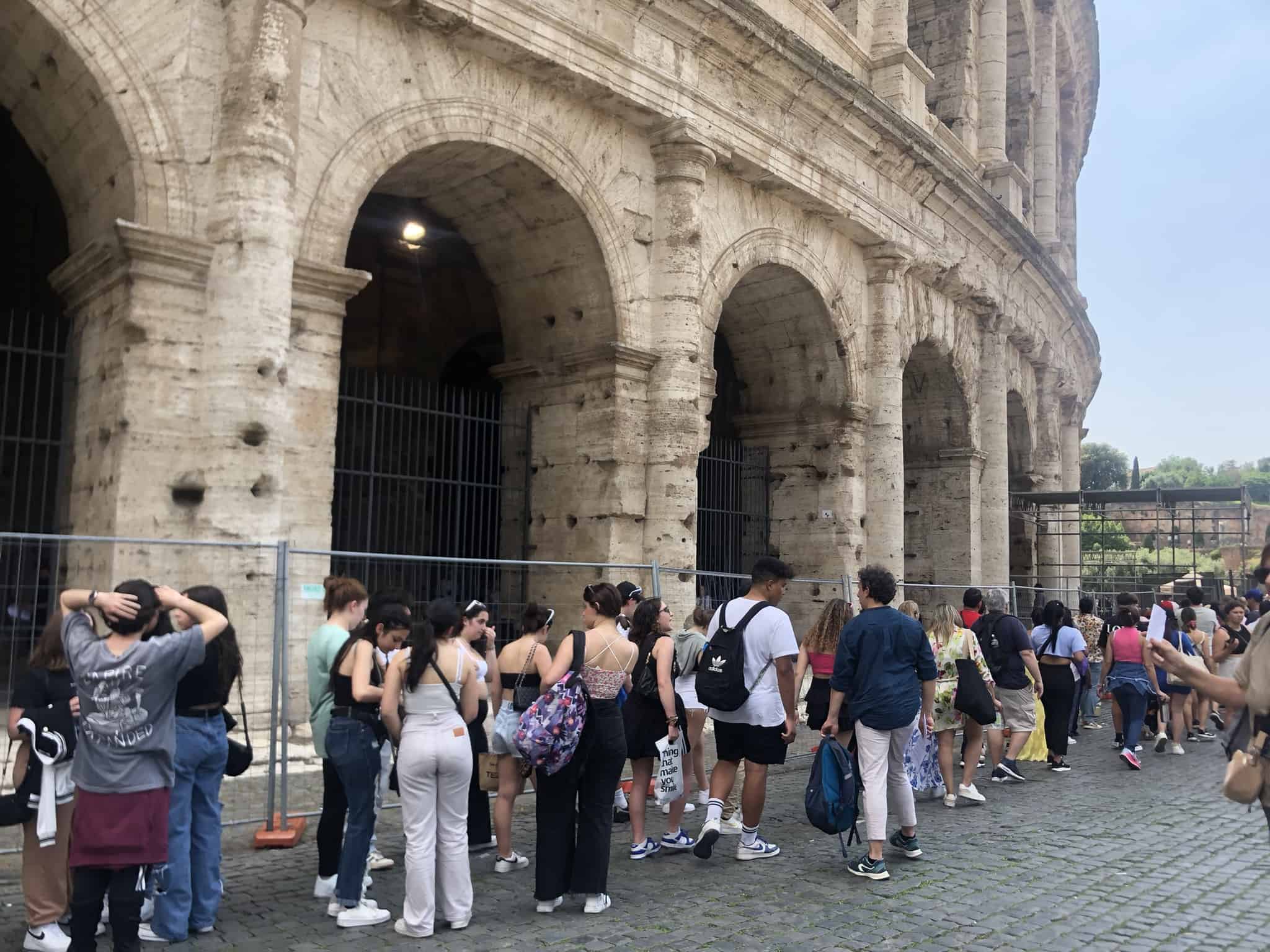
Group ticket holders’ line.
From the station, cross the road and as you pass the construction panel, you will probably see a very long line like this.
This line is for group ticket holders. They will be with their tour guide.
Follow the line for another 20 metres or so until you get to a sort of tree lined square, the other side of which will be another long line of people queuing up at the ticket office (see below).
Line for the ticket office opposite the Colosseum.
Cross over, walk past the ticket office and the line of people, and go straight until you come to Via Sacra and a sign indicating the way in that looks like this:
Entrance to Roman Forum on Via Sacra
- Top tip : Via Sacra is made up of huge shiny ancient cobblestones (much larger than the ones in central Rome known as San Pietrini). You’ll want to wear shoes with good grip.
Not sure how much of a flex this really is – there are literally hundreds of free potable water fountains in Rome. But it is the only water fountain at the Forum and with no cafes or restaurants, you will need it. You’ll find it just after the Arch of Titus.
- Top tip: Bring a refillable water bottle. There’s quite a lot of walking involved on Palatine Hill, and there are no restaurants. (Which is a shame because it would be very nice if there were).
Walk up the Via Sacra and you will be greeted by staff who will scan your ticket. You’ll go through a turnstile and then just like that, the epic Arch of Titus welcomes you in.
(I went in May 2023 which was ridden with days that started out with perfect blue sky and then ended with a thunderstorm. I liked it though; the sky, while ominous, just made everything a lot more dramatic.
- Top tip: Download the Parco Archeologico App . You can find it on the official Colosseum website or by scanning the QR code on the ticket information panels located next to the ticket office. It’s invaluable for helping you get your bearings around the deceptively large Roman Forums and Palatine Hill.
Above: Arch of Titus, and the start of most Roman Forum itineraries. Remember that scene in Ghostbusters 2 when dark clouds gather over the museum right before it gets covered in ghost slime?
What You Can Expect To See
basilica of maxentius and constantine – (313 c.e).
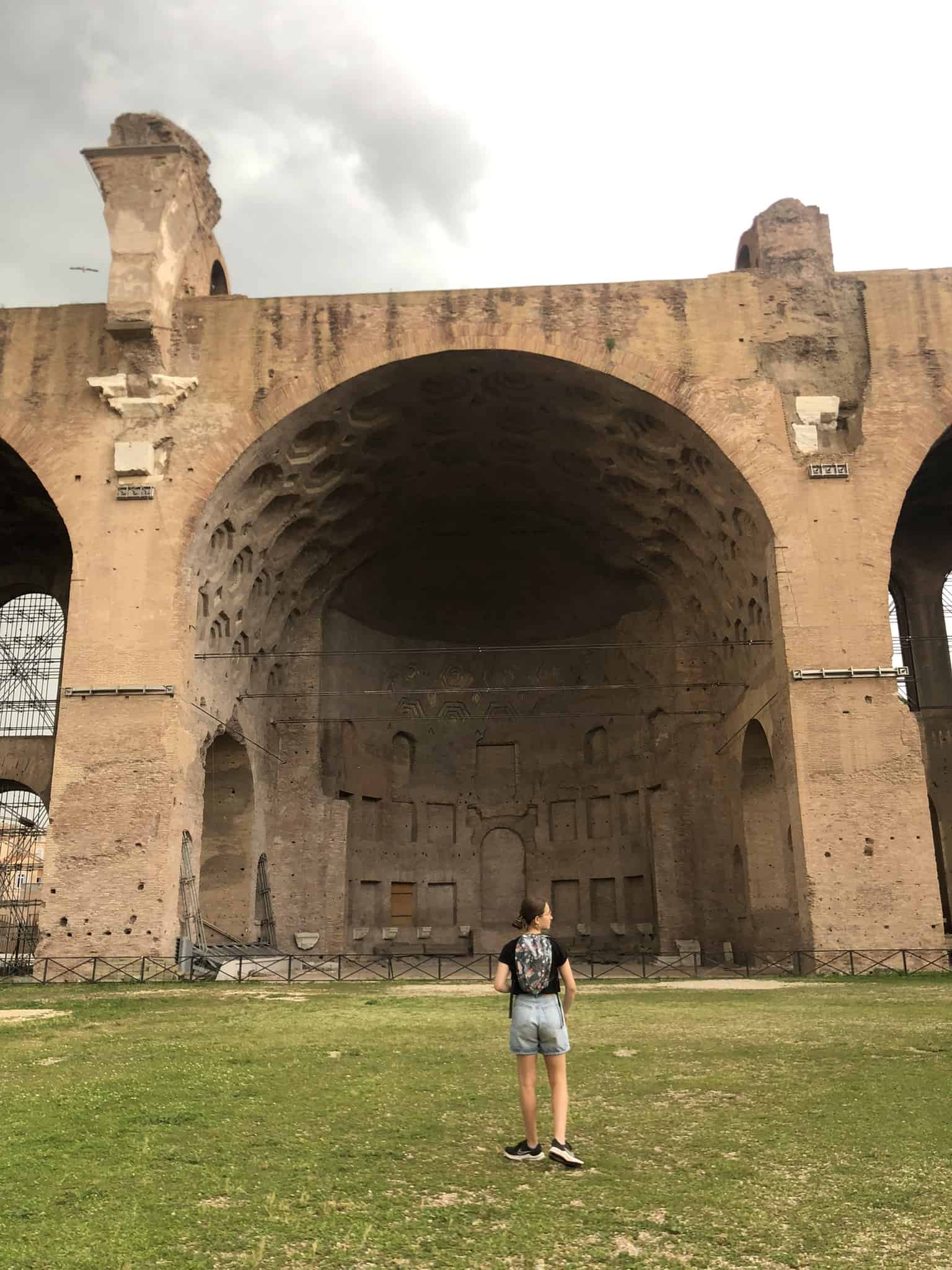
It’s really the scale that is the most impressive here.
The largest structure in the Forum, and of vast architectural importance; its design is said to have influenced the design of the St. Peter’s Basilica .
Artists’ renditions make it come alive, take a look before you go.
The Temple of Romulus – (300 C.E)
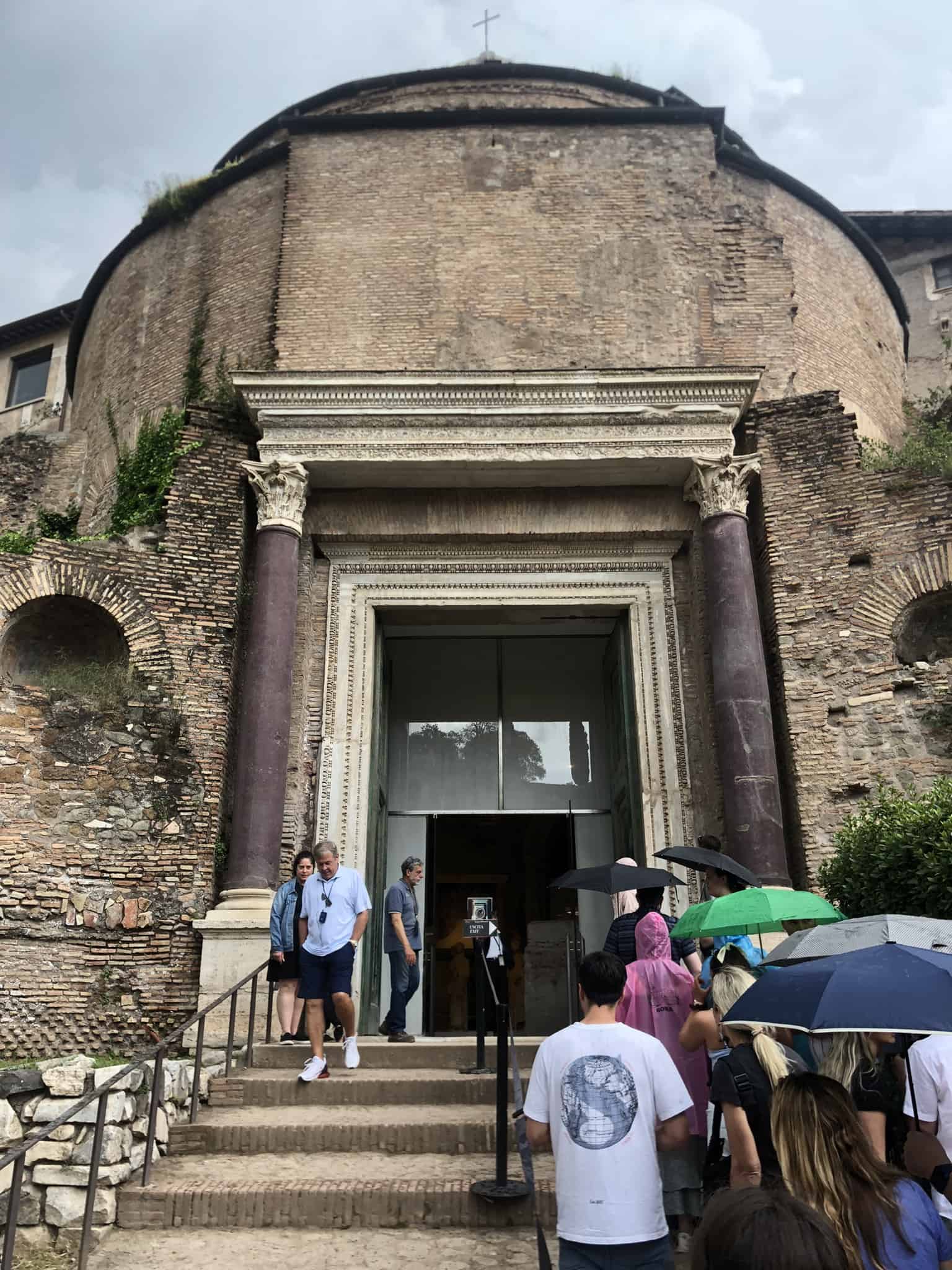
It’s unclear what the Temple of Divus Romulus was really used for other than an antechamber for the temple behind.
However, the bronze door, still used today, is 100% original. It was converted into a church in the 6th century.
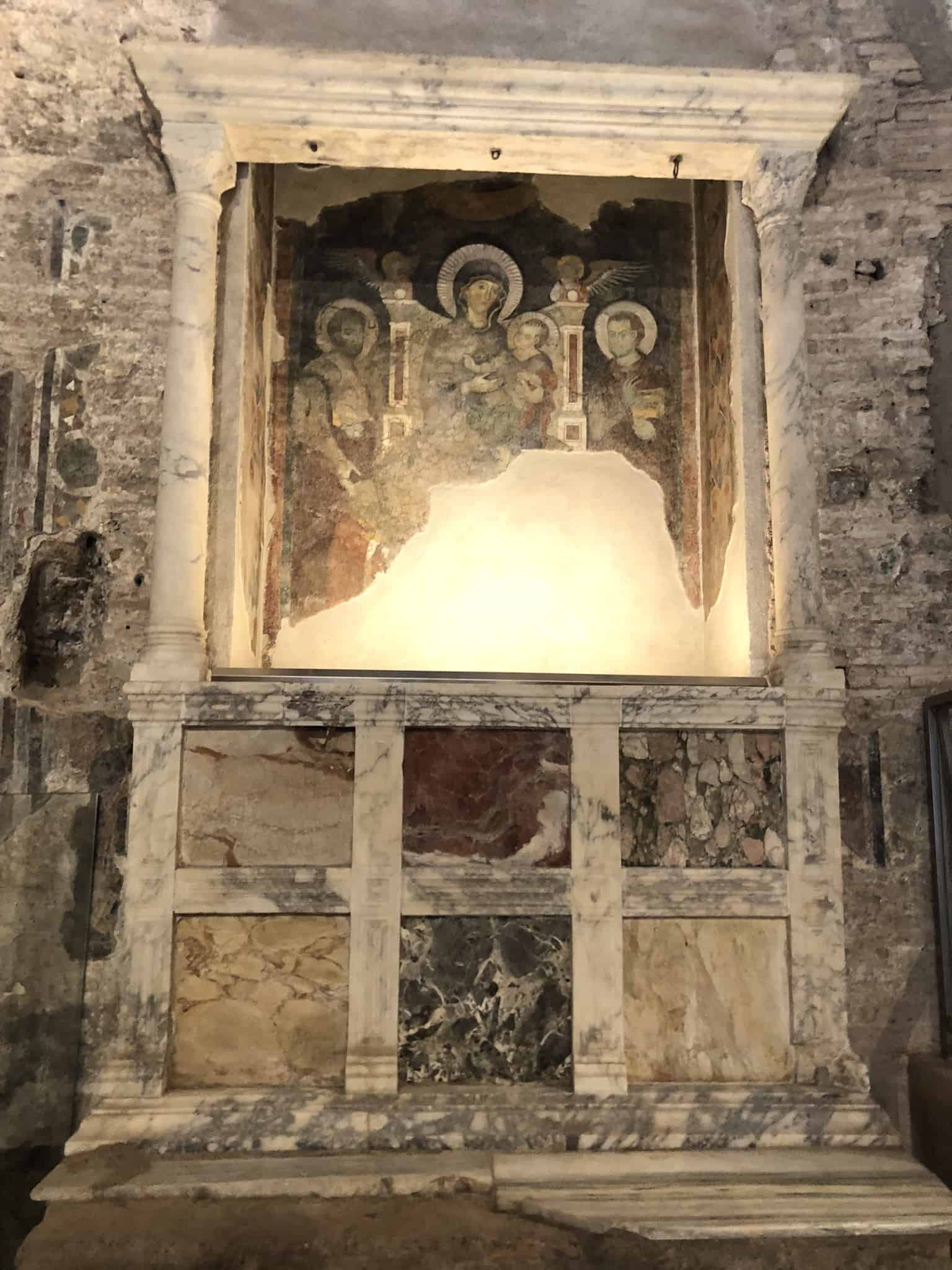
Detail of a fresco behind an altar from inside the Temple of Romulus.
The Temple of Antoninus and Faustina (141 C.E)
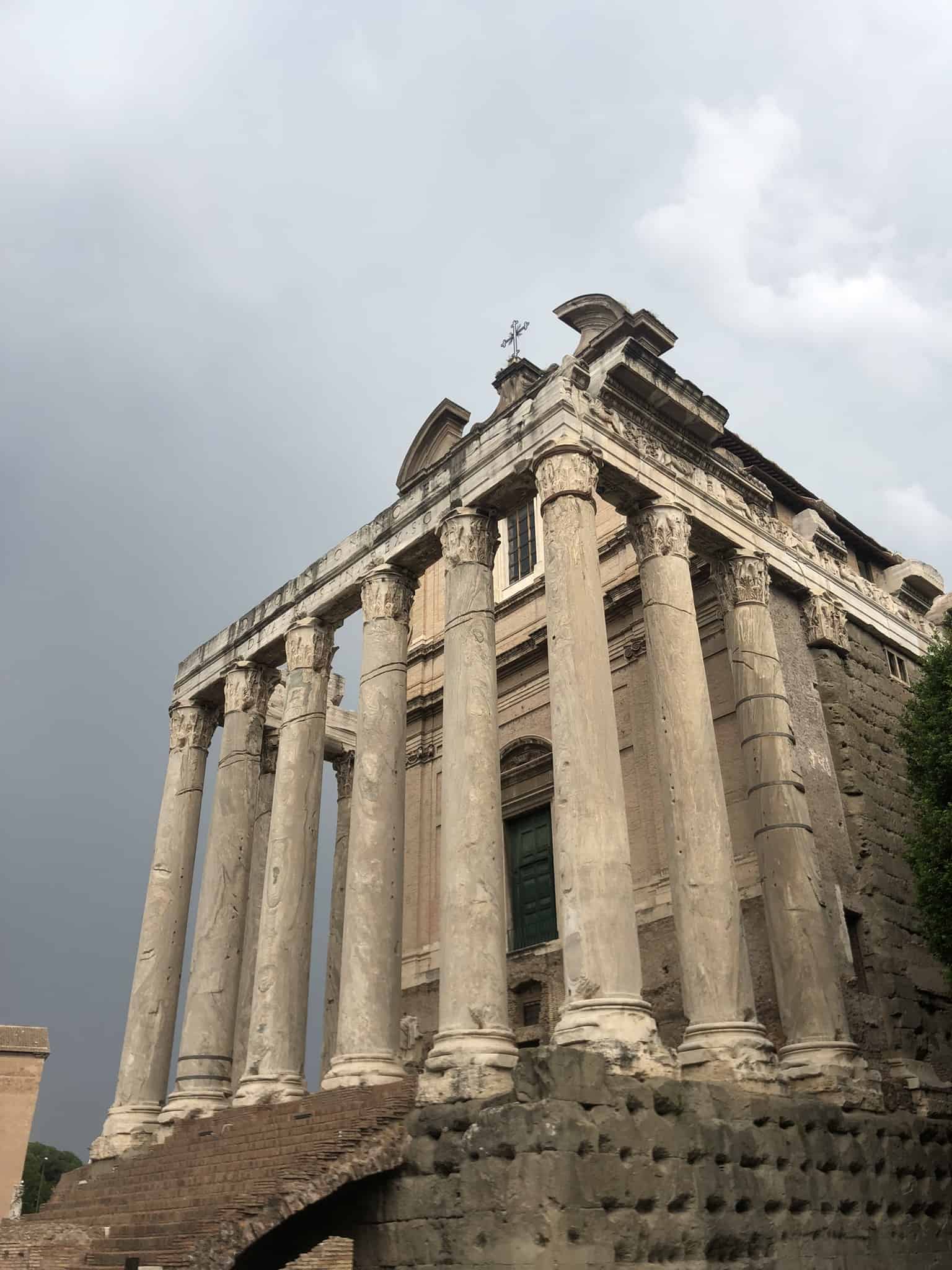
This one takes a second to figure out.
What’s that door doing up there?
19th-century excavations revealed the difference in street levels between Roman times and the 17th century. Contrast the threshold of the green door with the base of the steps leading up to the columns.
The Church, dedicated to San Lorenzo in Miranda is known as ‘the church in a temple’ for obvious reasons.
The Temple of Vesta
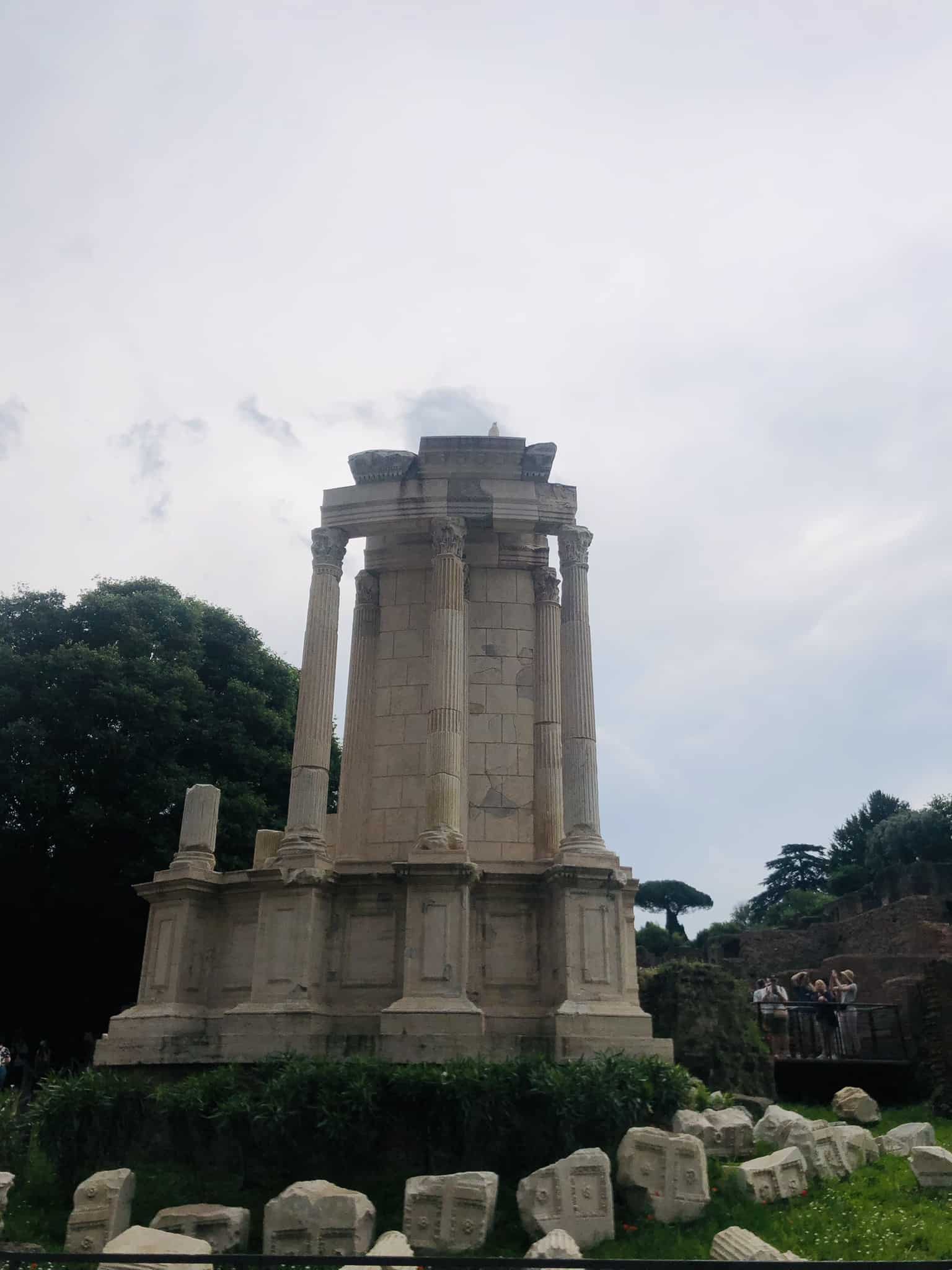
The oldest and most important shrine, it was home to the hearth which held the sacred fire of the state.
Religious activity on this site is estimated by historians to go as far back as 7th-century B.C.E.
Tempio dei Dioscuri
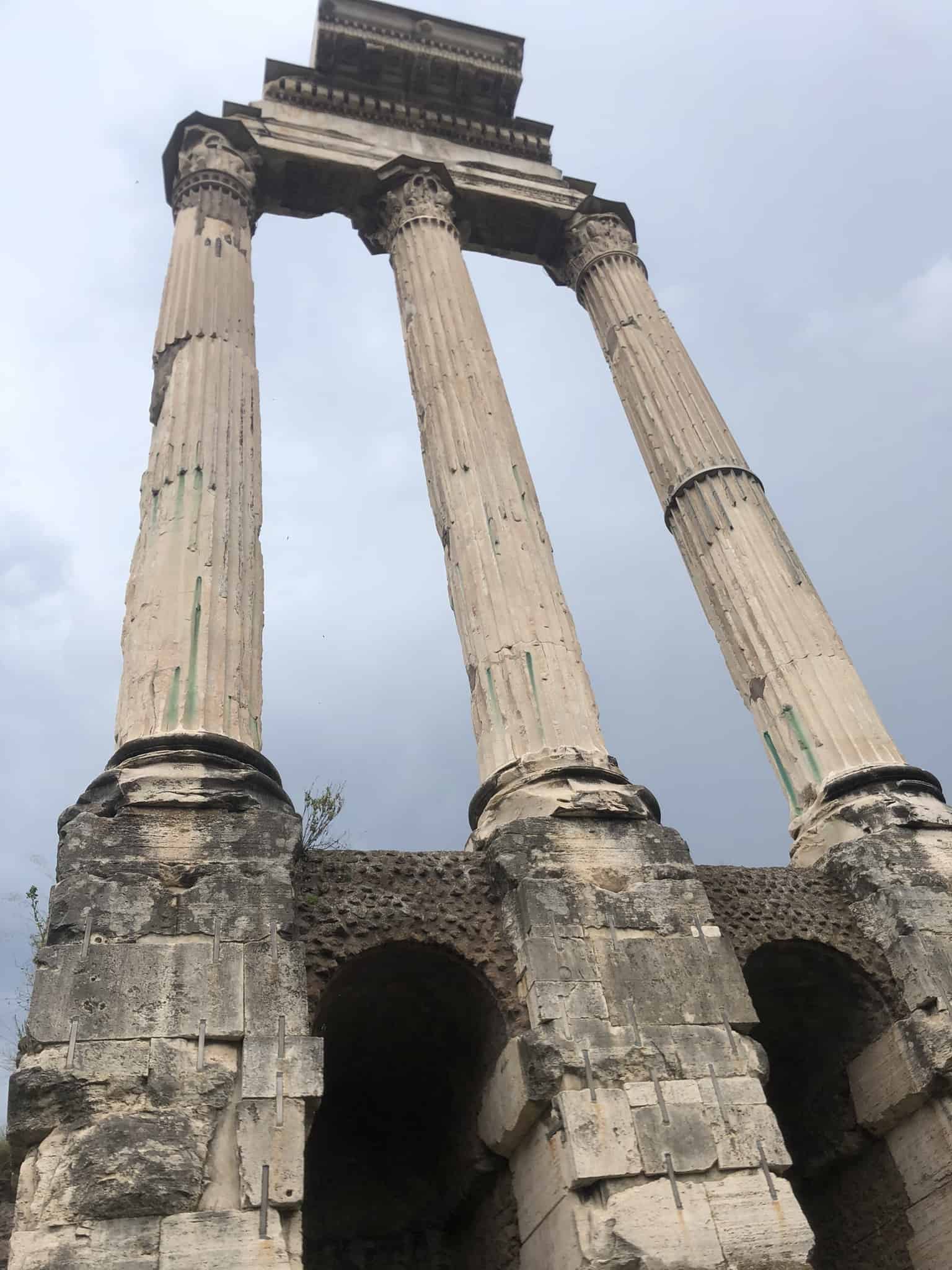
Temple of Castor and Pollux (Tempio dei Dioscuri).
Legend has it that the sons of Jupiter and Leda appeared on this spot to assist the soldiers of the Roman Republic overcome the last king of Rome.
Just these three columns remain, but they are iconic.
The Atrium Vestae
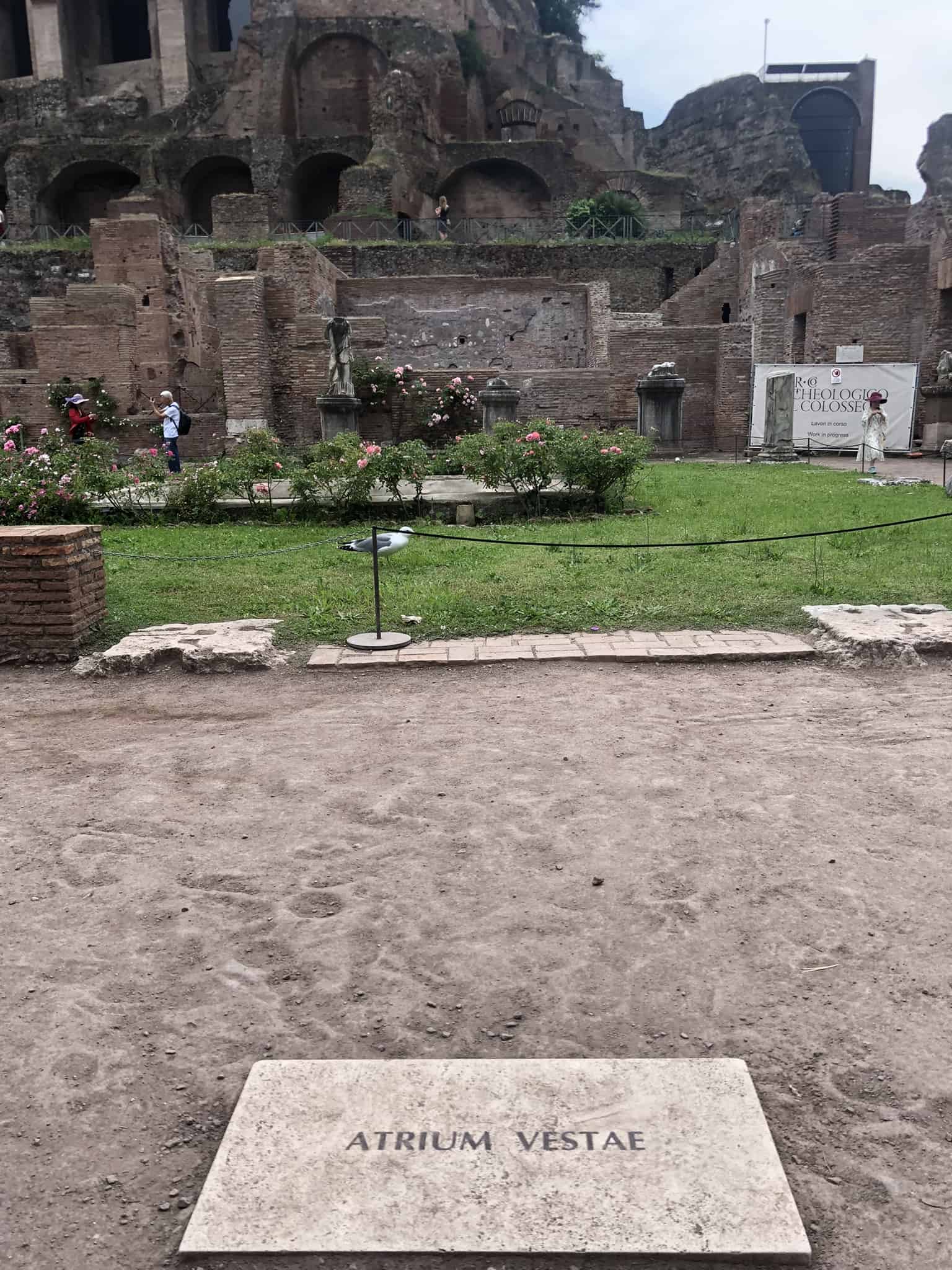
One of my favourite areas had to be the Atrium Vestae or the House of the Vestal Virgins.
(Vestal Virgins were women who would tend to the Temple of Vesta for a tenure of thirty years. As their title would suggest, they were virgins and were expected to remain celibate).
There are benches and it’s a great place to sit down, soak up the atmosphere, get your bearings, and prepare yourself for the Palatine Hill.
(See below for a super quick history lesson and why this is extra relevant).
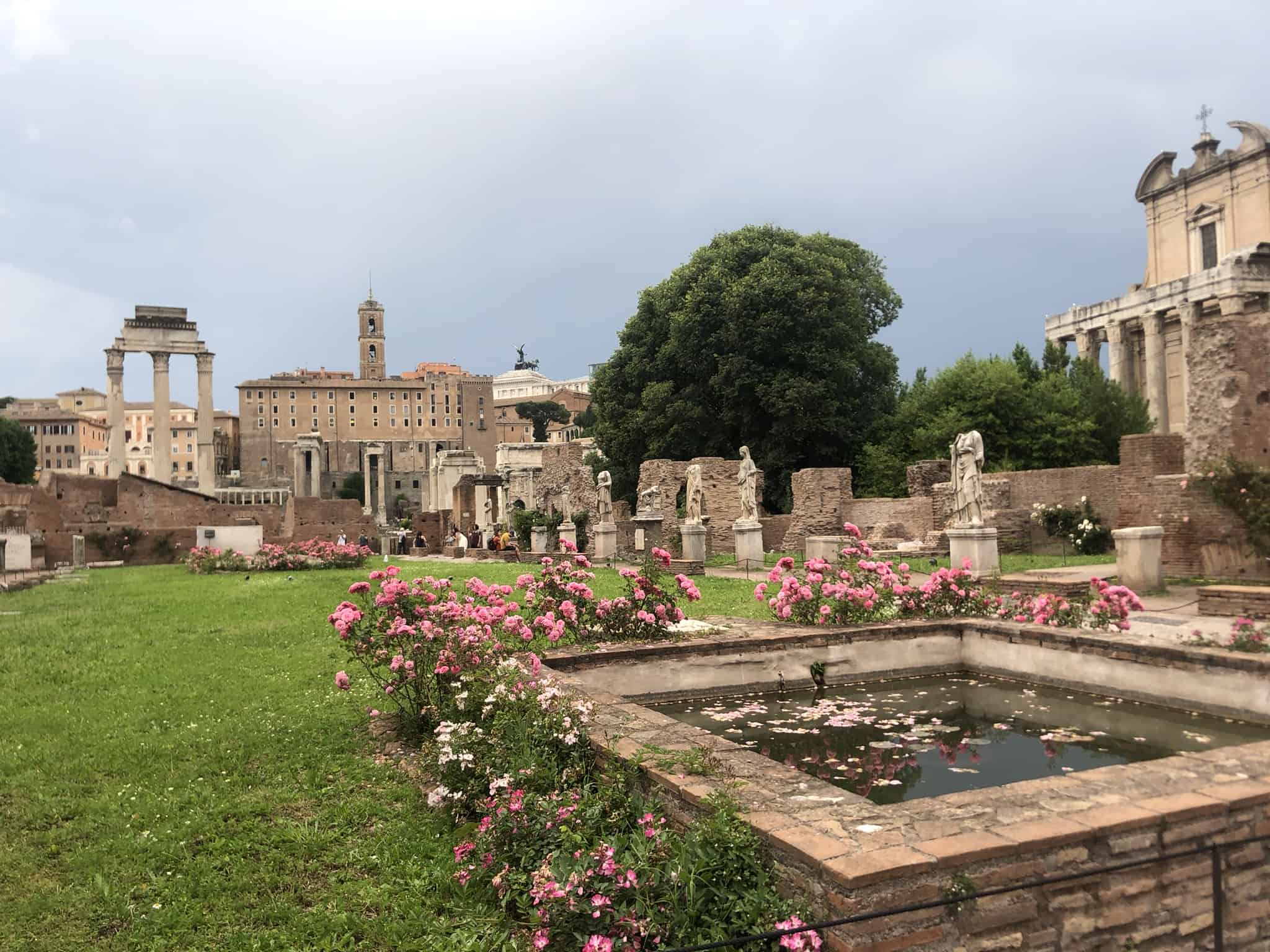
View of Tempio dei Dioscuri and Temple of Antoninus and Faustina from House of the Vestal Virgins, now a very serene rose garden.
Vestal Virgins
According to Roman mythology, a vestal virgin called Rhea Silvia was impregnated by the god Mars. She gave birth to twins and called them Romulus and Remus.
The King perceived the sons of Mars to be a direct threat and so ordered them to be killed. They were abandoned by the river but saved by the god Tiberinus, Father of the River.
As infants, they were suckled by a she-wolf (Lupa), and the cave ( the Lupercal ) in which she cared for them was believed to be up on Palatine Hill.
(If you ever wondered why the symbol of Rome was a wolf).
Years later, Romulus and Remus entered into a bitter dispute over where to build the city. Romulus favoured the Palatine Hill. Remus did not, so his brother had him killed. Romulus founded the city, called it Rome and the rest is history.
Palatine Hill Overview
The Palatine Hill has so many layers to it; both historically and mythologically.
It was home to the ruling classes of Rome for literally millennia. It’s dominated by the ruins of a network of imperial palaces from the first century called the Domus Augustana.
After a brief period of decline during the Middle Ages, things picked up again in the 16th century, when Palatine Hill became home to the first-ever botanical gardens in Europe thanks to the Farnese family.
Just a couple of pavilions and a fountain from what were once the most highly rated pleasure gardens in Europe.
The Palatine Museum at the top of the hill will help fill in the gaps showcasing the wealth and splendour of its previous inhabitants and their respective residences.
Cap it off with stunning views over the Circo Massimo from the Domus Augustana, before exiting via the Barberini Vineyard back down to Via di San Gregorio towards Circo Massimo.
Exploring the Palatine Hill
I started by exploring the vast imperial complex Domus Augustana. To add to the regal feel, classical music is played across the Domus area from discreetly placed speakers, which for me, went perfectly with the surroundings. It instilled a wonderful sense of calm:
The Nymphaeum of Mirrors
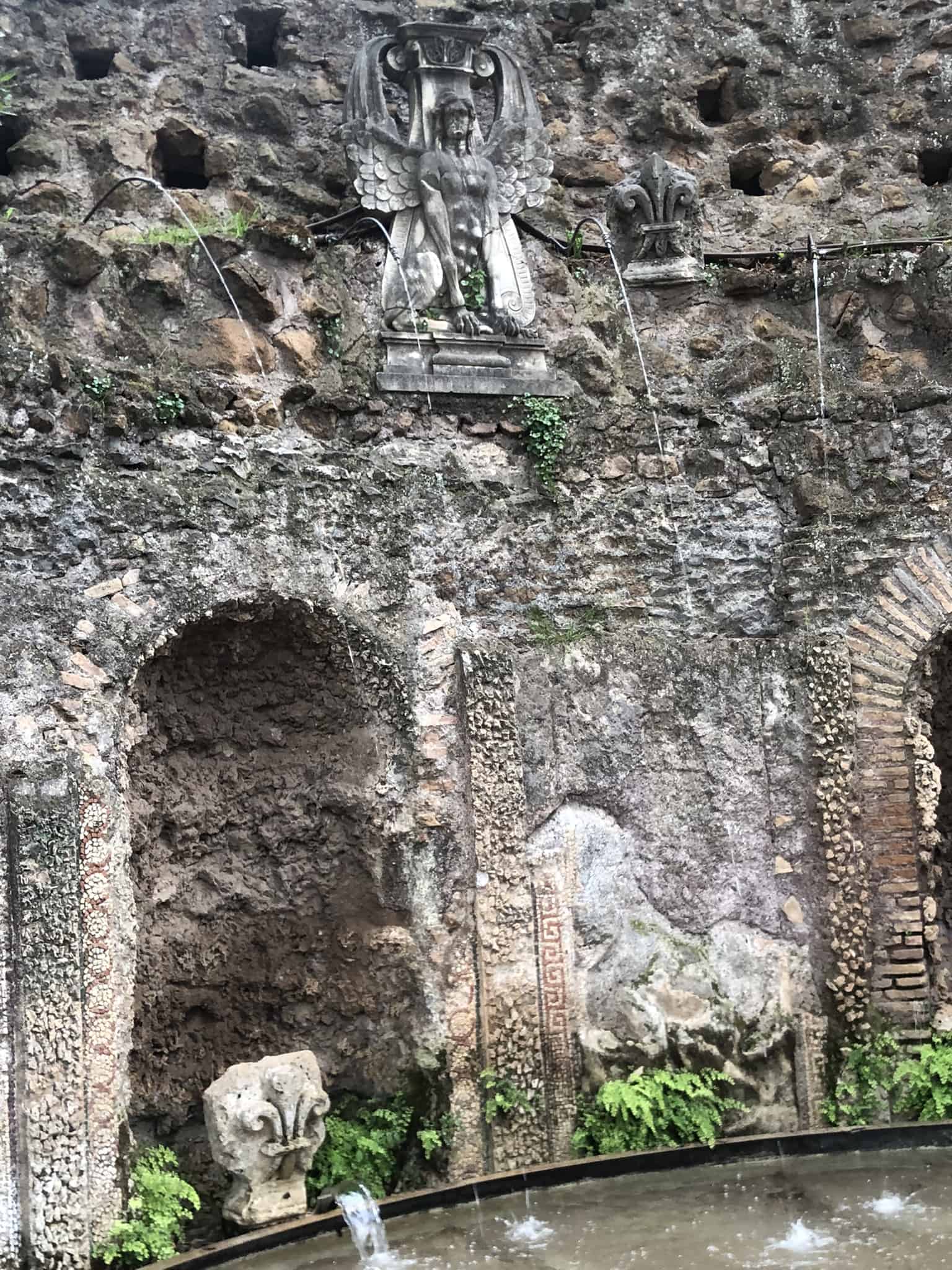
From here, I could still hear the classical music being played up the hill. I sat on a bench opposite the Nymphaeum of Mirrors – or what remains of these fantastic 16th-century water jets and fountains.
I still couldn’t quite get over how still and peaceful it was.
- Top tip : aim your visit towards the end of the day. Not only might you be lucky enough to enjoy romantic twilight views over the Circo Massimo from up on high, but it will be much quieter. Plus, you’ll wind everything up just in time for an aperitivo (between 6 pm and 7 pm), and I’ve got just the place in mind.
Making Your Way Out
Rather than going back the way you came and taking the Metro at Colosseo, exit here through Vigna Barberini. This lovely, almost rural walk downhill past random bits of Roman aqueduct will take you to the entrance/exit on Via di Gregorio, close to Circo Massimo.
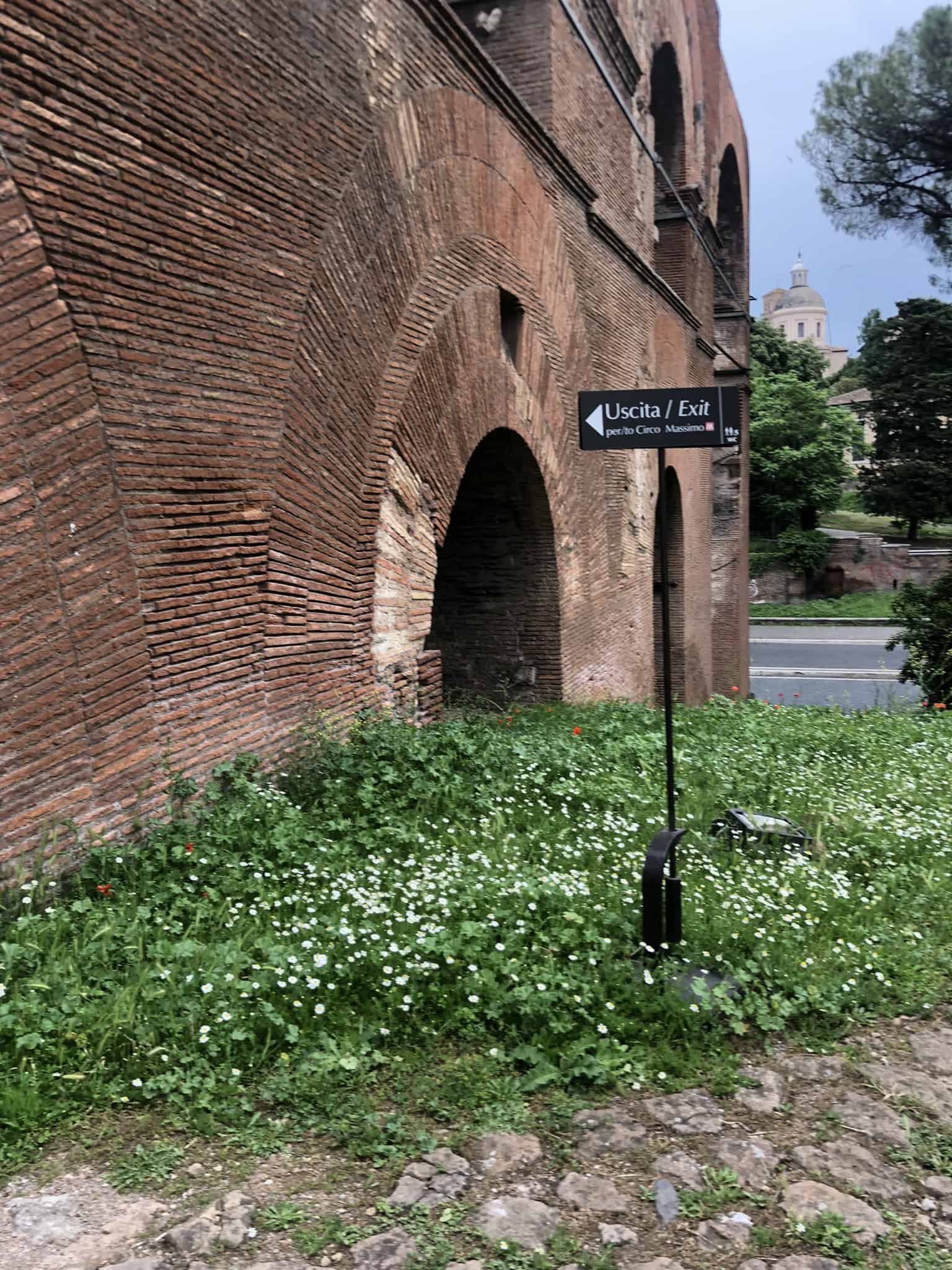
The Barberini Family Vineyard
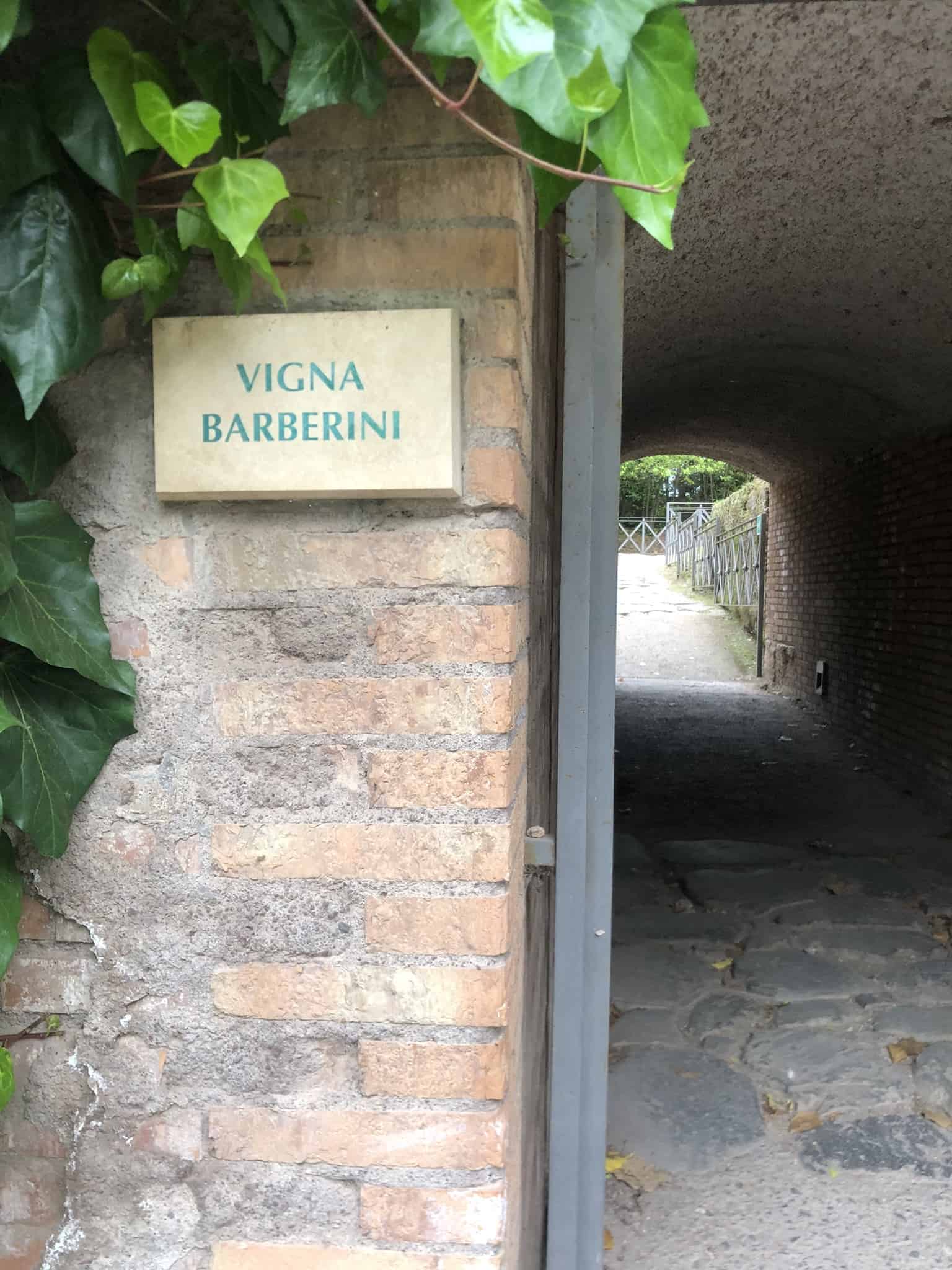
Now here’s a family that got around. This was a noble family from the 17th century that had their fingers in a lot of pies. (You’ll see their family crest at St Peter’s and they even have a Metro station named after them)
They owned property on this site in the 17th century, but the vineyard we see today was carefully planted in 2020 and viticulturalists are proud to be cultivating a very ancient vine called Bellone, known to have been used in Pliny the Elder’s time.
I visited towards the end of the afternoon and had the place to myself.
A very rural feel to the way out via the Vigna Barberini.
The path above will take you all the way down to Via di Gregorio and the splendid arch below.
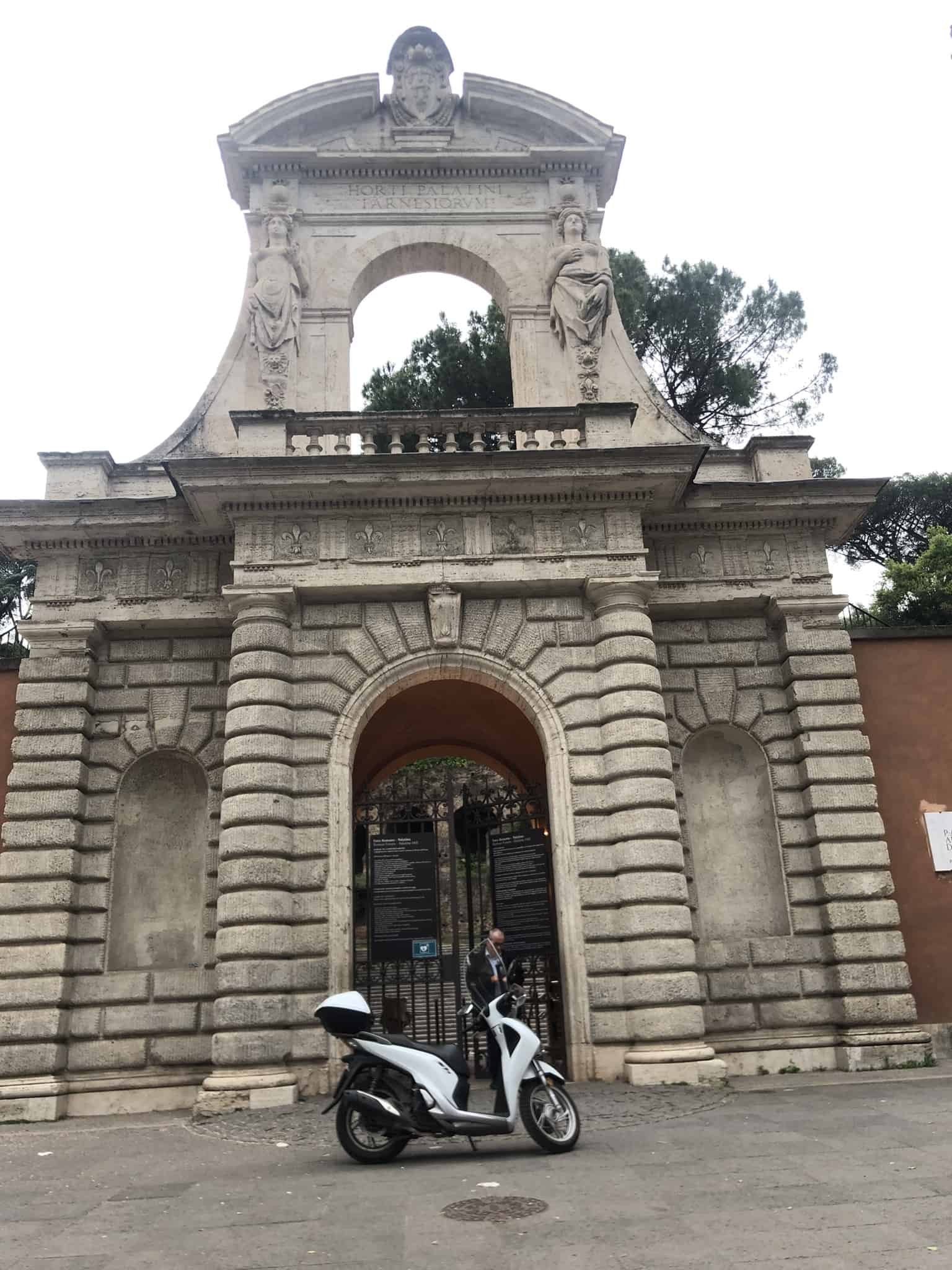
The entrance on Via San Gregorio, or the exit if you choose the Circo Massimo exit. The original entrance to the Farnese Gardens, when they were still a thing.
As you exit this splendid arch, the Arch of Constantine and the Colosseum will be on your left, and the Circo Massimo on your right hand side.
You could also choose to do the reverse and start your visit from here instead.
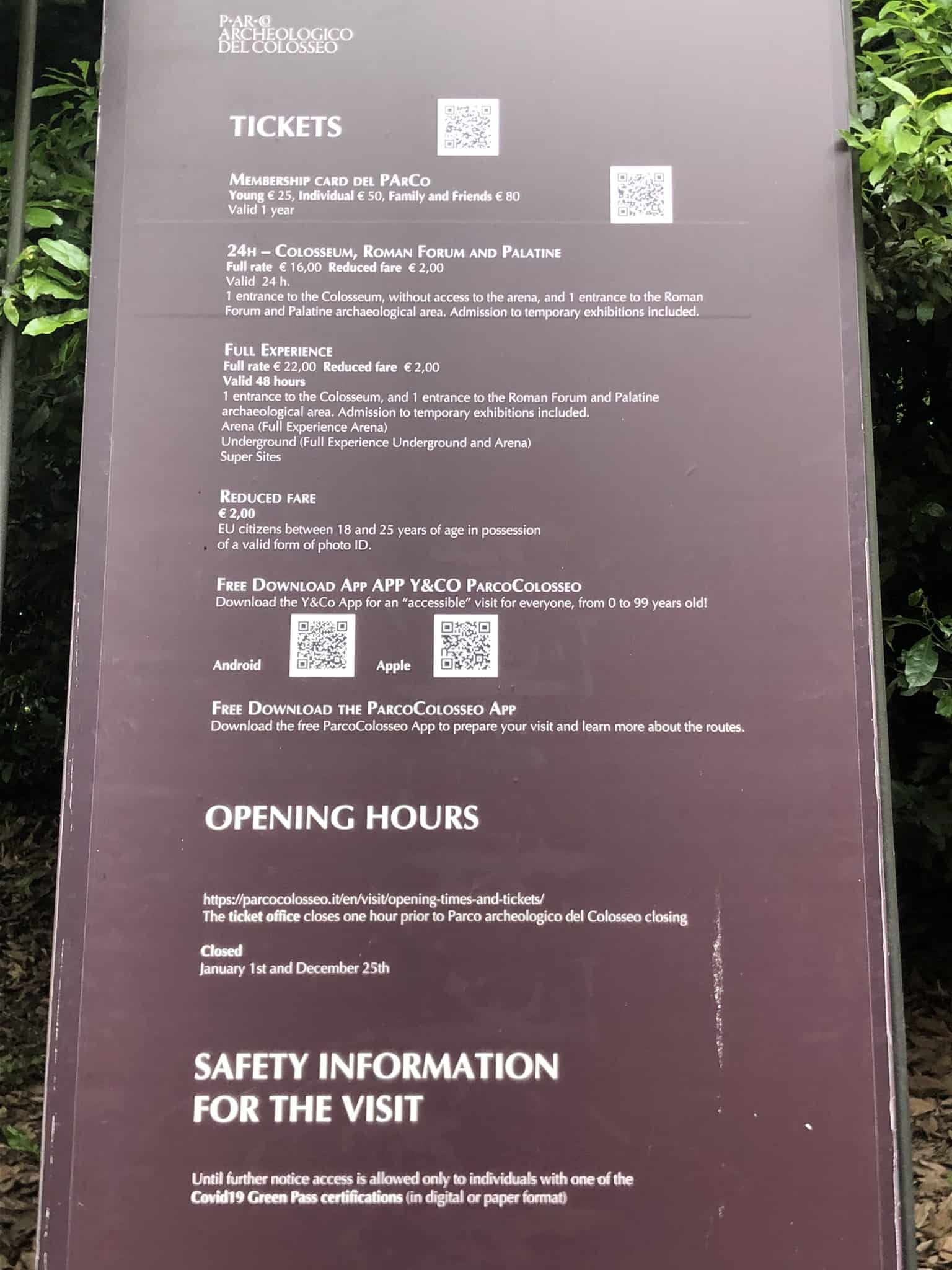
Italy has an absolute love affair with QR codes. They have them for everything.
This ticket information sign also has the QR code you need to download the Parco Colosseo App which includes a detailed itinerary for the Forum as well. Highly recommended.
You’ll find another sign like this by the ticket office opposite the Colosseum, next to Via Sacra.
Be aware that there are no gift shops, cafes, or restaurants at the Roman Forum or Palatine Hill. So bring snacks. The only official gift shops are located within the Colosseum.
Nearby Attractions
Circo maximo experience – viale aventino, 00186.
Through the use of Virtual Reality headsets, you’ll be transported back to the 1st century C.E and witness chariot races and a slice of Ancient Roman life at the Circo Massimo. A 40-minute walking tour; it’s a mere five-minute walk from the Arch of Constantine.
Panoramic view of the Circus Maximus as seen from the Palatine Hill.
Basilica San Clemente – Piazza di S. Clemente, 00184.
A five minute walk away is a stunning 12th century church.
Beneath lie archaeological excavations that take you on a voyage through time. You’ll go down to the remains of a 4th century church, and then descend once again to a 1st century pagan temple.
You’ll need to book ahead. The basilica itself doesn’t provide guided tours (local tour providers take care of that), and you will need to make sure you dress appropriately. No bare shoulders or short shorts.
Food and Drink
Bars and restaurants directly opposite the Colosseum are, not surprisingly, tourist traps. It had to be said. Instead, head to Viale Aventino; the long and cosmopolitan avenue (thanks to all the expat UN staff who frequent its bars) which connects Circo Massimo to Ostiense. It’s lined with a variety of bars and restaurants including:
So Good – Viale Aventino, 87, 00153.
Craft ale on tap and pastrami bagels. The bagels aren’t exactly NYC authentic, but portion sizes are good, and you get the option of pickles and mustard (not a given in Italy).
14 minute walk from the Arch of Constantine.
Gusto Massimo Bar – Via del Circo Massimo, 5a, 00153.
Aperitivo, pizza and good hot lunch food. A UN staff local, (working at the impressive UN Food and Agriculture building across the road), and five seconds from Circo Massimo Metro station.
8 minute walk from the Arch of Constantine.
Elleniko – Viale Aventino, 83, 00153.
Cheap Greek street food. If you want a break from Italian carbs, try Greek instead.
Elleniko offers authentic Greek street food at affordable prices.
Next door to So Good. 14 minute walk from the Arch of Constantine.
Did You Know That: 5 Interesting Facts
- At its lowest point, the Forum was used as a pasture for cattle. It was known as the ‘Cow Field’ during the Middle Ages.
- Much of the Forum was in good condition until the 16th century, though parts had been damaged by earthquakes and neglect. Pope Paul III ordered the plunder and repurposing of the Forum’s materials to build St. Peter’s Basilica, causing untold damage.
- The Arc de Triomphe in Paris was modeled on the Arch of Titus.
- After the brutal assassination of Julius Caesar, his body was cremated within the Roman Forum. Following his death, the legendary general and statesman was deified, and the Temple of Caesar was constructed on the site of his cremation. Much of the temple has been destroyed, but you can still see the remains of the altar today, which would have been treated as Caesar’s grave.
- As well as being a space for social gatherings, politics, and religious ceremonies, the Roman Forum was used as a place to conduct criminal trials. The heads of enemies were often displayed in the Empire’s twilight years.
A timeline of the Roman Forum’s place in Ancient Rome:
- 753 BC. Rome was founded by twin brothers Romulus and Remus. Buildings soon spring up to form the Forum, a communal area that Romans will use as a marketplace, religious center, and political stomping ground.
- 497 BC. The original Temple of Saturn was built. It will prove to be the first of many iterations.
- 44 BC. Julius Caesar was assassinated. His body is cremated in the Forum.
- AD 203. The Arch of Septimius Severus was built to commemorate the Emperor’s military victories against the Parthians.
- AD 394. Non-Christian worship is banned. The Roman Forum slowly fell into disuse.
- AD 410. Fall of the Roman Empire. The Western Roman Empire fell, and the Forum suffered heavy damage in the process.
- AD 608. The Column of Phocas is erected. It is considered to be the final ancient monument built in the Forum.
- AD 847. A huge earthquake damaged many of the buildings in the Roman Forum.
- AD 1539. Further damage was caused on the orders of Pope Paul III. Materials from the Forum are used to construct other sites, including St. Peter’s Basilica.
- AD 1803. Archaeologist Carlo Fea began excavation work at the Roman Forum. The full extent of the project would take over 100 years.
The Roman Forum was used as the center of Roman society. People met here publicly to discuss politics, pass laws, sell goods, and hold religious ceremonies.
The Roman Forum has suffered damage over the years through natural occurrences such as earthquakes, pollution, and weathering. Many of the stones and columns have also been stolen by thieves.
Address: Roman Forum, Via della Salara Vecchia 5/6, 00186 Roma, Italy · view larger map
Visiting the Roman Forum: all you need to know + best things to see and tips
All you need to know to plan a visit to the Roman Forum. Where to get the best tickets, the best things to see in the Roman Forum and the Palatine Hill, practical tips. Updated June 2021.
The Roman Forum is the heart of Ancient Rome and, nowadays, one of the most important archaeological sites in Rome and in the world.
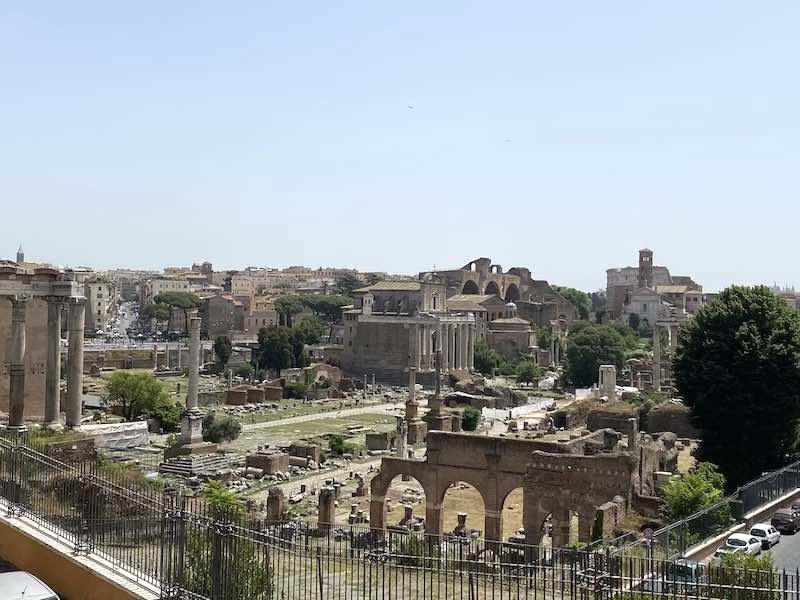
The ancient Rome Forum sits inside what is now the modern city and it is nestled between the Colosseum on one side, the Campidoglio Hill on the other, and the Palatine Hill, where the Palaces of the Emperors lie.
It is one of the most beautiful places in Rome however, it is also a place that attracts less attention than the nearby Colosseum.
While the Colosseum is on the bucket list of pretty much any Rome visitor, it is not unusual to find people wondering if the Roman Forum is worth visiting at all and I think the question is worth a proper answer.
While I believe the Roman Forum is stunning and a must-see for everybody I also believe that it is important to go there being prepared to what the forum is, what it isn’t, what to expect and how to tackle it at best.
This is my guide to visiting the Roman Forum.
Good to know . As well as being born and raised in Rome, I am a classics graduate and my dissertation was on Ancient Rome. So you can say I am biased when it comes to the Forum: I do love it! For the longest time, the Forum didn’t have good explanation panels and my recommendation was to get a guide to make the most of your visit. While I believe a guide is still worth it, the free app ‘Parco Colosseo’ now exists and operated almost as an audio guide. A good, budget-friendly option to see the Roman Forum!
Table of Contents
All you need to know to plan a visit to the Roman Forum
The Roman Forum is the area of Ancient Rome where public and religious life used to take place.
The Forum is now an archaeological site and, in a way, you can say that the Roman Forum is Ancient Rome.
Unlike the Colosseum or the Baths of Caracalla, that are two ancient stand-alone buildings, the Roman Forum is a large area where you literally walk along ancient Roman streets.
The area is large and mostly outdoors. Being prepared for the weather and for the uneven terrain is a must: I share all my tips on how to dress and what to bring to the Roman forum later in this guide.
The best things to see in the Roman Forum
The Roman Forum is a rather large area with plenty of things to see.
The Forum Proper is a flat area comprised between the Capitoline Hill and the Palatine Hill, the two most significant of the seven hills of Rome.
The Palatine Hill is immediately above the Forum and it is accessible though it. The Hill is where Romulus, Rome’s founder, set his hut and where the Emperors then built their palaces.
The best things to see in the Roman Forum are both on the Forum Proper and on the Palatine Hill. Let’s have a look at them.
Via Sacra is the Main Street crossing the Roman Forum.
Nowadays, you see is as connecting the Colosseum to the Capitoline Hill but it predates the Colosseum by many centuries.
The tradition reports that the Via Sacra was were Romulus won over Titus Tatius King of Sabina (VIII century BC) and while at the time the road was a little more than a muddy trail, this tells us some form of street here must have been in use from very early on.
The paving of the street as we see it now is made of slabs of basalt and seems to date from Augustan times (I century AD).
In historical times, the road was used for thriumphal procession after successful military campaigns.
The military parade would walk along this road with the prisoners and the flags of the enemy, bringing the victorious general in triumph all the way to the top of the Capitoline Hill, where the temple of Iuppiter Optimum Maximus (Jovis) used to be.
The Via Sacra is now one of the most scenic areas of the Roman Forum, especially close to the Colosseum, where tall columns are still standing, giving a sense of what this road must have looked like at its best.
The triumphal Arch of Titus
The first impressive monument you find on Via Sacra is the fantastic Arch of Titus.
The arch is one of the three triumphal arches in Rome and dates from the I century AD.
This is a celebratory monument build by order of Emperor Domitian, to honour his precedessot Titus.
As the inscription and carvings on the arch show, the arch commemorated Rome’s victory over Jerusalem and the taking to the temple, an event historians describe as happened in 70 AD.
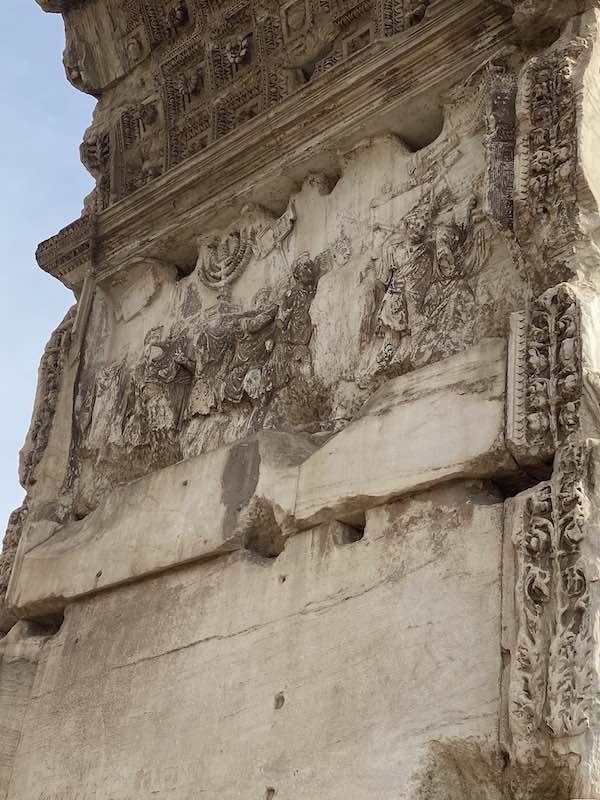
The Temple of Antoninus and Faustina
One of the most beautiful and best preserved buildings in the Roman Forum is the Temple of Antonino and Faustina.
The Temple sits on the spot where the Via Sacra meets the Forum and it was built in 141AD for Emperor Antoninus Pius and his wife: Faustina.
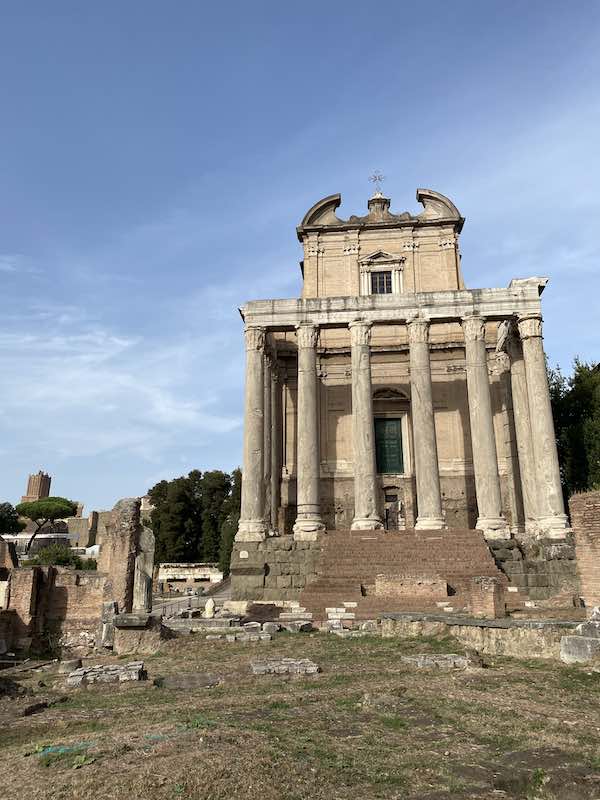
Like many ancient religious buildings, the temple became a a church in the Middle Ages and acquired the name of San Lorenzo in Miranda: this fate changed its appearance but it also ensures its preservation and allows us to enjoy it today.
An inscription at the top of the temple says ‘Divo Antonino et Divae Faustinae Ex. S.C.’ which means that the Senate dedicates this temple to the Emperor and his wife.
The temple stands on a podium with a height of 5 meters and is accessible by a recent staircase. This is one of the tallest buildings in the Roman Forum and one of the most eye-catching.
The Temple of Divus Romulus
The so called Temple of Divus Romulus is a round structure opening onto Via Sacra, inside the Forum.
It is not sure what the use of the temple originally was but we know it was built by Emperor Maxentius at the beginning of the IV century and was later incorporated into the church of Saint Cosma and Damiano, built here in the VI century by order of Pope Felix IV.
This temple is stunning and holds unique worth seeing. Please note that this temple is only accessible with the ‘Full Experience’ ticket.
The Roman Forum Square
The main square of the Roman Forum is a large area at the center of the Forum where all the most important business transactions and public events in the city would take place.
The area was an open unbuilt area for a long time but acquired an increasing number of public buildings and monuments, the latest of which is the column of Phocas, one of the most significant columns in Rome , dedicated in 608AD to the Eastern Roman Emperor Phocas.
Along the short sides of the square, there stood the platforms from where the orators would speak, the Imperial Rostra, the Rostra Vandalica and the Rostra ad Divi Iuli, dedicated by Augustus to Julius Caesar.
On the northern side of the square used to lay the Basilica Emilia: this was a civic area that used to serve as bankers’ headquarters and seems to date to the I century BC, yet the restored and modified many times in subsequent centuries.
On the southern side of the Roman Forum square there used to be another basilica, the basilica Iulia. This basilica seems to have been used for political, judiciary and economic activities and it takes its name from the person who commissioned its built: Julius Caesar.
Fun fact : here is where you can see remains of tabulae lusoriae , the ancient Roman equivalent to our board games! This is one of the best things to show children if you are visiting the Roman Forum with kids.
The Curia was the ancient seat of the Roman Senate. It is a large brick building wanted by Julius Caesar and inaugurated by Augustus, modified by Diocletian and finally turned into a church in 630 AD, fate that allowed the preservation of its beautiful Byzantine Frescoes and its stunning bronze door.
The Arch of Septimius Severus
The Arch of Septimius Severus is a large triumphal arch dating to the III century AD.
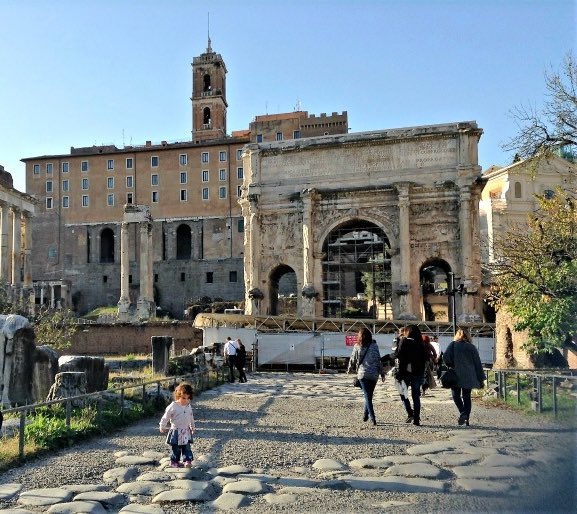
It sits at the end of Via Sacra, just below the slopes of the Capitoline Hill and it made of travertine, brickwork and marble.
The arch has the impressive size of 25×11.20×11 mt.
An inscription tells us that the arch was built to honour the Emperor and his son for ‘restoring the State and extending the empire of the Roman people’ and it used to have a bronze sculpture on top that would overlook the Forum.
Fun fact: in the Middle Ages, the arch became a fortress tower! It was restored only in the 1980s.
The House of the Vestals
The house of the Vestals is one of the prettiest areas in the Roman Forum.
It is one of the most ancient buildings in the city and it is usually associate with King Numa Pompilius, who established the Vestal Virgins as an institution.
The house got destroyed during the large fire of 64AD but was then rebuilt so we see now a later version of it. Still well visible are the rooms, the stairs to the upper floors and the portico, one of the most beautiful spots I the whole of the Forum.
The Temple of Vesta
The Temple of vesta is on the Eastern side of the Roman Forum and it easy to recognize thanks to its distinctive round shape.
The temple used to be part of the same complex as the house of Vestals, nearby. The temple was badly damaged however, ancient coins tell us the shape it would have had and restoration work from the 1930s patched up some of the fragments found in the area.
The Regia is said to be the place where King Numa Pompilius used to reside. This is one of the oldest sites in the Forum, with remains archaeologists were able to date back to the Iron Age.
The ancient necropolis
Between the temple of Antoninus and Faustina and the Temple of Romulus, archaeological excavations in the early 20th century brought to life and ancient necropolis (cemetery).
These graves date from the Latin Age (X century BC) and therefore predate almost anything else in the Forum. These are an important find for historians and archaeologist as they shed a light on a much more ancient use of this area that our ancient Roman sources do not cover.
The Farnese Gardens
If, from the Forum, you look up towards the Palatine Hill, you will see a structure that is clearly not ancient but rather from Renaissance Times, the ‘Farnese Gardens’.
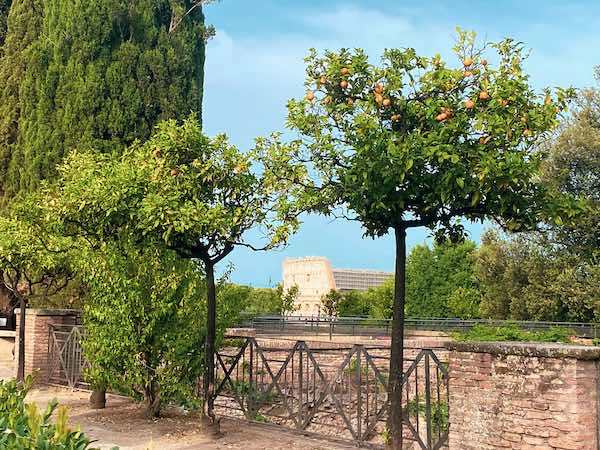
The Gardens were built in the early 1500s by Pope Paul III Farnese and quickly became among the most extraordinary gardens in the city for variety of plants and views.
The construction of the gardens took many years and their appearance changed in the XVII century, when two large aviaries where added, and then again up until the early 1930s.
What to see on the Palatine Hill
This is a quick overview of what you can see on the Palatine Hill as you climb up from the Roman Forum.
You can find here >>> our complete guide to the Palatine Hill for first time visitors .
The Palatine Hill is one of the ancient seven hills of Rome and the place Romulus fonder of Rome chose as the location for its new city.
The Palatine Hill is one of the most beautiful places in Ancient Rome and can be accessed from the Roman Forum, which it overlooks.
Things to see on the Palatine Hill are:
The huts of Romulus
The huts of Romulus are in the area of the Palatine called the Germalus, on the hill’s southwestern corner.
This is a group of dwellings that that seems to have been inhabited since the IX century BC and one of them is usually referred to as the ‘House of Romulus’, a full replica of which can be seen in the Palatine Museum.
This is a fantastic place to get acquainted with the very early days of the city of Rome.
The Palace of Emperors
In terms of visual effect, the most impressive sight on the Palatine Hill is the Palace of Emperor.
The Domus was built at the end of the I century AD by Emperor Domitian and it is divided into three parts: the Domus Flavia, with the rooms for business and entertaining guests, the Domus Augustana, the actual house of the Emperors, and the Stadium or Hippodrome, the palace garden.
The Palace is stunning to see: if you have time, I highly recommend you go to the Circus Maximus after your visit. It is just below the Palace, outside the archaeological park, but it offers outstanding views of the palace for the outside, the perfect complement to the sight you get from the Palatine.
The Palatine Museum
The Palatine Museum stands at the top of the Palatine Hill and hosts a collection of artefacts that spans over fifteen centuries of history of Rome, from its foundation to the highest successes of the Roman Empire. A must-see for history lovers.
The Roman Forum: frequently asked questions and need to know
What was the roman forum.
The Roman Forum was the administrative area of Ancient Rome.
It was the heart of the city, the place where religious, legal and political affairs took place and, as such, the beating heart of the political life in Rome.
Here, you would have had temples, some still visible, basilicas (a sort of meeting hall, at the time), religious buildings and of course streets and celebratory buildings such as the arches still standing at the two sides of the forum.
What is the Palatine Hill?
The Palatine Hill is one of the 7 hill of Rome and is usually mentioned with the Roman Forum is is just beside it and is accessible from the Forum itself.
The hill is historically significant and beautiful: here, you have the ruins of the palaces of Emperors, a museum, ongoing excavations and stunning views over Rome .
Is the Roman Forum beautiful? Is it worth seeing?
There is no doubt that the Roman Forum is a must-see place for anyone with an interest in Ancient Rome, but I believe the forum it is worth seeing also if you just want to see a beautiful place.
The area of the forum is simply stunning!
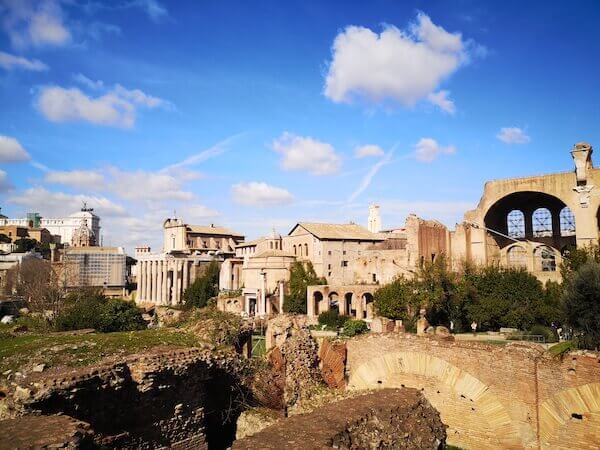
The Forum is now an open-air archaeological park and you can easily enjoy it even just as a place for a leisurely stroll.
If you go on a bright day, especially in the spring or the fall, the forum is simply breathtaking: you can easily walk to one side to the other in a matter of minutes and you can simply follow your curiosity picking and choosing the areas that attract you the most.
The most beautiful part of the Roman Forum is, for me, the walk up the Horti and the Palatine Hill. You will feel the steps in your legs but, once on top, you have the ruins of the palaces of emperors and views over Rome that are simply breathtaking!
The pine trees that are typical of the Rome landscape frame the Colosseum and the Forum below and give you a photo op like no other!
Is there a dress code for the Roman Forum?
There is no dress code for visiting the Roman Forum. Clothing rules such as no shorts or no strappy tops only apply to religious buildings and main basilicas such as St Peter but not to archaeological sites.
The only thing to keep in mind when visiting the Forum is practicality: good shoes are a must and weather appropriate clothing for the season of your visit will also be important.
You can find our tips on what to wear for the Roman Forum below.
How to visit the Roman forum: guided tour or self guided? 2021 Update
The Roman Forum is a place so full of history and thing to see it is best enjoyed with a guide.
The area has almost non existent info panels so without some form of guidance, you can enjoy its beauty but you won’t understand much.
The cheapest way to visit the Roman Forum is by getting standard tickets and downloading the Parco Colosseo app.
The app is free and has explanations in several languages about the main sights in the Roman Forum and on the Palatine Hill.
If you have a smart phone, this is an excellent option and it also has a recommended itinerary for kids and another one for the visually impaired.
If your budget allows, then I recommend you take one of the may Roman Forum tours available (see below)
How to get the best Roman forum tickets
You can buy tickets to the Roman Forum on the day or you can book them online here. If you do so, make sure you pick a solution that works for you: there are several combinations, offering access to different things.
The tickets include a visit to the Colosseum (all areas or just some parts depending on the ticket), the Roman Forum and the Palatine Hill, with the exception of some ‘super sites’ that you may need to book separatly.
Best Roman forum tours
Tours of the Roman Forum are bundled up with a visit to the Colosseum.
The best we have tried are:
- Priority Entrance to Colosseum, Forum and Palatine Hill with guide
- Colosseum (includes underground tier) and Roman Forum guided tour
- Walking tour of the Colosseum, Roman Forum and Palatine Hill (3 hours)
- Colosseum and Roman forum tour for kids (suitable for primary school kids too)
Need to know: the tours tend to give priority to a visit to the Colosseum, which usually takes up to 2/3 of the tour. If you are interested in a more specialized tour, then I recommend you get a private guide instead .
How long to visit the Roman Forum
It usually takes me between 2 and 3 hours to visit the Roman Forum and I would recommend to plan half a day if this is your first visit.
Technically, you can spend as little or as long as you wish here, however, I think within this time frame you can see some of the forum most impressive area, such as the temple of Antonino and Faustina, the House of the Vestals and the Horti and also the Palatine Hill.
What is the best time of day to visit the Roman Forum?
The best time of day to visit the Roman Forum depends on the season.
In spring and autumn, the best seasons to visit Rome, you can go pretty much any time of the day, with only one caveat: the late morning and lunch hours can get busy!
Aside from that, you don’t have particular constraints when it comes to weather and time of visit, in mid season. The situation changes if you are visiting in winter or summer.
In winter, the best time of the day to visit the Forum and the Palatine hill is the late morning / lunchtime.
The Forum and even more the Palatine can get really cold in winter and being there in the warmest hours of the day will go a long way to make you enjoy your visit.

Also, consider that in winter the Forum closes pretty early (about 4 pm) and darkness comes early too, so an earlier start is recommended.
In summer, it is the opposite!
The Roman Forum in summer gets scorching hot and must be avoided at lunchtime and in the hottest hours of the day at all costs.
The best time of day to visit the Roman Forum in summer is the early morning or the late afternoon (check the time of the last admission though, you want to make sure you have enough time).
What to wear to visit the Roman Forum
You do not need particular equipment to visit the Roman Forum, but it is worth knowing a couple of things:
The terrain in the Forum is uneven, so you are recommended to wear good walking shoes or sneakers: no heels. Find my recommended shoes for Rome sightseeing here.
There is very little shade in the forum so especially in the warmer season, it is important to wear a hat.
In winter, the Forum can get surprisingly cold and the Palatine Hill gets even colder: wrap up well and do go during the warmest hours of the day for the best experience or humidity may get to you and make your visit seriously unpleasant.
Is there food and facilities inside the Roman Forum?
The Roman Forum has some restrooms and drinking fountains but it is overall hardly equipped with food.
I highly recommend you take care of breakfast and lunch before you come: picnics are now allowed.
Is the Roman Forum accessible?
The Roman Forum is not entirely accessible but does have some defined paths for wheelchair users. You can find all the pupated information on the paths and lifts here
Visiting the Roman Forum with kids
We have brought the kids to the Roman Forum several times and it is always a good day out.
It is, however, a day that can pose some challenges, so it is good to be prepared.

These are the important things to know before visiting the Roman Forum with kids:
You can enter the Roman Forum with a stroller however, only part of the Forum is paved. If you can, I highly recommend you leave the stroller at home, especially if also visiting the Colosseum (find my tips for visiting the Colosseum with kids here).
Kids will be tempted to climb on top of the ruins but this is not allowed. There is however a good playground close to the Colosseum , which you can easily reach after your visit and works well as a bribe!
There is no food inside the Forum and picnics are not allowed. However, it is ok to hand out a snack to a child so if you have small food for them, that’s ok.
If you ate visiting Rome with kids, do not forget to also check out our favorite things to do in Rome with kids here .
Top tip: the free app ‘Parco Colosseo’ includes a kid-friendly itinerary!
Should you visit the Roman Forum and the Colosseum on the same day?
The Roman Forum and Palatine hill are just beside the Colosseum and you can visit both in the same day.
A short visit to the Colosseum can take as little as 45 minutes and the Forum is only a minute across the road. Here, you can spend an hour, four or even a day.
I recommend you schedule at least three hours for a quick Forum visit, a full afternoon for a proper one.
How to get to the Roman Forum
You can get to the Roman Forum by metro, bus, tram or one foot.
- The closest metro station is ‘Colosseo’
- All buses serving the Colosseum serve the forum too, as well as those serving Piazza Venezia.
- Tram number 3 stops nearby
- The Roman Forum is walking distance from Piazza Venezia, Colosseum and the Pantheon
Where to get the best Roman Forum views?
The Roman Forum is a powerful site and there are some amazing photo locations to capture its might, some inside the Forum itself, and some outside!
One of the best views is from the Horti, inside the Forum, on the way up to the Palatine Hill. From here, you see the Forum and also the Colosseum.

Another stunning view over the Roman Forum is from the back of the Campidoglio Hill. This view is free and easily accessible walking up the Campidoglio and going to the back of the main budding. The Roman Forum will be at your feet!
So, is a visit to the Forum worth it?
Yes, I believe a visit to the Roman Forum is worth it and not just for history lovers. The beauty of the place itself a reason for visiting, especially in spring and autumn.
I hope you enjoyed this practical guide to visiting the Roman Forum. Happy travel planning!
My name is Marta, I am a travel-loving mama born and bred in that messy, wonderful, infuriating, awe-inspiring unbelievably beautiful city that is Rome. A classics graduate and professional travel blogger, on this site I share my insider tips to help you plan your dream trip to Rome, Italy.
What to wear in Rome in October: packing list and tips from a local
Movies set in rome that will make you feel like you are in rome right now, you may also like, how to see rome in two days: perfect..., fun and interesting facts about the colosseum for..., christmas markets in rome you will love this..., how to see the best of rome in..., free things to do in rome you’ll love..., how to buy tickets for the pantheon +..., how to visit the spanish steps in rome:..., largo di torre argentina: all you need to..., 40+ rome hidden gems you’ll love, outdoor swimming pools in rome you’ll love this..., privacy overview.

- Top Attractions
- Tourist Attractions
Roman Forum
Located between Piazza Venezia and the Colosseum, the Roman Forum was the hub of political and social activity of the Roman citizens.
The Roman Forum was where religious and public life in ancient Rome took place . The Forum is, along with the Colosseum , the greatest sign of the splendor of the Roman Empire that can be seen today.
After the fall of the Empire, the Roman Forum was forgotten and little by little it was buried under the earth. Although in the 16th century, the existence and location of the Forum were already known, it was not until the 20th century that excavations were carried out.
Interestingly, the place where the Forum was built was originally a marshy area. In the 6th century B.C., the area was drained by means of the Cloaca Maxima , one of the first sewer systems in the world.
Points of interest
Besides the great number of temples that are in the forum (Saturn, Venus, Romulus, Vesta, etc.), it's worth paying special attention to the following points of interest:
- Via Sacra : This was the main street in ancient Rome that linked the Piazza del Campidoglio with the Colosseum.
- Arch of Titus : This is a triumphal arch that commemorates Rome's victory over Jerusalem. It was built after the death of the emperor Titus.
- Arch of Septimius Severus : An arch erected in the year 203 A.D. to commemorate the third anniversary of Septimius Severus as the emperor.
- Temple of Antoninus and Faustina : Built in the second century, the Temple of Antoninus and Faustina sets itself apart as the best-preserved temple in the Roman Forum.
- Basilica of Maxentius and Constantine : Though now mostly destroyed, its size suggests that this was one of the most important buildings of the Roman Forum.
- The Curia : In this building, the Senate met to make administrative decisions about the Roman government.
- Column of Phocas : Erected in the year 608 A.D. in honor of the emperor of Byzantium, this column, which is over 13 meters high, is one of the few that have remained standing since being built.
Visiting Rome without walking around the Forum is like going to Paris without seeing the Eiffel Tower. As you travel along the Via Sacra, close your eyes and imagine it as it was more than 20 centuries ago, when Julius Caesar walked there .
The best way to skip the line and get to know the Forum in detail is to take a guided tour . We'll visit three of the main monuments in the city, the Colosseum, Roman Forum, and Palatine Hill, skipping the line, and all with an expert guide.
If you prefer to discover it on your own, we recommend that you head first thing in the morning, as this is when people head to visit the Vatican . You can also skip the lines with the Rome Pass discount card.
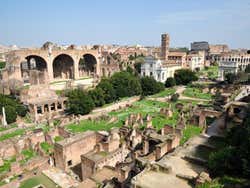
Between the Colosseum and Piazza del Campidoglio .
Every day: 8:30 am until 7 pm 25 December and 1 January: closed
Combined ticket to visit the Colosseum, the Roman Forum and the Palatine : Adults: € 16 ( US$ 17.20) European Union members (18 – 24): € 2 ( US$ 2.20) Children (ages less than 17) and seniors (over 65) members of the EU: free entrance
Colosseum, Roman Forum & Palatine Hill Tour € 62.64 ( US$ 67.40)
Metro : Colosseo , line B (blue).
Nearby places
Piazza del Campidoglio (335 m) Capitoline Museums (348 m) Arch of Constantine (407 m) Santa Maria in Aracoeli (412 m) Palatine Hill (424 m)
You may also be interested in
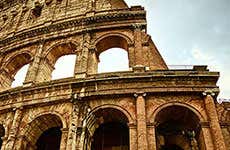
Known as the Flavian Amphitheatre, the Roman Colosseum is one of the capital's most remarkable monuments. Every year over 6 million people visit it.
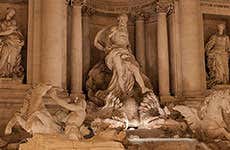
Trevi Fountain
Have you been told to throw a coin into the Fontana di Trevi? Learn the myth behind this tradition and learn about its history.
A Visit to the Forum in Rome
History of the Roman Forum and How to See It
TripSavvy / Taylor McIntyre
The Roman Forum (also known as the Foro Romano in Italian, or just the Forum) is one of the Top Ancient Sites in Rome as well as one of the Top Rome Attractions for visitors. Occupying a sprawling space between the Colosseum, the Capitoline Hill, and the storied Palatine Hill, the Forum was the center of political, religious, and commercial life of ancient Rome and provides insight into the splendor that once was the Roman Empire. The Via dei Fori Imperiali , a wide boulevard built during the reign of Mussolini in the early 20th century, forms the eastern edge of the Forum.
Roman Forum Visitor Information
Hours: Daily 8:30 am to one hour before sunset; closed January 1, May 1, and December 25.
Location: Via della Salaria Vecchia, 5/6. Metro Colosseo stop (Linea B)
Admission: Current ticket price is €12 and includes admission to the Colosseum and Palatine Hill. you can avoid the ticket line by buying Colosseum and Roman Forum tickets in advance.
Information: Check current hours and prices online or buy tickets online in euro with booking fee.
You can also visit the Roman Forum using the Roma Pass , a cumulative ticket that provides free or reduced rates for more than 40 attractions and includes free transportation on Rome's buses, subway, and trams.
The Forum contains many ancient buildings , monuments, and ruins. You can pick up a plan of the Forum at the entrance or from any number of kiosks throughout Rome.
Roman Forum History
Building in the Forum dates back to as early as the 7th century B.C. On the northern end of the Forum near the Capitoline Hill are some of the oldest ruins of the Forum including marble remnants from the Basilica Aemilia (note that a basilica in Roman times was a site of business and money lending); the Curia, where Roman senators assembled; and the Rostra, a platform on which early orators gave speeches, were built in the 5th century B.C.
By the 1st century B.C., when Rome began its reign over the Mediterranean and large swaths of Europe, numerous constructions went up in the Forum. The Temple of Saturn and the Tabularium, the state archives (today accessible via the Capitoline Museums ), were both built around 78 B.C. Julius Caesar began building the Basilica Julia, meant to be a law court, in 54 B.C.
A pattern of construction and destruction went on in the Forum for hundreds of years, starting in 27 B.C. with Rome's first emperor, Augustus, and lasting through the 4th century A.D., when the Western Roman Empire was conquered by the Ostrogoths. After this time, the Forum fell into disrepair and almost total obscurity. For the hundreds of years following the Sack of Rome, the Forum was used largely as a quarry for other constructions around Rome, including the walls of the Vatican and many of Rome's churches. It was not until the late 18th century that the world rediscovered the Roman Forum and began to excavate its buildings and monuments in a scientific manner. Even today, archeologists in Rome continue excavations in the Forum hoping to uncover another priceless fragment from antiquity.
Essential Ancient Sites to Visit in Rome
Buying Tickets for the Colosseum in Rome
The 25 Top Attractions in Rome, Italy
Top 6 Tourist Attractions in Italy
What to See in the Roman Forum
Your Trip to Rome: The Complete Guide
What to Know About Visiting the Roman Colosseum
The 14 Best Day Trips from Rome
10 Unique Guided Tours in Rome
3 Days in Rome: What to See and Do
Rome's Palatine Hill: The Complete Guide
8 Best Things to Do in Vatican City
The Top 23 Things to Do in Italy
Where to Go in Rome to Take the Best Photos
Roman Amphitheaters in Italy
10 Top Things to Do in Rome's Monti Neighborhood
Italy Trip Planning
Italy Travel Tips
North Italy Guides
South Italy Guides
Your complete guide to visiting the Roman Forum + FAQ

Last Updated on April 8, 2024 by Ingrid & Alex
No matter how long you are spending in Rome, if you are here for the first time, visiting the Roman Forum should definitely be on your bucket list . Set right next to the famous Colosseum , the Forum used to be the heart of the city and can tell you the whole story of Ancient Rome.
In today’s post, you will not only find lots of practical information, but we will also cover a short history for each and every one of the buildings you will get to see on your tour.
Because at the end of the day, they all tell a story waiting to be heard.
This post contains affiliate links. This means if you click on the link and purchase the item, I will receive an affiliate commission at no additional cost to you. Read more about it on our disclosure page here .

Table of Contents
Your complete guide to visiting the Roman Forum
What is the roman forum.
As a modern-day visitor of Rome, you’ll soon realize that many places are called a “forum.” So the first thing you might ask yourself is, which exactly is the “ Roman Forum “? Why is this place so special? The short answer: because it is the most glorious meeting place in human history.
Political elections, public speeches, criminal trials, triumphal processions, gladiatorial matches, business negotiations…everything happened in the Forum! The Roman Forum was the heart of Rome, while Rome became the capital of the Mediterranean world (or THE WORLD, as they called it)!
To use a modern U.S. analogy, it was as if the White House, the Congress, the Supreme Court, Wall Street, Hollywood, and Silicon Valley would all set up shop in a tiny square in the center of Washington, D.C, in view of all the citizens gathered there.
Think of this when you visit the place: you are following in the footsteps of some of the most iconic people in the history of mankind. Mass murderers and Christian saints, famous orators and infamous demagogues, great philosophers and delirious madmen, business magnates and unscrupulous charlatans, all of them operated in the Forum Romanum during their days.
But how did this piece of land become the center of human civilization?
A short history of the Roman Forum : Roman Forum Facts
When was the roman forum built.
Picture a landscape of wooded hills skirted by the river Tiber some seven hundred and fifty years before Christ was born. The twins Romulus and Remus just founded a small settlement on one of the hills. But the inhabitants of the new “city” of Rome had a rather important problem: there were no women among them.
Long story short, using deception, the Romans kidnapped the sisters, daughters, mothers, and wives of a neighboring tribe called the Sabines. Understandably, the Sabine men were not happy, so they stormed Romulus’ settlement. It fell on the Sabine woman to find a solution and stop the bloodshed; they came out imploring their men to make peace with their captors and live in harmony within one kingdom. Thus, the Roman Kingdom was born, co-ruled by Romulus of the Romans and the Sabine leader, Titus Tatius.
It was not much of a kingdom, to begin with. Basically, it was a pair of hilltop villages separated by grassy wetland: one on the Palatine hill and the other on the Capitoline.
To encourage friendly relations, the two people decided to drain the marsh separating them. They built the Cloaca Maxima, a covered sewage system, clearing away the water. The newly reclaimed land was used as a meeting place for trade, political debate, trials, and mass entertainment. Ecce Forum Romanum! Behold the Roman Forum!

Who built the Roman Forum?
No single person or group of people built it. Instead, the place developed organically during its one thousand and two hundred years of active existence. New buildings were erected, while some of the older ones were periodically renovated and rebuilt. Just take a break and contemplate this for a moment: the place was continuously used for 1200 years while the oldest structure still in use in North America was built less than 400 years ago.
The Forum’s travertine paving, still visible today, dates from the reign of the first Roman Emperor, Octavian Augustus (27 B.C – 14 A.D.). However, some of the buildings are much older, dating from the early days of Rome (VII. century B.C.); others were erected as late as the IV. century A.D.
So what exactly can a modern visitor see today?
Roman Forum Buildings – what to see inside the Roman Forum
Most tourists approach the Forum after they visit the Colosseum, so I will follow this route in our virtual tour; we will travel along the Via Sacra , or Sacred Avenue, leading from the Colosseum to the east up to the Capitoline hill to the west.
It was customary to build triumphal arches celebrating major military victories – the triumphant general and his soldiers were permitted to march through the arch in the ovation of the gathered citizens. There are no fewer than three of these monuments in the area of the Forum; the first one you’ll encounter is the one bearing the name of Constantine the Great.

The Arch of Constantine is the largest triumphal arch built in Rome, and it’s symbolic of probably one of the most consequential events in human history, one that shapes the world to this day.
It was erected by order of the Senate on the Via Triumphalis , the Avenue of Victory, to celebrate Constantine’s triumph over Maxentius in 312 A.D. and the ascent of Rome’s first Christian Emperor. If Constantine had lost that key battle, probably Christianity would never have become the dominant religion of the Western World.
Interestingly, although the structure was finalized in 315 A.D., most of the statues decorating it were “re-used” from much earlier monuments dedicated to Emperors Trajan, Hadrian, and Marcus Aurelius.
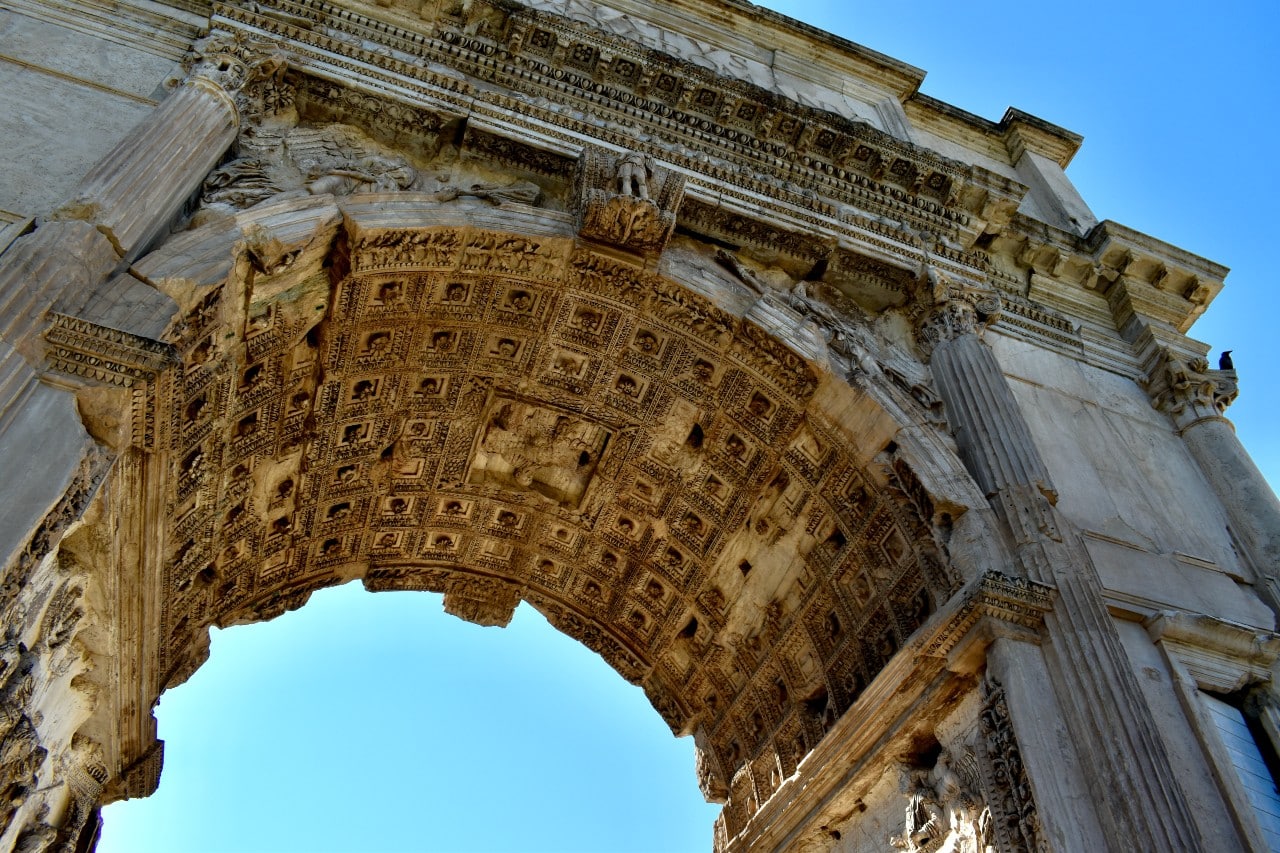
The next monument you will encounter is the Arch of Titus; it has a powerful religious symbolism for the Jewish community, the same as the Arch of Constantine has for the Christians.
Emperor Domitian erected the building to celebrate his father’s (Emperor Vespasian) and his brother’s (Emperor Titus) victory over the Jews in 70 A.D. The Jewish revolt ended in a massacre, Titus’ legions sacking Jerusalem and destroying the Second Temple, the holiest place of Judaism. The arch depicts several artifacts looted from the Temple, including the Menorah; its representation on the arch served as a model for the menorah used on the emblem of the State of Israel.
Let’s pause here for a moment to “look around.”
On your left, while facing the Arch of Titus, you’ll see the Palatine hill, the place of the original settlement founded by Romulus and Remus. The area was a wealthy neighborhood during Republican times, and later it became the residence of Emperors, several palaces being built by them. The very word “palace” has its roots in the name of the Palatine hill.
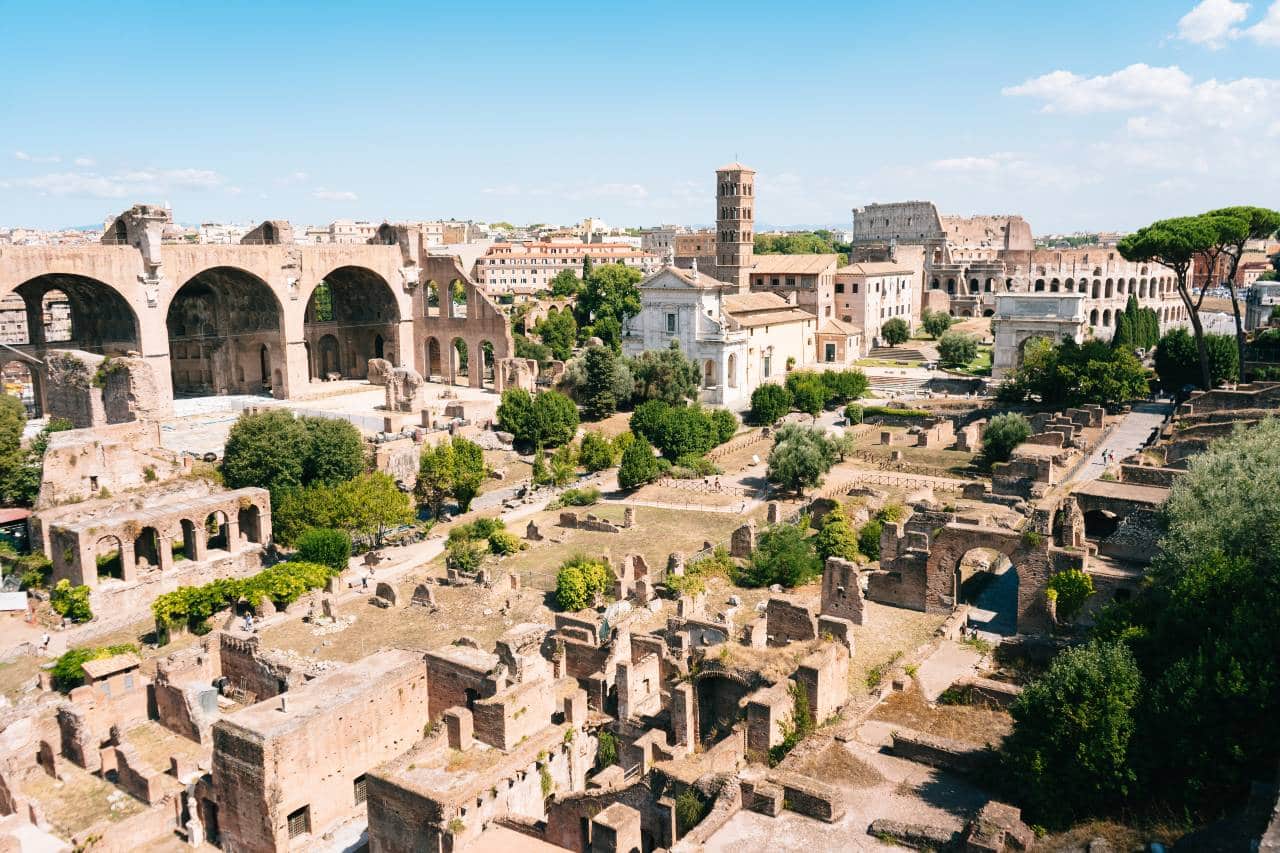
On your immediate right, you’ll see the Temple of Venus and Roma , one of the largest temples of the Classical World. It was built on the orders of Emperor Hadrian (117 A.D. – 138 A.D.), the finishing touches done by his successor, Emperor Antoninus Pius (138 A.D. – 161 A.D.).
The temple was restored by Emperor Maxentius (306 A.D. – 312 A.D.) after a fire destroyed it. Although he is remembered as Saint Constantine’s arch-enemy (see above), to Maxentius goes the honor of erecting the last major building in the millennium-long history of the Roman Forum: the Basilica bearing his name.
Built next to the Temple of Venus and Roma in 312 A.D., the Basilica of Maxentius is the largest building in the Forum. Roman basilicas had various functions; they acted as council chambers, courtrooms, and meeting halls for official gatherings. They also served as models for the future Christian places of worship, Saint Peter’s Basilica from the Vatican being just one example.

Let’s continue our journey down Sacred Avenue and approach the Temple of Vesta and the House of the Vestal Virgins. It is probably the oldest building complex in the Forum, its history going back seven hundred years before the birth of Christ to the days of the early Roman Kingdom.
The Vestals were a group of virgin priestesses serving the goddess of the hearth called Vesta. The number of Vestal Virgins grew from two during the time of King Numa Pompilius to six. The future Vestals were selected by lots from prepubescent girls volunteered by their free-born Roman citizen parents. It was a great honor to be chosen as Vestal Virgin; however, it came with a steep price.
The priestesses committed to thirty years of celibacy under the pain of death. As soon as they were selected, they had to leave their parents’ house and move to the House of the Vestals, where they would reside for the period of their service. The main duty of the Vestals was to tend the sacred fire in the Temple; the Romans believed that the city’s fortunes were linked to the fire – if it would ever go out, disaster would befall Rome.
Can you imagine tending the same fire for thirty years while living in isolation without any romantic involvement? And I haven’t even mentioned the punishment for breaking your vows: to be buried alive and left to rot. Yet, here you were, thinking your job sucks.

Just north of the ruins of the Temple of Vesta, you’ll see the Temple of Romulus. The building symbolizes how the new Christian world overtook the ancient Classical one.
Initially dedicated by Emperor Maxentius as a Temple to his deceased son, Valerius Romulus, it was transformed into a Christian church in 527 A.D. by orders of the “barbarian” king, Theodoric the Great of the Ostrogoths. To this day, the basilica of Santi Cosmo e Damiano functions in this building.

Further down the Via Sacra, you’ll encounter the Temple of Antoninus and Faustina, which guards the entrance of the actual Forum. It was erected by “the Fourth Good Emperor,” Antoninus Pius, in memory of his deceased wife Faustina – as such, it is the first monument in the Forum dedicated to an Empress.
Later, the building was transformed into a Christian church dedicated to Saint Lawrence as he was sentenced to martyrdom in this place.
Next, you’ll encounter the Temple of Divus Julius, also called the Temple of Caesar. I personally find this building extremely intriguing, not only for its architecture but for what it stands for.
Even by Roman standards, Julius Caesar was a genocidal mass murderer, a populist demagogue turned into a power-hungry tyrant and an unashamed adulterer. Still, after his adopted son Octavian consolidated his power as the First Roman Emperor, he deified his adoptive father and erected a temple in his honor in the middle of the Forum.
So, this temple is a monument to propaganda, if you will; a reminder that history was always “written” (and re-written) by the victors.

Immediately to the south, one can see the ruins of the Temple of Castor and Pollux. The original building was raised to celebrate a major victory of the early Republic.
In 509 B.C., two hundred and forty-four years after the founding of the city, a popular revolt led by Lucius Junius Brutus overthrew the last king of Rome, one Tarquinius Superbus (the Proud). Unwilling to accept defeat, Tarquinius plotted his return, gathering allies in the process. Eventually, his Latin League declared war on the fledgling Roman Republic, confident in an easy victory.
However, the Romans organized themselves under their temporary dictator, Postumius Albus, and defeated Tarquinius at the Battle of Lake Regius in 496 B.C. According to the legend, the twin sons of Jupiter (Zeus in Greek), Castor and Pollux, fought beside the Romans; in their honor, Albus’ son built the Temple bearing their names in 484 B.C.
To the north of the Temple of Caesar, you’ll see the ruins of Basilica Aemilia . The initial building served as the butchers’ shop, but it was replaced by the bankers’ offices in the IV. century B.C.; in a way, it was the Wall Street of Ancient Rome. Since then, it was repeatedly redesigned and rebuilt under different names: Fulvia, Aemilia, Paulii.
The building survived the Empire by four hundred years but was eventually destroyed in 847 A.D. by an earthquake. Its remains were later excavated, and the stones and marble was used to build medieval edifices, the Pallazo Giraud Torlonia among them.
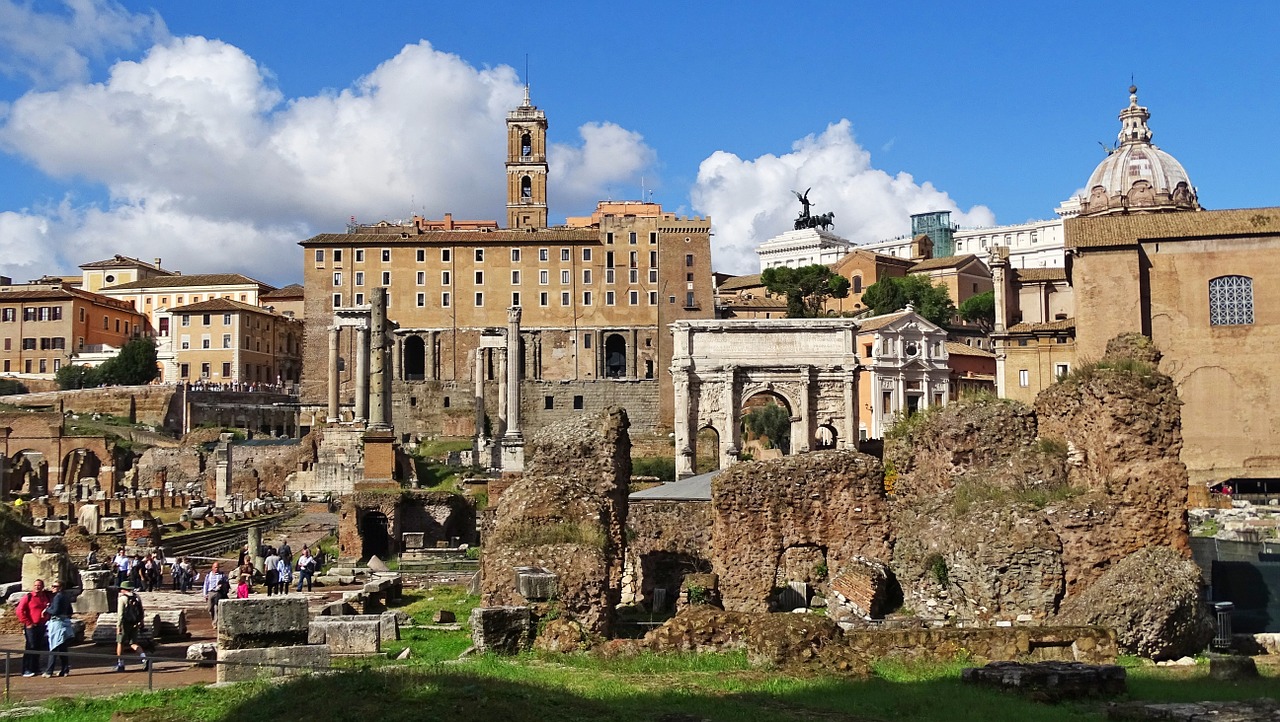
Finally, you have arrived at the actual Piazza of the Forum , the place where everything began. As explained above, the Forum was initially designed as a marketplace and meeting place. The piazza retained this function over the centuries.
On the western side of it was the Rostra , the stage from which politicians and generals, demagogues and orators, addressed the citizens. Its name comes from the warship rams (rostra) captured during the epic battle of the Latin War, the Battle of Antium (338 B.C.).
The Roman victory was extremely important for it extended Rome’s overlordship over its neighbors, the Latins, and brought it closer to the unification of the Italian peninsula. To celebrate the triumph at Antium, the Romans mounted the captured rams of the enemy warships as trophies on the speaker’s platform in the Forum, hence the name Rostra.

In front of the Rostra, Emperor Septimius Severus erected the Arch of Septimius in 203 A.D., celebrating his victories over the Parthians. The rise and reign of Emperor Septimius Severus provide the backdrop of my book series, Agent Strabo’s Ancient Mysteries , as my well-informed readers surely remember.
Behind the Rostra, the modern visitor can see the well-preserved building of the Tabularium. Erected in 98 B.C. by the dictator Sulla, the Tabularium stands on the front slope of the Capitoline hill and below what was the Temple of Jupiter Optimus Maximus (Jupiter the Best and Greatest – father of the gods, the Roman iteration of the Greek Zeus).
Although there is an ongoing debate in academic circles regarding its function, it is believed that the Tabularium housed the Roman records office. Alas, we have the Romans to thank for the government keeping records of everything we do: contracts, inheritance, tax receipts….

Next to the Rostra, one can see one of the most iconic buildings of the modern archeological site: the Temple of Saturn . It stands at the foot of the Capitoline hill, and although its construction began under the last king, the building was finalized in 497 B.C., making it the first Temple of the Republican era. The currently visible ruins date from a later reconstruction of the temple in 360 A.D.
On the northern side of the Piazza, you can see the Curia Julia, the meeting place of the Senate of Rome since the times of Julius Caesar. He built it in 44 B.C. to replace the previous Curia Cornelia, which in turn replaced the initial Curia Hostilia. It was the equivalent of the U.S. Congress building at Capitol Hill, Washington D.C., with the mention that the Consuls (i.e., the President) were presiding the Senate, hence the Curia Julia was Congress and White House combined. The decisions taken in this building shook the world more than once.
To avoid any confusion: although the Capitol Hill of the U.S. is called after the Capitoline Hill, beginning on the western side of the Roman Forum just behind the Temple of Saturn, the Roman Capitoline hosted the religious center of Rome, not the political one. The Senate met in the Forum while the later Emperors resided on the Palatine hill, just south of the Forum complex (see above).
On the southern side of the Piazza, opposite the Curia Julia, you can see the remains of the Julia Basilica. As its names hints, the latest redesign was done by Julius Caesar in 54 B.C. and later reconstructed by Emperors Octavian August (in 12 A.D.), Septimius Severus (in 199 A.D.), and Diocletianus (in 283 A.D.). However, before Caesar demolished it to make room for his own basilica, the Basilica Sempronia stood in its place (built 169 B.C), which in turn was built over the house of the Roman hero and legendary general Scipio Africanus.
The main function of the Julia Basilica was to house the civil law courts; in a way, it was the Supreme Court of Rome. The impressive building also housed several governmental offices and even some taberanae (a kind of ancient fast food store); even judges and civil servants needed to eat.
I haven’t mentioned other ruins and monuments in and around the Forum Romanum, but I wouldn’t like to overwhelm you with even more information.
During your visit, I would like you to remember that the place is more than just a hodge-podge of old rocks. Put yourself in the shoes of a visitor from the future walking down the ruins of Washington D.C. or New York because this is exactly what you are from a Roman perspective: a visitor from the distant future walking down the epicenter of the Roman civilization.
You are stepping on the same stones as millions of Romans did, from humble plebs to all-powerful Emperors.
In and around a tiny rectangle of 420 by 160 feet, you can absorb the very essence of the Roman world: you are standing at its political, religious, cultural, entertainment, and economic center. If the Greeks initiated the Western Civilization, the Romans carried it to term. In many ways, the Roman Forum is the birthplace of the Euro – American civilization of today.
And you are standing right in the middle of it.
Where is the Roman Forum located and how to get there?
Located in the heart of Rome, steps away from the Colosseum, you can find the Roman Forum at Via della Salara Vecchia, 5/6, 00186 Roma RM, Italy.
The easiest way to get there is by subway or bus – get off at the Colosseo stop.
A hop on hop off bus will also leave you in front of the Colosseum and is worth taking when you want to see as much as possible in a short time, without having to worry about means of transportation, tickets, and other similar things. Get your ticket here!
Distance from other main attractions in Rome :
2 minutes away from the Colosseum
30 minutes away from the Vatican City by public transportation (Cipro or Valle Aurelia on the orange subway line)
20 minutes walk from Fontana di Trevi, the Pantheon or Piazza Navona
35 minutes walk from Piazza del Popolo
Opening Hours for visiting the Roman Forum
The Roman Forum is open daily from 8:30 AM to 7 PM.
However, you won’t be able to visit on the 25th of December and the 1st of January.
Ticket prices for visiting the Roman Forum
The prices for a ticket are as follows:
12 EUR for adults
7,50 EUR for EU-citizens aged 18 to 25 years
free entrance for teenagers under 18 and disabled persons, as well as their assistants
A great option that could include the ticket for visiting the Roman Forum is the Roma Pass . It includes unlimited public transportation and on top of that, the pass offers free access to two venues of your choice (one when you choose the 48-hour option), making it a cost-efficient option to look at. Get your pass here!
The Vatican & Rome City Pass is another option for when you are spending more time in Rome and wish to see as much as possible. This one has a higher price tag but you will get unlimited public transportation, along with skip the line with free admission to the Colosseum AND the Roman Forum, the Vatican Museums, and Michelangelo’s miraculous ceiling at the Sistine Chapel. Get the pass here!
Tours of the Roman Forum
If you don’t know what tour to choose, but you want to have a guide tell you all you need to know about the Roman Forum, here are 2 great options:
3-hour Guided Tour to the Colosseum and the Roman Forum
Colosseum, Roman Forum, Palatine Hill & Mamertine Prison Guided Tour
Where to stay close to the Roman Forum
Staying anywhere close to the Colosseum will place you in close vicinity to the Roman Forum as well. So why not choose a room with a view if you can?
Here are 3 options to consider:
Palm Suites – Small Luxury Hotels of the World – stunning interior design, city views, walking distance from both the Colosseum and the Roman Forum, the hotel has also a charming interior garden where you can enjoy your breakfast. See availability here!
47Luxury Suites – Colosseo is a deluxe apartment perfect for larger groups since it can accommodate up to 8 people. The view you get from here is incredible and you will want to book it today! Check it out here!
B&B First Floor – you couldn’t ask for a better location than this, directly next to the Colosseum. Rooms have a coffee machine and a great modern design. See more here!
Other Rome travel resources
One day in Rome itinerary
Visiting the Colosseum – a complete and easy guide: tips, tricks + FAQ
Rome and Amalfi Coast itinerary – a perfect 10 day itinerary
Your perfect 2 days in Rome itinerary
PIN FOR LATER!
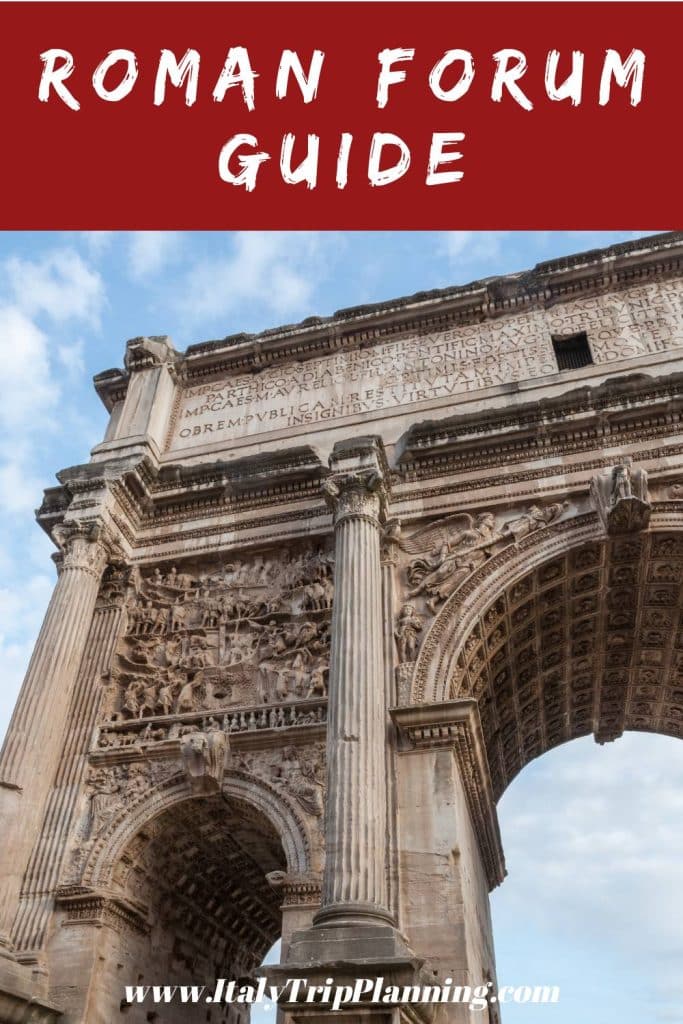
4 responses to “Your complete guide to visiting the Roman Forum + FAQ”
[…] Link together the Colosseum with the Roman Forum. […]
[…] is complete without seeing its famous attractions, from the Colosseum to the Spanish Steps and the Roman Forum. Stop by the Vatican City and treat yourself to a generous serving of […]
[…] my comprehensive guide for visiting the Roman Forum or the […]
[…] Read also: Your complete guide to visiting the Roman Forum + FAQ […]
Leave a Reply Cancel reply
You must be logged in to post a comment.
- Rome Attractions
- Roman Forum
- Plan Your Visit
- Guided Tours
- Vatican Museums
- St. Peter's Basilica
- Castel Sant Angelo
- Rome Pantheon
- Borghese Gallery
- Roman Catacombs Tour
- Bioparco Rome
- Big Bus Rome Hop-On Hop-Off Tickets
- Palazzo Barberini
- Musei Capitolini
- Leonardo da Vinci Museum
- Trevi Fountain Tours
- Roman Baths of Caracalla
- Palazzo Merulana
- Altare della Patria
- Rome Underground Tours
- Mamertine Prison
- Santa Maria Maggiore Basilica
- Walking Tours
- Hop-On Hop-Off Tours
- Bikes & Segway
- Sightseeing Cruises
- Travel Guide
- Things to do
- Trip Planner
- Travel Tips
Expert Tips on Planning the Perfect Visit to the Roman Forum
Roman forum | visitor information at a glance.
- What are the Roman Forum opening hours? The Roman Forum hours are generally from 9 AM onwards, although the closing time depends on the time of year. Please check the timings while booking to get accurate information. Last entry is an hour before closing time.
- Where is the Roman Forum located? The Roman Forum is located in the heart of Rome, Italy. The adddress is Via della Salara Vecchia, 5/6, 00186 Roma RM, Italy. View on maps.
- How many entrances does the Roman Forum have? There are two main entrances to the Roman Forum: Via die Fori Imperiali and Via della Salara Vecchia. Additionally, there is the Palatine Hill entrance Via die San Gregorio.
- How many visitors does the Roman Forum see per year? Each year, the Roman Forum has approximately 3.5 millions visitors from all over the world to marvel at its monuments.
What are the Roman Forum Opening Hours?
27 March to 31 August 2023: 9 AM-7:15 PM. 1 October to 30 October: 9:30 AM-6:30 PM 31 October to 26 March: 9:30 AM-4:30 PM.
Last Entry: One hour before closing.
Closure: The Roman Forum is closed on December 25 and January 1.
NOTE: According to the month and season of the year, the Roman Forum extends or reduces its opening hours. Check the updated timings before making your visit.
What's The Best time to Visit the Roman Forum?
The best time to visit the Roman Forum is on weekdays during the shoulder seasons of spring (April to early June) and autumn (September to October). Weekdays generally offer fewer crowds compared to weekends, allowing for a more immersive experience. Arriving early in the morning when the gates open is ideal, as the site is quieter and the weather is pleasant.
During the high tourist season, from late spring to early autumn, weekends can get particularly busy, with larger crowds and longer wait times. For optimal conditions, consider visiting the Roman Forum on a weekday morning during the shoulder seasons. This timing strikes a balance between manageable crowds and comfortable weather, ensuring an enriching exploration of this ancient historical treasure.
Where is the Roman Forum Located?
Address: Via della Salara Vecchia, 5/6, 00186 Roma RM, Italy.
Find on maps.
The Roman Forum occupies a pivotal position in Rome, nestled between the Colosseum and Palatine Hill . Adjacent to the Colosseum, the Roman Forum extends along the valley between the Palatine and Capitoline Hills.
Closest Landmark: The Colosseum , 40m away.
Getting to the Roman Forum
By public transportation.
By Metro: Board the B line Metro from Roma Termini, Rome’s central station. From there, ride 10 minutes and disembark at the Colosseo stop. From there, the Roman Forum is less than 5 minutes away by walk.
By Bus: From the bus station outside Roma Termini, take the 64 or 75 bus that’s heading towards. Poerio/Mirandola. Get off at the Fori Imperiali/Campidoglio stop and walk to the Roman Forum.
By Tram: Trams 3 and 8 stop at Piazza del Colosseo, which is the closest stop to the Roman Forum. From there, the attraction is just 2 minutes away by walk.
If you’re driving, take the route Via Cavour which is the shortest. If you do choose to arrive Via Nazionale, be prepared for the tolls you might encounter en route.
Parking Facilities
Once you arrive at the Roman Forum, there are convenient paid parking options available nearby:
- Leave your car at Park Services Colosseum , a 24-hour parking space, a 7-minute walk from the Roman Forum.
- There are also garages nearby like the Roma Parcheggio Parking and Via Ostilia, 48 Garage , both of which are an 8-minute walk away.
Know Before You Go To the Roman Forum
There are two main entrances to the Roman Forum:
- Via die Fori Imperiali: This is the main entrance along the Via die Fori Imperiali road between the Colosseum and Piazza Venezia.
- Via della Salara Vecchia: This is the other entrance that runs parallel to Via die Fori Imperiali.
- You can also enter the Roman Forum through Palatine Hill Via die San Gregorio , which is usually the least crowded entrance.
- Drinking fountains
While there is an elevator at the entrance that takes you down to the ruins, only about 20% of the Roman Forum is wheelchair accessible upon descent. As it is an ancient structure, many places have large gaps between the stones, making it difficult for wheels to pass over. Hence, the Roman Forum is not the most wheelchair-friendly tourist destination in Rome.
- If you are travelling with babies, it is best to carry them on a sling or carrier as stroller rides can get bumpy due to the uneven terrain.
- With young children, the Forum is best visited first thing in the morning or just before closing time (especially in summer), when the temperatures are likely to be more pleasant.
- Do carry a water bottle and some snacks are there are no eateries inside the Roman Forum.
- Children are also encouraged to use sun block, wear a hat and comfortable shoes.
- Booking online is highly recommended as you can grab the best deals.
- Arriving at the Roman Forum via the Palatine Hill entrance can help you beat some of the entry traffic.
- Wear comfortable shoes to make your experience hassle-free and enjoyable.
- Opt for guided tours to understand the attraction better and grasp its significance in full. In summer, carry sunscreen and a hat.
- Buy combo tickets that also grant you access to the Palatine Hill and the Colosseum .
- While clicking pictures inside the Roman Forum is allowed, tripods are not permitted for use inside the ruins.
- Carry a water bottle and some light snacks to keep your energy up, especially if you’re visiting in summer. However, dispose your trash appropriately as littering will not be tolerated.
- Trattoria Luzzi: This restaurant is a good option to enjoy pizza and Italian fare. Trattoria Luzzi is open every day from 12 PM to 12 AM. It is just a 7-minute walk away from the Roman Forum.
- La Taverna dei Quaranta: To tuck into hearty Roman fare and authentic pizzas, look no further than this La Taverna dei Quaranta . This restaurant is 5 minutes by walk from the Roman Forum.
- TreCaffe Bistro: Slightly further away and a 16 minute walk from the Forum is the charming cafe that’s perfect for your caffeine fix.
Palazzo Montemartini , 2.2 km away from the Roman Forum
Hotel Capo d’Africa , 550m away from the Roman Forum by walk
Hotel Centro Cavour , 600m from the attraction on foot
- Basilica di Santa Maria Maggiore: This magnificent basilica showcases intricate mosaics and Byzantine art.
- Jewish Ghetto: One of the free things you can do in Rome , visit the charming district with Jewish heritage. It features traditional eateries, synagogues, and a glimpse into Rome's multicultural history.
- Circus Maximus: Ancient chariot racing stadium, Circus Maximus offers a vast open space to imagine ancient spectacles and enjoy a leisurely stroll.
- Arch of Constantine: Monumental triumphal arch commemorating Emperor Constantine's victory, adorned with intricate reliefs, a testament to Roman artistry.
Frequently Asked Questions About Visiting the Roman Forum
The Roman Forum generally opens around 9 AM and closes by 7:15 PM. But these timings can vary according to the time of year. Check here for detailed information on Roman Forum hours .
The Roman Forum is usually less busy on weekday mornings. Going late in the afternoon also helps avoid the visitor surge. Peak season (April to August) has longer wait times and is busier.
To get a good understanding of the Roman Forum, it is recommended that visitors spend at least an hour inside the attraction. However, if you want to explore in depth, 2-3 hours can give you comprehensive insights into these ruins.
No, once you leave the Roman Forum, you cannot revisit the attraction with the same ticket.
Located in Rome’s city centre, the Roman Forum address is Via della Salara Vecchia, 5/6, 00186 Roma RM, Italy.
Using public transport to visit the Roman Forum is strongly suggested. Take the 64 or 75 bus from the Roma Termini station and get down at the Fori Imperiali/Campidoglio stop, which is a 100-odd metres from the Roman Forum. Alternatively, take the B line Metro from Roma Termini and disembark at the Colosseo stop, which is 2 minutes away from the Roman Forum on foot. Trams 3 and 8 also stop near the Roman Forum. If you choose to drive, there are paid parking spaces available near the Roman Forum like Park Services Colosseum and the Roma Parcheggio Parking .
There are two main entrances to the Roman Forum, the Via die Fori Imperiali between the Colosseum and Piazza Venezia, and the Via della Salara Vecchia which is parallel to Via die Fori Imperiali. You can also enter the Roman Forum through Palatine Hill Via die San Gregorio, which is usually the least crowded entrance.
Since the Roman Forum is now a site of ruins and spread across uneven terrain, only certain portions of it are wheelchair navigable. The Roman Forum has not yet been made a fully wheelchair-friendly tourist attraction.
Yes, prams are permitted inside the Roman Forum. However, since only certain portions of the Roman Forum are paved, it can become difficult to navigate major portions of this attraction on wheels.
While there is no strict dress code to be adhered to at the Roman Forum, dressing per the time of year and wearing comfortable shoes is highly advised.
Yes, do feel free to click as many pictures as you’d like inside the Roman Forum. However, tripods are forbidden from being used inside this site.
Bringing your own water bottle to the Roman Forum is suggested. Bottles can be refilled from water fountains present across the site. You may also carry light snacks to the Roman Forum, especially since the Roman Forum does not have a built-in cafeteria.
Booking tickets online is highly recommended before your visit to the Roman Forum.
A flexible entry ticket to the Roman Forum and Palatine Hill starts at €19. Combo tickets, guided tours, etc. are priced differently as per their offerings and inclusions.
Opening Hours

Guide To The Monuments Of The Roman Forum
Visiting the Roman Forum is a highlight for anyone traveling to Rome.
The 2,000 year old site, now a sprawling expanse of romantic ruins, was once the beating heart of the Roman Empire. Walking through it, you’re treading the same ground where ancient Rome’s most important events unfolded.
Exploring the Roman Forum can seem overwhelming at first, but don’t worry! With this guide to the Roman Forum, you’ll easily recognize and understand the significance of each monument.
What is the Roman Forum?
The forum is a rectangular valley running from Arch of Titus to the Arch of Septimus Severus near Capitoline Hill.
The forum’s main road is the Via Sacre. It’s basically the Broadway of Ancient Rome. Much of the paving of the Via Sacre is original to Ancient Rome.
The forum was dense with construction. It was the epicenter of ancient Rome, the seat of power, and its central showpiece.
It was a grandiose district consisting of gleaming white temples, grand basilicas, and vibrant public spaces — fit for an empire that ruled half of the known world.
The Forum was the scene of political upheavals, funerals, and triumphant parades. Before the Colosseum was built, it even hosted gladiatorial battles.
By the close of the imperial period, the forum was a densely stuffed with “modern” ancient buildings. Layers of churches and fortresses were built atop and amid the ancient remains.
After the 4th century, the Forum fell into disrepair and almost total obscurity. It became a quarry for building stone.
In the 18th century, the forum ignominiously lapsed into a cow pasture covered in layers of dirt and rubble.
Only in the 18th and 19th century did excavation begin, uncovering the buried treasure. Excavations continue today.
Tickets & Tours
The Roman Forum is one of Rome’s three important imperial sites, along with the Colosseum and Palatine Hill . These sites are typically visited with one trifecta ticket or ticket + tour.
Tickets are issued on the website exactly 30 days in advance. They are a hot commodity. Click here to book skip the line tickets for all three sites.
Booking a guided tour can really enhance your visit to the Roman Forum, especially since it’s such a vast and complex site.
Unless you’re a repeat visitor, without a guide, it can be tough to fully appreciate everything there is to see.
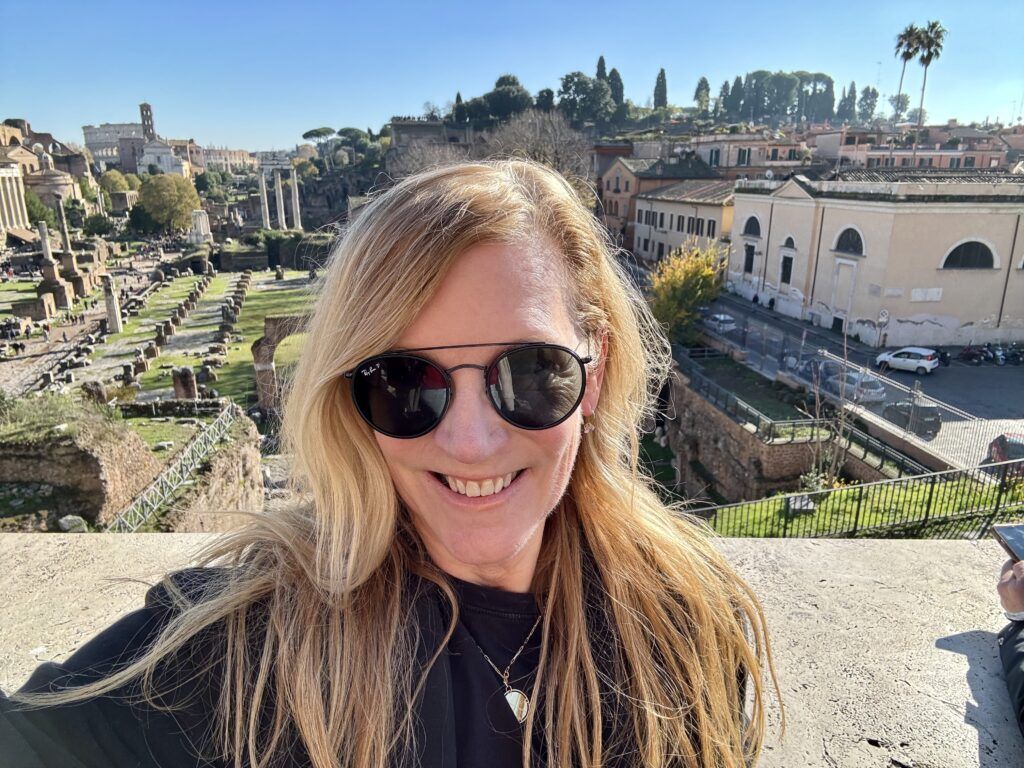
There are several tour options available, each with different durations and focuses. Choose one that aligns best with your interests and schedule.
I’ve personally taken the third and sixth tours on the list. They really helped bring the history of the place to life!
- skip the li ne entr y tickets to all 3 sites
- 3 hour gu ided tour and en try t o all 3 sites
- tickets & tour of all 3 sites + underground Colosseum access
- C oloss eum tour with e ntry tickets for Palatine Hill and the Roman Forum
- 4 ho ur priv ate d ay tour of Ancient Rome
- skip the lin e private guided tour with an art historian
Guide To The Roman Forum: What To See
1. arch of constantine.
If you’re a Christian, this arch is a symbol of your religion.
Constantine’s Arch represents a landmark in history, when a military battle made Christianity the mainstream religion in Rome and the entire Western World.
In 312, Emperor Constantine defeated his enemy and co-emperor Maxentius in the Battle of the Milvian Bridge, a turning point in their dispute. Legend holds that, the night before, Constantine dreamt of a cross in the sky.
When Constantine was victorious the following day, Maxentius fell off the bridge and drown. Constantine became sole emperor.
Straight away, he ratified the Edict of Milan, a religious tolerance act. It was the beginning of Christianity as the official state religion. One wonders what world history would be like if Constantine lost the battle …
Newly restored, the Arch of Constantine tells the story of his great victory. The arch is made entirely of carvings and decoration from other buildings with military imagery. An inscription on the top level announces that Constantine was the builder.
In the round reliefs, you see Emperor Hadrian. In the square reliefs you see Marcus Aurelius. The arch is topped with statues of Augustus and Trajan. In this manner, Constantine conflates himself with past great emperors.
READ : History of the Roman Emperors
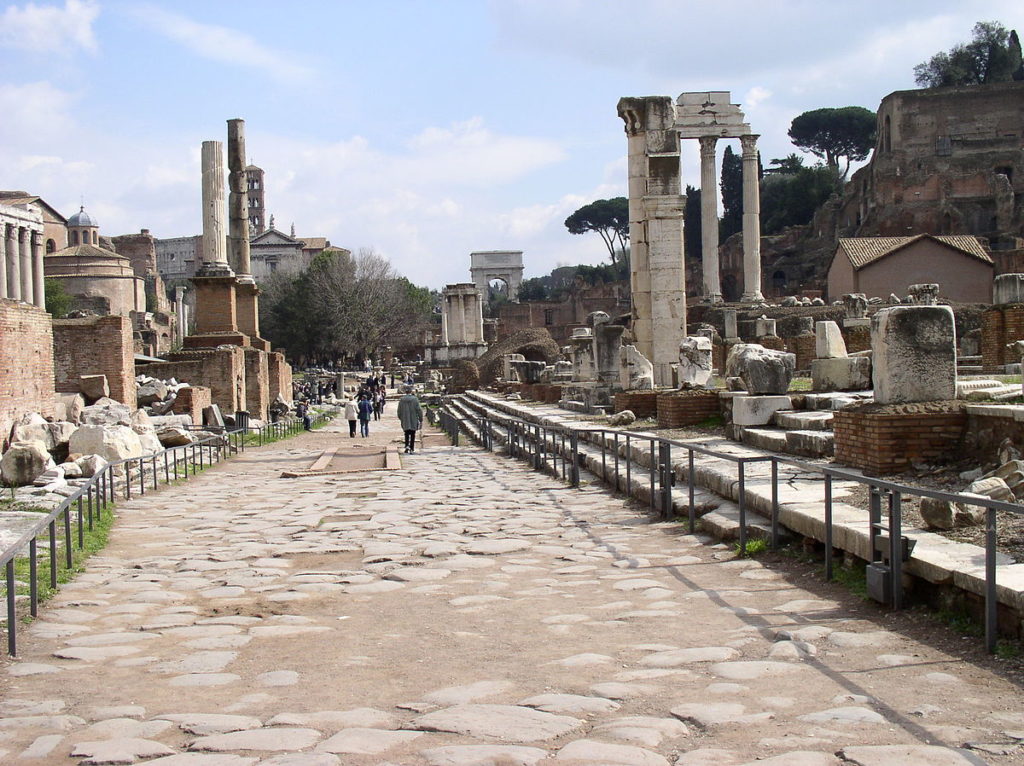
2. Via Sacra
The Via Sacra is the main street of the Roman Forum and it connects many of its monuments.
It’s a historic path where the story of Rome unfolded. This road was the center of Roman life, frequented by famous historical figures like Caesar, Cicero, Pompey, and Augustus. It was also the route Roman generals took to celebrate their victories.
Today, the Via Sacra might not look as grand as it once did. Many of its original paving stones are missing or uneven.
But as you walk down this road, remember that you’re following in the footsteps of some of Rome’s most influential people.
3. Temple of Venus and Rome
The Temple of Venus and Rome was another massive temple in the Roman Forum. Over 100 feet tall, it was once one of ancient Rome’s most impressive monuments.
The temple was designed by Emperor Hadrian. As was his preference, the temple is Greek in design. It was once surrounded by white columns, which now mark the perimeter.
The Temple of Venus and Rome is really just a shell now. The main ruin is an apse in the center.
It’s a brick arch with a cross hatched ceiling. The ceiling was installed by Maxentius in 307.
The temple once consisted of two main chambers, each preceded by a vestibule. Inside were two colossal statues of Venus and the goddess Rome Aeterna. Their Latin names, Roma and Amor, are inscribed on the walls, equating the city of Rome and the concept of love.
4. Arch of Titus
The Arch of Titus, one of three triumphal arches in the Roman Forum, stands as a monumental reminder of Rome’s military victory over Judea.
Built in honor of Emperor Titus by his brother Domitian, this structure is a mix of triumph and tragedy.
The inscription on the arch, “the Senate, the People of Rome,” harks back to the era of the Roman Republic, which ended with Augustus becoming emperor.
The arch is known for its darker narrative: it symbolizes the defeat and displacement of the Jewish people following the Fall of Jerusalem.
Titus’ siege led to the city’s destruction, the enslavement of thousands, and the desecration of the sacred temple, of which only the Wailing Wall remains today.
Inside, the arch features imagery of Roman soldiers carrying a menorah from the temple, symbolizing the exile of the Jewish population, a historical event whose repercussions are still felt today.
The arch once displayed colorful statues and showed the emperor in a victory parade.
The red color on the emperor’s face represented his vanquished enemies. The central panel in the arch depicts Titus’s apotheosis, immortalizing him as a god observing from the heavens.
5. Basilica of Maxentius and Constantine
Sited on Velia Hill, the Basilica of Maxentius and Constantine is an absolutely enormous building.
It was built with unprecedented technology and oozes Roman imperial power. The Romans used concrete, with inset bricks that were then covered in marble.
The basilica is a massive structure made up of three barrel vaults. It’s as if the city was built for giants, not humans.
But the monumental basilica is now less than one third of what it once was.
The basilica wasn’t a church as the name suggests. Rather, it was a Roman hall of justice. Litigious citizens could come here to lodge a lawsuit, bicker about inheritances, or get building permits.
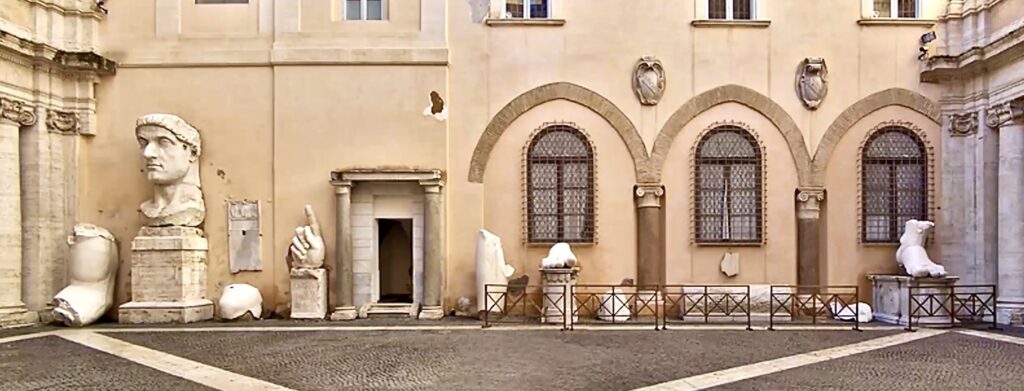
The three arches are the three bays that made up one of the two side aisles of the basilica. What’s no longer there is the central aisle or nave.
The basilica was begun by Maxentius. Constantine completed it, after he vanquished his rival and co-emperor.
There was originally a colossal statue of Constantine on a throne in the nave. Chunks of the 30 feet original statue are in a courtyard of the wonderful Capitoline Museums .
The basilica interior was elaborate, with intense color and ornamentation. The nave was lavishly furnished with gilded ceilings, inlaid marble, and sculptures.
6. Temple and House of the Vestal Virgins
The only people who lived in the Roman Forum were the members of the Cult of Vesta, led by the high priest Pontifus Maximus.
The vestal virgins were extremely famous. Their temple was one of ancient Rome’s holiest spots.
The virgins came from Rome’s noblest families, chosen at the age of 10. They took a vow of chastity for 30 years. They were sacred living creatures. Their job?
To keep alive the flame of Vesta in the circular Temple of Vesta, which symbolized the hearth of the Roman family.
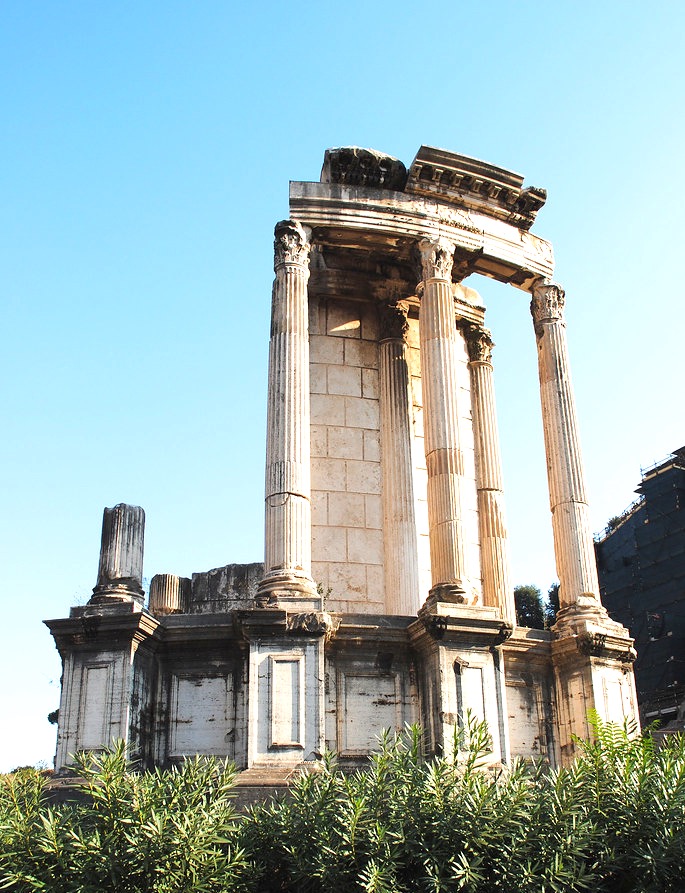
As long as the fire burned brightly, Rome was supposedly safe. The temple was once surrounded by 20 columns.
The House of the Vestal Virgins was a two story building.
The building surrounded a long courtyard with three pools and mosaic floors. The house became a model for later medieval cloisters.
There’s not much left to see, aside from a cult room and sculpures of the vestals.
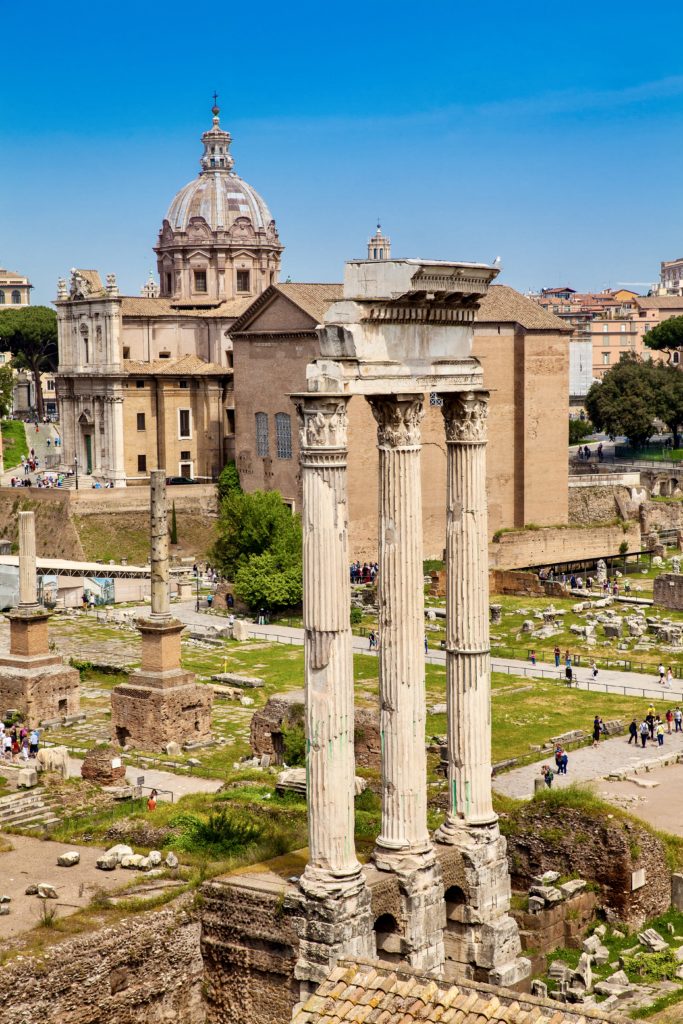
7. Temple of Castor and Pollux
Dating from the 5th century B.C., this former temple consists of just three leafy Corinthian columns. But it was once a prestigious temple in the forum.
The temple commemorated the Roman victory over the reviled Etruscan king Tarquin. After their victory, Castor and Pollux, twin sons of the god Jupiter, watered their horses on the spot.
The temple was often used as meeting place for senators. The front steps served as a podium for Rome’s orators.
8. Domus Tiberiana
Domus Tiberiana is an impressive imperial palace on the slopes of the Roman Forum. Although the entrance is on Palatine Hill, it feels like it’s part of both the hill and the forum because you can easily see it from the forum area.
This once grand estate covered nearly 10 acres, featuring luxurious residences, gardens, spaces for the Praetorian guard, and places for worship. Its standout feature is the facade, marked by large arches and barrel vaults.
The Domus Tiberiana was only discovered in 2004. After years of excavation, it opened to the public in September 2023. I visited in December and it was a truly special experience.
You’ll can only visit with a special SUPER ticket. Individual tickets are not available. For more on how that works, you can check out my guide to the SUPER ticket .
>>> Click to buy a SUPER ticket on Viator
9. Temple of the Divine Caesar
The Temple of the Divine Caesar in the Roman Forum is a famous monument dedicated to Julius Caesar, a pivotal figure in Rome’s transition from republic to empire.
The temple told the story of Caesar’s life. But it also marks the spot where Caesar, assassinated on March 15, 44 B.C., was cremated and buried.
You may get the willies standing there. This is a spot where history changed. Yet, it’s rather underwhelming to look at.
It’s a simple area with a modern canopy covering the remains of an altar. This modest mound is often covered with coins and flowers.
10. Temple of Romulus
The origin of the Temple of Romulus has been the subject of conjecture.
Most historians think that Emperor Maxentius used it as a temple for his son Valerius Romulus, who died at age 4 in 309 and was deified.
The temple’s original bronze door is decorated with two porphyry columns — a marble so rare that it’s almost extinct. Inside, the temple has several cycles of frescoes.
Inside, here are 13th century wall paintings that imitate curtains. There’s also a funerary tabernacle with a madonna and child.
They only allow a set number of people in at a time. So you should expect to wait in line.
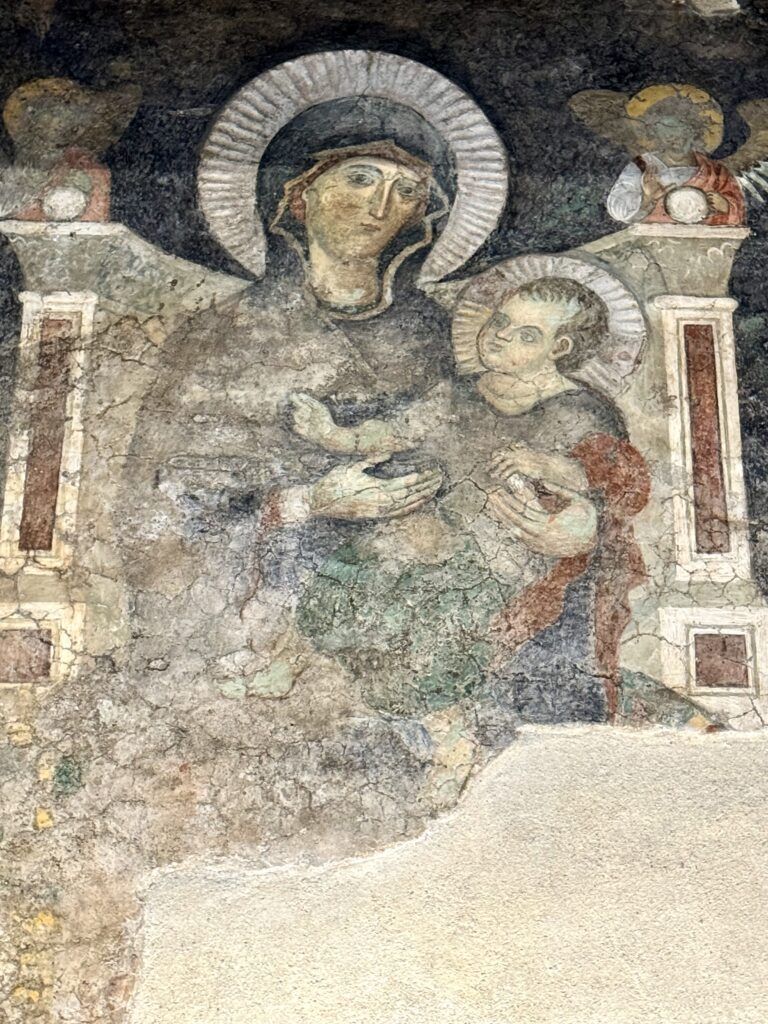
11. Temple of Antonius and Faustia
This temple was built by the Emperor Antonius for his deceased wife, the beautiful Faustina who died young. Historians consider Antoninus to be part of the five “Good Emperors.”
Antonius wasn’t long for the world either. So he decided to slap his own name on the temple as well. That meant he could walk through the forum and see people worshipping him while he was still alive.
The temple has a majestic front. The Corinthian columns are 50 feet high, with formerly gilded capitals.
A staircase led to a shaded loggia past the columns, which admitted Romans to the building. The original triangular pediment would have held vividly colored statues.
12. Santa Maria Antiqua
Santa Maria Antiqua is one of the earliest surviving Christian churches in Rome.
The Byzantine church was discovered in 1900. It was built within a 1st century Roman structure constructed by Emperor Domitian.
The church has a wealth of rare Byzantine style frescos from the 6th to 9th centuries. They depict the lives of Jesus and the Virgin Mary.
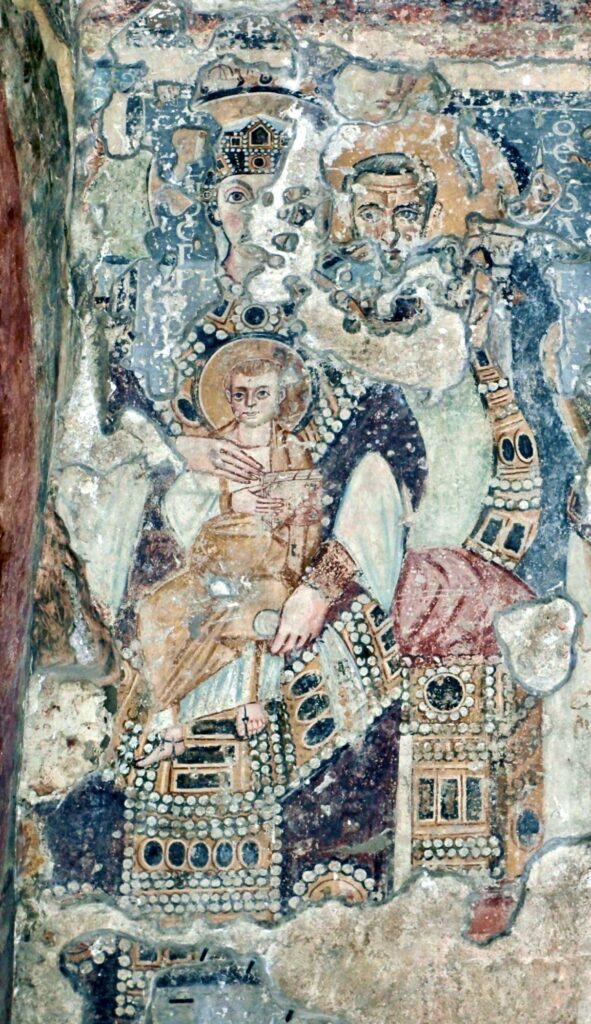
You’ll find one of the world’s oldest depictions of Jesus’ crucifixion. Christ is shown in a sleeveless blue robe.
The best preserved fresco is the cycle of the martyrdom of St. Cyricus and St. Julitta, which covers the Chapel of Theodotus. It’s considered the Sistine Chapel of the medieval era.
During a 9th century earthquake, the church was buried in rubble. It was sealed from the world for over 1000 years, only discovered in 1702. This fate might have saved the precious works from a subsequent Baroque redo.
You can only visit with the SUPER ticket. There is a 3D light show that reconstructs the frescos so you can see what they once looked like in more detail.
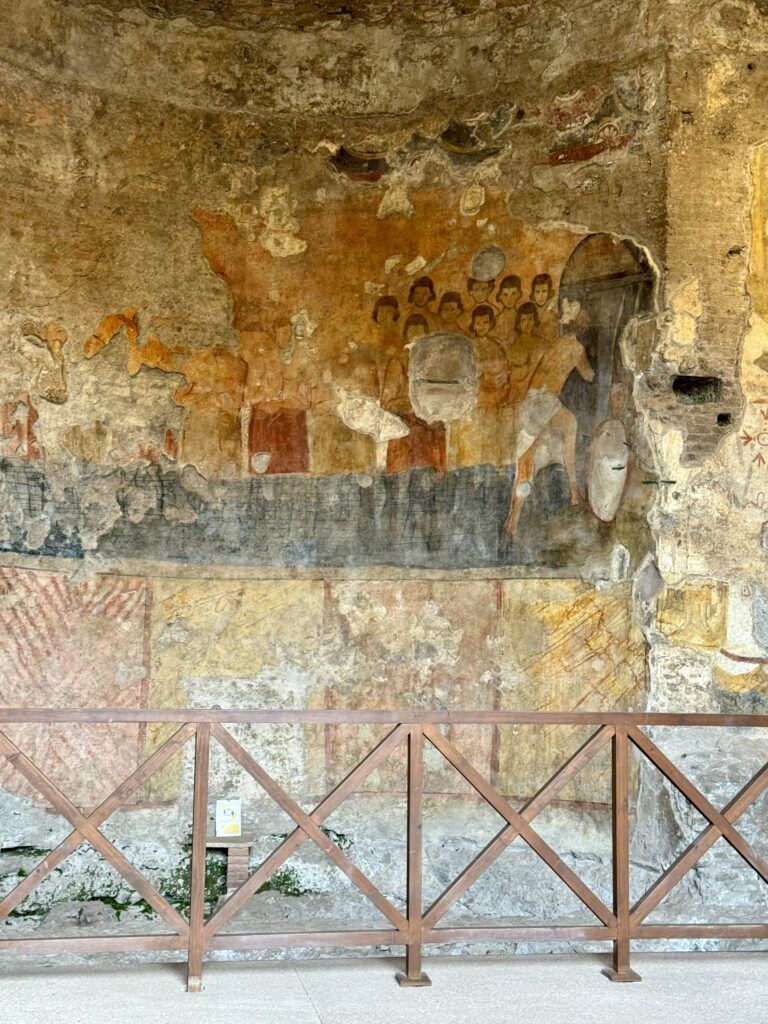
13. Oratory of the 40 Martyrs
Right next to Santa Maria Antiqua, you’ll find the Oratory of the Forty Martyrs, another SUPER site. This smaller room has some faded, but still beautiful, collection of 8th and 9th century frescoes.
The oratory gets its name from the Forty Martyrs of Sebaste, a group of Roman soldiers martyred under Emperor Diocletian for their Christian beliefs.
The frescoes on the walls vividly portray these saints and martyrs, including the Forty Martyrs themselves.
These paintings are key examples of early medieval Christian art and illustrate the martyrs’ ordeal and execution, where they were forced to endure a freezing night in an icy lake.
14. Domitian’s Ramp
In ancient Roman times, Santa Maria Antique was likely the entrance hall to the 1st century Ramp of Domitian. The ramp connected the public area of the Roman Forum to the private imperial palace complexes on Palatine Hill.
It was discovered by Giacomo Boni, an architect and archaeologist. He excavated it mostly between 1899 to 1905.
The ramp has seven levels, six hairpin turns, and is both above and under ground. It empties into a hilltop terrace with a breathtaking view over the Roman Forum.
After years of conservation, the church and ramp opened to the public in 2015. Now, with the SUPER Pass, you can walk along the 2000 year old passage, just like the emperors did.
15. Arch of Septimius Severus
The grand six story Arch of Severus celebrated Emperor Severus’ victory in Mesopotamia.
It’s adorned with reliefs showing soldiers leading captives and slaves back to Rome, reflecting a time when Rome increasingly relied on plunder, contributing to its eventual decline.
Dedicated to Severus’ sons, Caracalla and Geta, the arch became a symbol of family betrayal.
After Severus’ death, Caracalla, who would gain notoriety as an emperor, murdered Geta to rule alone and then erased all traces of his brother from history, including mentions of the arch.
The arch itself features three vaulted passageways, flanked by four detached columns on elevated bases. Below the arch is a circular base, marking the exact center of ancient Rome and symbolizing the saying, “all roads lead to Rome.”
16. Temple of Saturn
This temple, the oldest in the Roman Forum, was more than just a place of worship. It served as the treasury of Ancient Rome.
racing its origins back to the 5th century B.C., the structure you see today was actually rebuilt in the 4th century A.D.
As you look at the temple, the columns that catch your eye once framed its entrance.
Inside, there was once a simple wooden statue of the god Saturn. Interestingly, the statue had a secret: its base was a storage spot for treasures, filled with various forms of booty and plunder from Rome’s conquests.
17. Curia Julia | Sant’Adriano al Foro
The remains of the Curia Julia date from 283. The curia was completely restored in the 1930s.
This was the Supreme Court of Rome, and the most important political building in the forum. The senators gave speeches and promulgated the laws of the land. There were four chambers hearing cases.
It was common for the orator-lawyers to go outside and pay people to come in and clap during their rousing orations. They were essentially professional clappers.
If the curia is open, you can see two statues. One headless statue, made of porphyry marble was dedicated to either Hadrian or Trajan. Unfortunately, it’s usually closed.
18. Rostrum
The Rostrum was the “Speaker’s Corner.” Archaeological evidence suggests that it has existed since the 5th century B.C. But it wasn’t officially called the “rostra” until the 4th century A.D.
The Rostrum was a long stage created for Rome’s great orators to speechify to the assembled masses and try to sway public opinion.
The rostrum was likely 10 feet high and 80 feet long, ornately decorated with columns and statues.
During the republic, freedom of speech reigned free. During the empire, free speech took a hit when it was more dangerous to speak truth to power.
Great events in Roman history occurred here. Cicero railed against Rome’s corruption and decadence. Mark Anthony offered the laurel of kingship to Caesar, who dramatically refused preferring to be a private dictator.
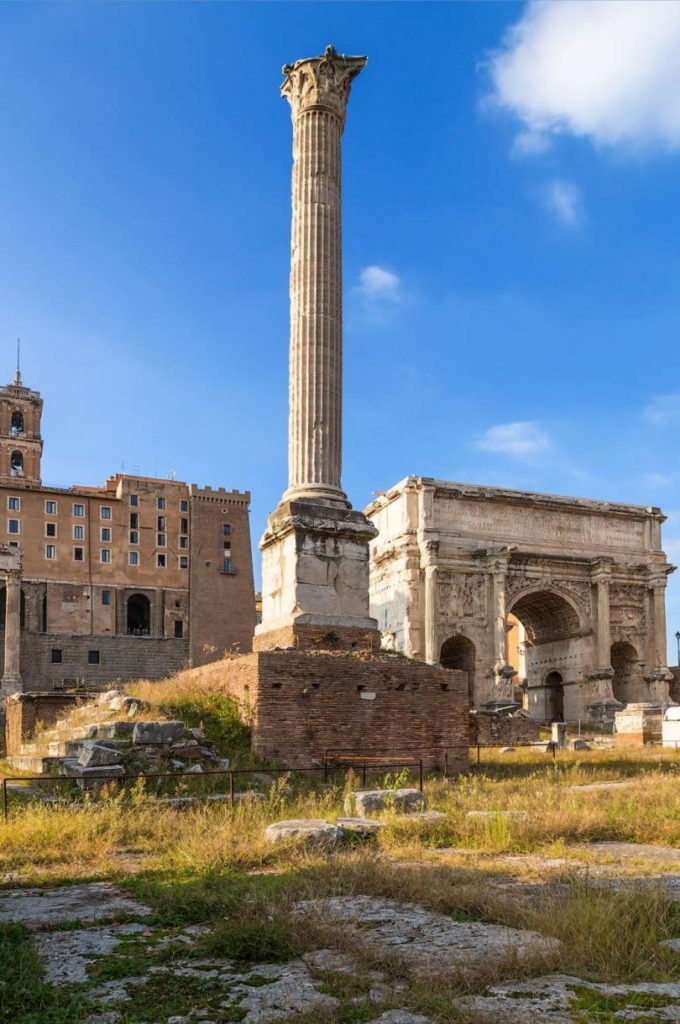
19. Column of Phocas
The Column of Phocas was the last monument to be erected in the Roman Forum. It’s a triumphal column in honor of Phocas, a 7th century Byzantine emperor who ruled Rome from the east.
The column was supposed to represent a unified Rome, a new dawn for the Roman world. But that was a delusion. Rome was on its way out.
And so was Phocas. He had murdered his predecessor to usurp the throne in 602. Two years after this column was erected, he himself was assassinated.
Phocas did succeed in one thing though. He gifted the Pantheon to the Pope Boniface IV to turn into a church, probably saving it from ruin.
The 45 foot column is a little piecemeal. The base once propped up a statue of Diocletian. The column itself was taken from an older building.
It’s recently been restored.
Practical Guide & Tips For The Roman Forum
Address : Via della Salara Vecchia between Piazza Venezia and the Colosseum
Hours : Daily 8:30 am to 7:00 pm
Ticket Price : Combined ticket to visit The Roman Forum, the Colosseum, and Palatine Hill is 16 euros. There is an online booking fee of 2 euros.
Metro : Colosseo
Pro Tips : You can also visit the Roman Forum using the Roma Pass , which is a cumulative ticket that provides free or reduced rates for more than 40 attractions plus public transportation.
I have you’ve enjoyed my guide to the monuments and ruins of the Roman Forum. You may enjoy these other Rome travel guides and resources:
- 8 ways to spend 1 day in Rome
- 3 day itinerary for Rome
- 5 day itinerary for Rome
- 1 day itinerary for Vatican City
- Hidden gems in Rome
- Best museums in Rome
- Guide to the Borghese Gallery
- Guide to Palatine Hill
- Guide to the Colosseum
- Walking tour of central Rome
Pin it for later.
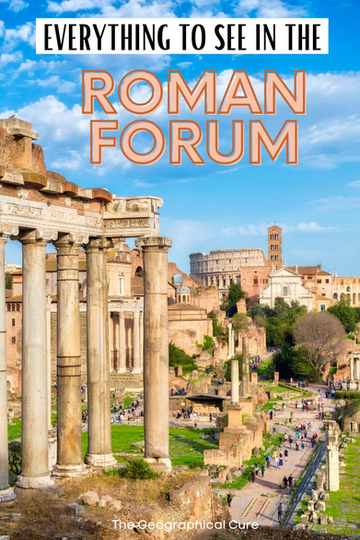
Leave a Comment Cancel reply
Save my name, email, and website in this browser for the next time I comment.
Last Updated on January 21, 2024 by Leslie Livingston
- History Classics
- Your Profile
- Find History on Facebook (Opens in a new window)
- Find History on Twitter (Opens in a new window)
- Find History on YouTube (Opens in a new window)
- Find History on Instagram (Opens in a new window)
- Find History on TikTok (Opens in a new window)
- This Day In History
- History Podcasts
- History Vault
Roman Forum
By: History.com Editors
Updated: July 25, 2023 | Original: March 8, 2018
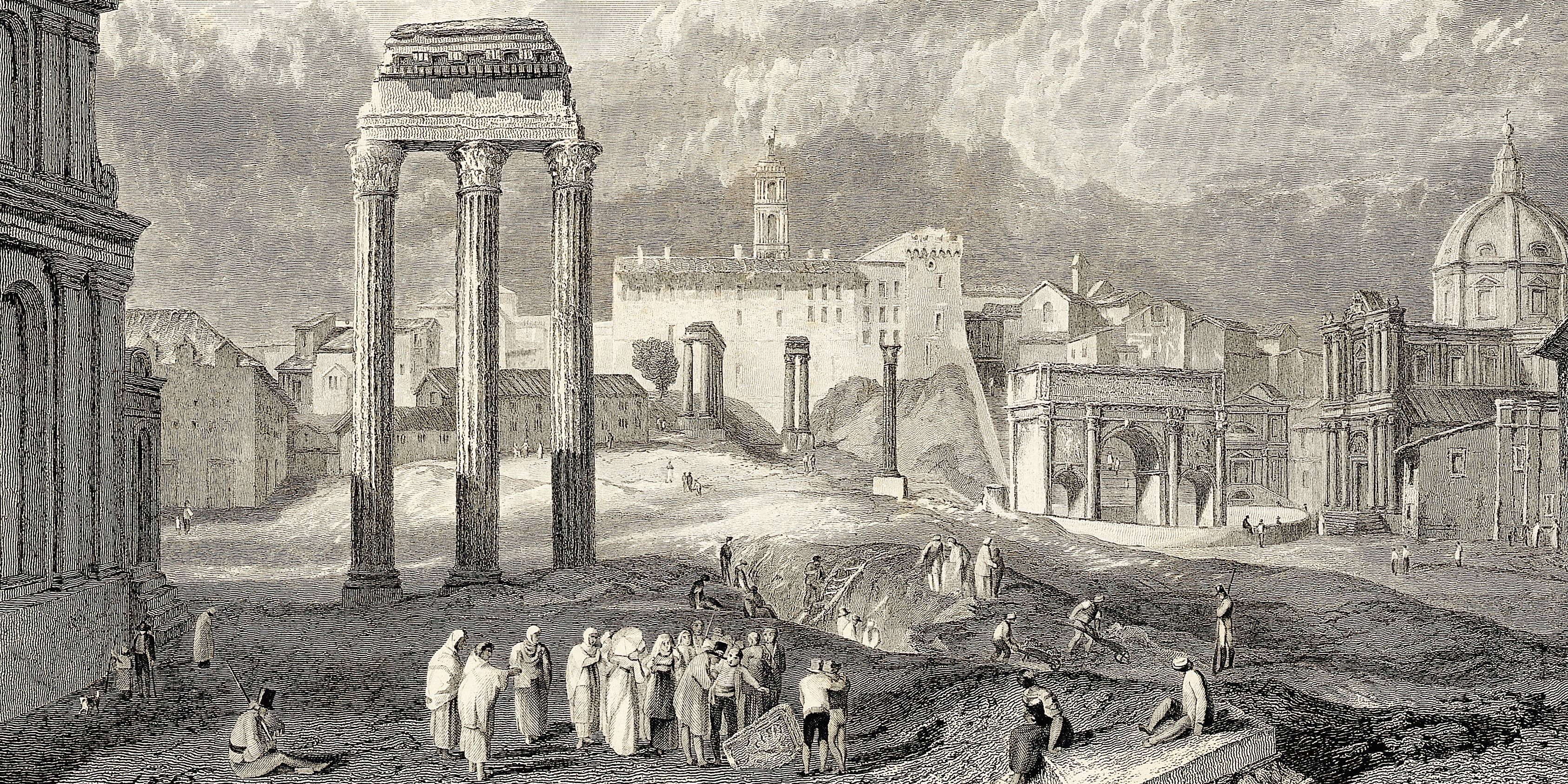
The Roman Forum, known as Forum Romanum in Latin, was a site located at the center of the ancient city of Rome and the location of important religious, political and social activities. Historians believe people first began publicly meeting in the open-air Forum around 500 B.C., when the Roman Republic was founded. The rectangular-shaped area, sited on low-lying land between Palatine Hill and Capitoline Hill, was home to many of the ancient city’s most impressive temples and monuments. Today, the Roman Forum is one of the most famous tourist sites in the world, attracting more than 4.5 million visitors annually.
Forum’s Early History
According to a widely accepted legend, ancient Rome was founded by brothers Romulus and Remus in 753 B.C. After a rising conflict, Romulus killed Remus, became king and named Rome after himself.
The traditional story also credits Romulus with starting an alliance with his rival, Titus Tatius, and making the site of the Roman Forum a neutral meeting zone.
At first, the Forum essentially served as a marketplace for day-to-day shopping. Over time, it became much more versatile and functional, as public affairs were held in the area.
Historians estimate that the rise of public events in the Roman Forum first took place around 500 B.C., when the Roman Republic started.
The Forum gradually developed, progressed and expanded over many centuries. Statues, arches, basilicas and other buildings were constructed to accommodate the gatherings.
Around the reign of Julius Caesar , the Forum became overcrowded. Caesar is credited with building a new forum, off to the side of the original, to offer more space. Later, the Emperor Augustus also added on to the area.
Roman Forum Functions
The Forum was considered the heart of Rome. While there were many other forums in ancient Rome, the Roman Forum was the most significant.
It was a multi-purpose site that accommodated various functions. Events taking place in the Forum included:
- Public speeches
- Criminal trials
- Gladiator matches (before the Colosseum was built)
- Social gatherings
- Business dealings
- Public meetings
- Religious ceremonies
- Educational events
- Buying, selling and trading of items
Important Sites in the Forum
Several important buildings, statues and monuments were located in the Forum. Some temples were built to honor men, and others were dedicated to gods or goddesses.
Some of the most well-known structures in the Roman Forum include:
Senate House: The senate house, known as the “Curia,” served as the council house for the Roman Senate and a site for various political events. It was rebuilt several times, and in the 7th century, the Curia was converted into a church.
Temple of Saturn: The first Temple of Saturn was built around 498 B.C. and is considered one of the earliest temples in the Roman Forum. But it was rebuilt years later, and the current ruins date back to roughly 42 B.C. This building was dedicated to Saturn, the god of agriculture, and was used as a treasury—where Rome’s money was managed and kept.
Arch of Titus: This first-century arch was constructed in 81 A.D. by the Emperor Domitian to honor his brother, emperor Titus, who was victorious in the Siege of Jerusalem .
Temple of Vesta: The Temple of Vesta was a circular-shaped temple that was dedicated to Vesta, the goddess of hearth, home and family.
The Rostra: The Rostra was a platform that people could stand on to give speeches.
Temple of Castor and Pollux: Historians believe this temple was completed in about 484 B.C. It was dedicated to the Roman twin demi-gods, Castor and Pollux, and underwent several construction phases.
The Sacra Via: This was the main road that ran through the Roman Forum and connected the various important sites. This famous street also stretched to the Colosseum , which was within walking distance of the Forum. It primarily served as a pathway for ceremonies and processions.
Roman Architecture and Art
The Roman Forum was reconstructed many times during its existence. This allowed for various forms of architecture from different eras to merge together. Influence from each period can be seen in the design and construction of the buildings.
Roman architects were greatly influenced by classical Greek designs. But, the Romans also created their own signature structures, such as basilicas, triumphal arches, domes, Roman baths and amphitheaters. Materials ranged from concrete to magnificent marble.
The Roman Forum, and the ruins themselves, also served as a source of inspiration for artists. The famous Giambattista Piranesi, an Italian artist who lived during the 1700s, was known for creating a set of etchings that depicted views of Rome.
Sites in the Forum are also mentioned in historic literature: ancient Rome was, for example, the setting for several of William Shakespeare’s works.
Decline of the Roman Forum
Over time, many economic and political events began to take place in more elaborate structures to the north of the Forum.
The last major expansion to the Roman Forum, the Basilica of Maxentius, took place during the reign of Constantine in 312 A.D.
But most of the ancient buildings and sites in the Roman Forum were destroyed in 410 A.D., around the time that the entire Roman Empire began to fall.
During the Middle Ages , the land that was once the great Roman Forum was reduced to a pasture for grazing animals. The area became known as “Campo Vaccino,” or “cattle field” and was essentially an overgrown, neglected field.
Excavating the Forum
The Roman Forum was “rediscovered” by archeologist Carlo Fea in 1803.
Excavations to clear the area took over 100 years. In fact, it wasn’t fully excavated until the early 20th century.
Because the Romans built over earlier ruins, the remains from several centuries can be found in the Forum.
Roman Forum Today
Today, the Roman Forum is a popular tourist attraction. Visitors can get a first-hand look at the ancient ruins and architectural fragments that were left behind. Persistent efforts to restore and preserve the ruins remain a top priority.
Excavations are ongoing in and around the Forum. Historians are still trying to uncover new findings that could give them answers about Rome’s exact age. For instance, in 2009, a group of archeologists found pottery remains and foods scraps around a wall that dated back to the 8th or 9th century B.C. This is more than a century before most experts thought Rome was founded.
The ancient remains are mysterious in many ways, but they offer unprecedented insight into Roman civilization.
The Roman Forum, Ancient History Encyclopedia . The Roman Forum, KhanAcademy . Roman Forum, TribunesandTriumphs.org . The Ancient Roman Forum, ThoughtCo . Ancient Rome , Ancient History Encyclopedia . Interesting Facts About the Roman Forum, Just Fun Facts . Roman Architecture, Ancient History Encyclopedia .
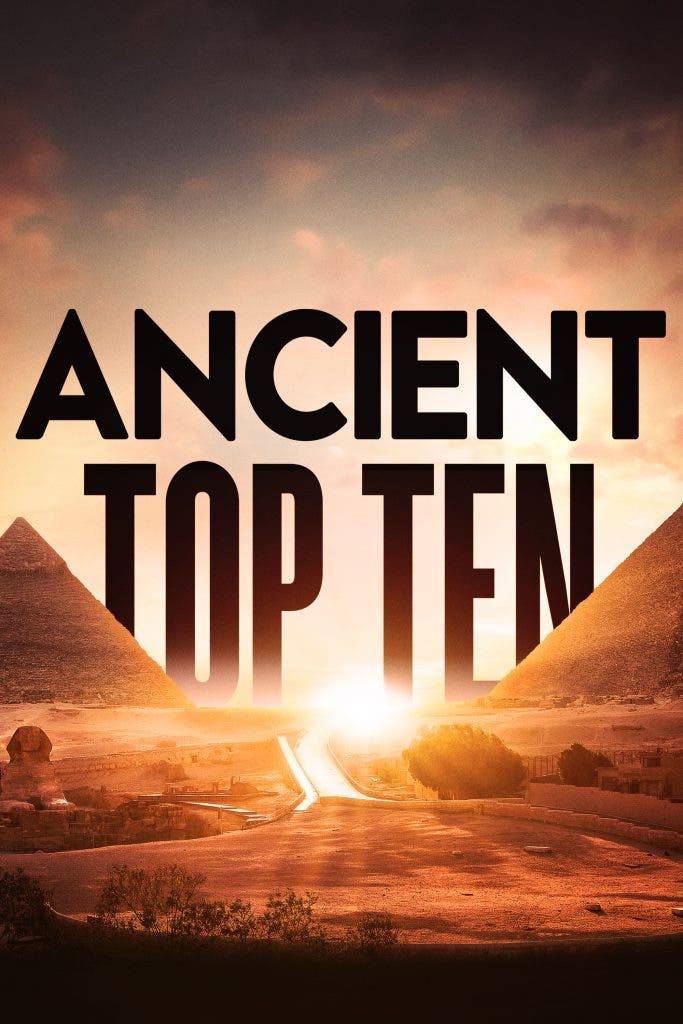
HISTORY Vault: Ancient Top 10
A smart, fun countdown that details how ancient technology worked, how surprisingly advanced it was and how it was kind of awesome!


Sign up for Inside History
Get HISTORY’s most fascinating stories delivered to your inbox three times a week.
By submitting your information, you agree to receive emails from HISTORY and A+E Networks. You can opt out at any time. You must be 16 years or older and a resident of the United States.
More details : Privacy Notice | Terms of Use | Contact Us
It's All About Italy
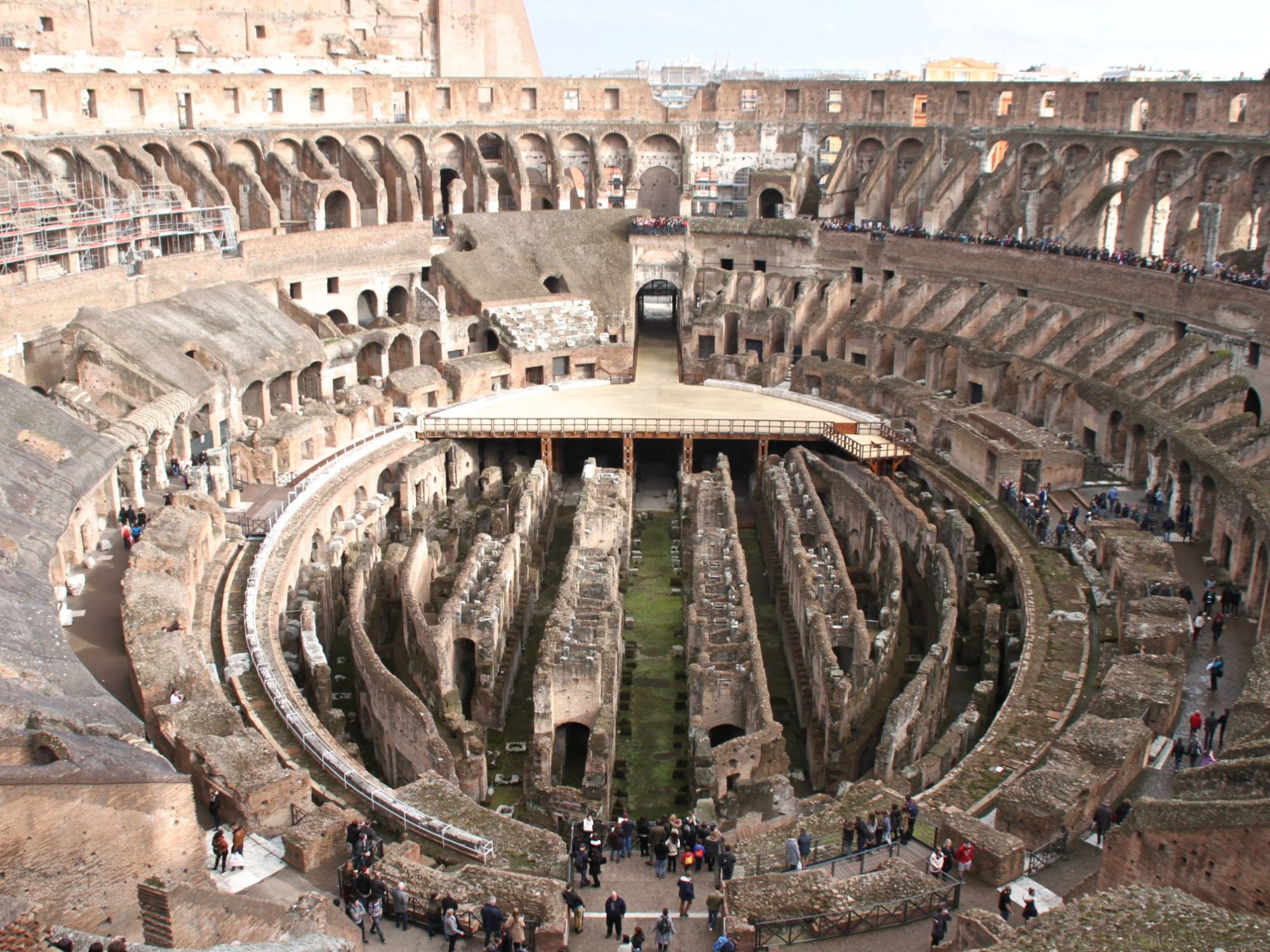
The Roman Forum: A Practical Visitor’s Guide
There are few cities in the world that are as jam-packed with history as Rome . Walking through the city’s cobbled streets is an unforgettable experience, as each turn reveals yet another iconic setting from history. But few spots are more impressive than the triumphal arches, towering temples and fallen columns of the Roman Forum or Foro Romano where, for centuries, the fate of the ancient Roman Empire and its people was decided. So its no wonder that millions of visitors want to see where Rome was founded, making this one of the most popular tourist attractions in Italy. If you’re planning a trip to Rome, here are our essential tips and tricks to guarantee a stress-free visit with our 3-in-1 pass to the Roman Forum, Palatine Hill and Colosseum .
Book ahead to skip the Roman Forum and Colosseum lines
When you’re on vacation, time is precious. Much too precious to waste hours standing in a long dusty line in the heat of the summer sun, fumbling with your cash. Especially if you only have one or two days in Rome.
That’s why these days the smartest travelers book online in advance to skip the long lines and ensure a relaxing, stress free vacation. It’s secure, as easy as 1-2-3 and can be done from the comfort of your armchair, or with the help of our travel experts in just a few minutes! Perfetto!
Start at the very beginning
As the largest and most imposing building in the three sites, it’s tempting head straight to the Colosseum for the gladiatorial glamour and gore. But to understand how Rome started and grew to dominate the known world, plan your visit in chronological order.
Many of the oldest and most important religious and legislative structures of the ancient city are located in the Forum. From the legendary 7 th century BC Temple of the Vestal Virgins, to the Curia Julia Senate House built by Julius Caesar, to the enormous Temple of Antoninus and Faustina, all have fascinating tales to tell. So aim for the Roman Forum first, climb up to the Palatine Hill for the royal palaces and then drop down to the arena for the finale.
Don’t forget the Palatine Hill
The Palatine Hill is one of the seven hills upon which Rome was established and, along with the Roman Forum, is one of the most ancient parts of the city. Legend has it that founding twins Romulus and Remus were discovered in a cave here, being looked after by a she-wolf. And although little remains of the twins today, the hill is still home to Emperor Augustus’s centrally-heated royal palace, built in the 1 st century AD and described by some as the first “White House,” as it had a west wing for public life and an east wing for the emperor’s private life.
The Palatine Hill also gave us the words palace (English), palazzo (Italian) and palais (French), all derived from the old Etruscan or ancient Italian word for sky or heaven.
And the hill is one of the highest points in the city with a great view over the Roman Forum, the modern city skyline towards St Peter’s and your next destination, the Colosseum. It was once the center of the Roman Empire and offers great insight into royal life on your whistle stop tour through 3,000 years of history.
Note : Entrance to the Roman Forum and Palatine Hill is combined on your ticket so make sure to visit both together as you won’t be allowed re-entry once you exit.
Read the signs
Deciphering what’s in front of you can be tricky: even though the ancient Romans brought us the first grid system cities, the Forum is a little more higgledy-piggledy in its layout.
There are a few small signs dotted around the site to explain the background of key spots so make sure to check them out to help you steer through the ruins and get the most out of your self-guided visit.
Take a closer look at the Roman Forum
The Forum is a huge site but don’t be overwhelmed as some of the most fascinating history can actually be seen in the tiny details that are often overlooked.
Up on the Palatine Hill, you can find large internal pipes built into the thick palace walls that once provided hot air central heating. Or keep your eyes peeled for early lead piping that carried water from the countryside to supply the ornate fountains and baths. The Latin for lead – plumbum – is also where we get the word “plumber.”
And if you look very closely at the steps of the Basilica Julia near the Curia Julia in the Forum, you might even spot the grooves, grids and circles of board games carved into the marble where ancient Romans used to sit and play games. These are the intricacies that breath life back into the ancient Romans. Fascinating, eh?
Plan enough time for your visit
At a practical level, the time you spend at the Roman Forum and Palatine Hill depends on you. Your pass has a designated entry time for the Colosseum but you are free to enter the Forum at your leisure, either before or afterwards.
So if you like a bit of a history, have read about ancient Rome or have a guidebook to hand, you can easily spend half-a-day exploring the sprawling ruins and the small museum on the Palatine Hill before you even get to the Colosseum.
If, on the other hand, time is tight and you’re looking for a quick glimpse of ancient Rome to set the scene, it’s worth putting aside at least an hour to soak up the ancient Roman atmosphere and architecture before entering the Colosseum. The choice is yours.
Choose the right footwear
On a practical note, Rome’s smooth stone cobbles can be slippery when wet or dusty and the same goes for the ancient Roman Forum. Add in the uneven paving stones of the ancient Roman streets, worn silky smooth over the centuries, or the climb up to the Palatine Hill on hard gravel paths, and thin-soled flipflops might not be the best footwear!
Not that you need walking or hiking boots; that would be overkill. But non-slip tennis shoes might just make your little piggies more comfortable, whatever the weather.
And bring an umbrella and a water bottle
Rome enjoys a temperate climate all year-round with moderate, wet winters and scorching, sunny summers. The Roman Forum, however, offers very little in the way of shade so pack an umbrella to guard against rain or provide shade from the sun. And bring a bottle of water in summer since the Forum is a real heat trap for the thirsty traveler.
Ready to skip the line and explore the Roman Forum?
So what are you waiting for? If you’re planning a trip to Rome, a visit to the Roman Forum, Palatine Hill and Colosseum is essential. And now it’s even easier to explore the temples, palaces and amphitheater without wasting time waiting in line. Just go online or give our travel experts a call to book your stress-free pass and save yourself a hot, dusty delay. And make sure to check out our blog for other top tips on discovering Rome since once you’ve skipped the line with us, you’ll never want to queue again! Buon viaggio!
Why book with Select Italy
We have over 23 years of experience providing luxury vacation destinations throughout Italy.
Our industry expertise, exclusive access to accommodations, handpicked tour guides, and unique vacation destinations differentiates Select Italy and allows us to create the best guest experience for you.
Expert Service | Price Match Guarantee | 100% Peace of Mind
Read more about Why you should book with us.

Exploring the Roman Forum: What to See and Do
Step back in time and immerse yourself in the rich history of ancient Rome as you explore the Roman Forum, once the heart of the eternal city. Discover the significance of this archaeological treasure, learn about its past, and uncover the secrets hidden within its ancient ruins. This journey will not only guide you through the Roman Forum’s notable landmarks but also offer practical tips, nearby attractions, and unique experiences to make your visit truly unforgettable.
Key Takeaways
- The Roman Forum is an iconic site of immense historical significance, with notable landmarks such as the Curia Julia and Rostra.
- Practical tips like purchasing tickets in advance and exploring nearby attractions offer a comprehensive experience of ancient Rome’s culture.
- Guided tours & ongoing excavation efforts ensure visitors can appreciate the grandeur of this historic landmark for generations to come.
Roman Forum, the city center
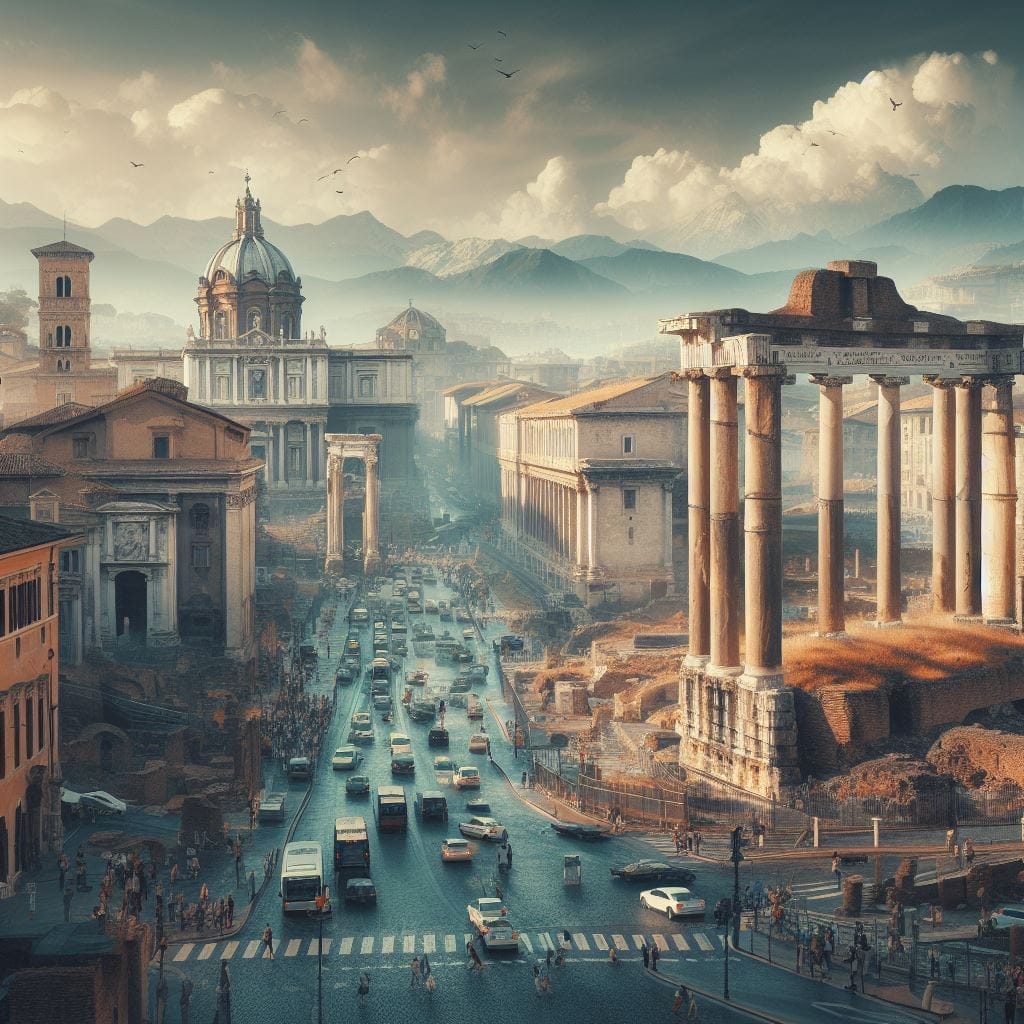
The Roman Forum, or Forum Romanum, was the epicenter of ancient Rome, serving as a bustling hub for politics, religion, commerce, and social life. Located between the Palatine and Capitoline Hills, it was the beating heart of the eternal city, where the powerful Roman Senate convened, and Julius Caesar’s triumphal processions took place. The ancient ruins scattered throughout the Forum, today bear witness to Rome’s glorious past, showcasing a multitude of architectural fragments and magnificent structures such as the Senate House, the Curia Julia, the Temple of Saturn, and the Arch of Septimius Severus.
As the Roman Empire began to decline , so too did the ancient Roman Forum. Factors such as the diminished power of the empire, a decrease in population, and the transfer of the Roman world’s administrative center to Constantinople contributed to its steady decline. Today, the Parco Archeologico del Colosseo, an archaeological park encompassing the Roman Forum and Palatine Hill, serves as a testament to the history and culture of ancient Rome, offering visitors a glimpse into the forum’s past.
The Roman Forum holds immense significance. It was a place where monumental decisions were made, religious ceremonies were conducted, and the social life of ancient Rome thrived. Exploring this ancient city, the echoes of the past underfoot and the weight of Roman history transport you back to the days when Rome ruled the world.
Roman Forum’s history
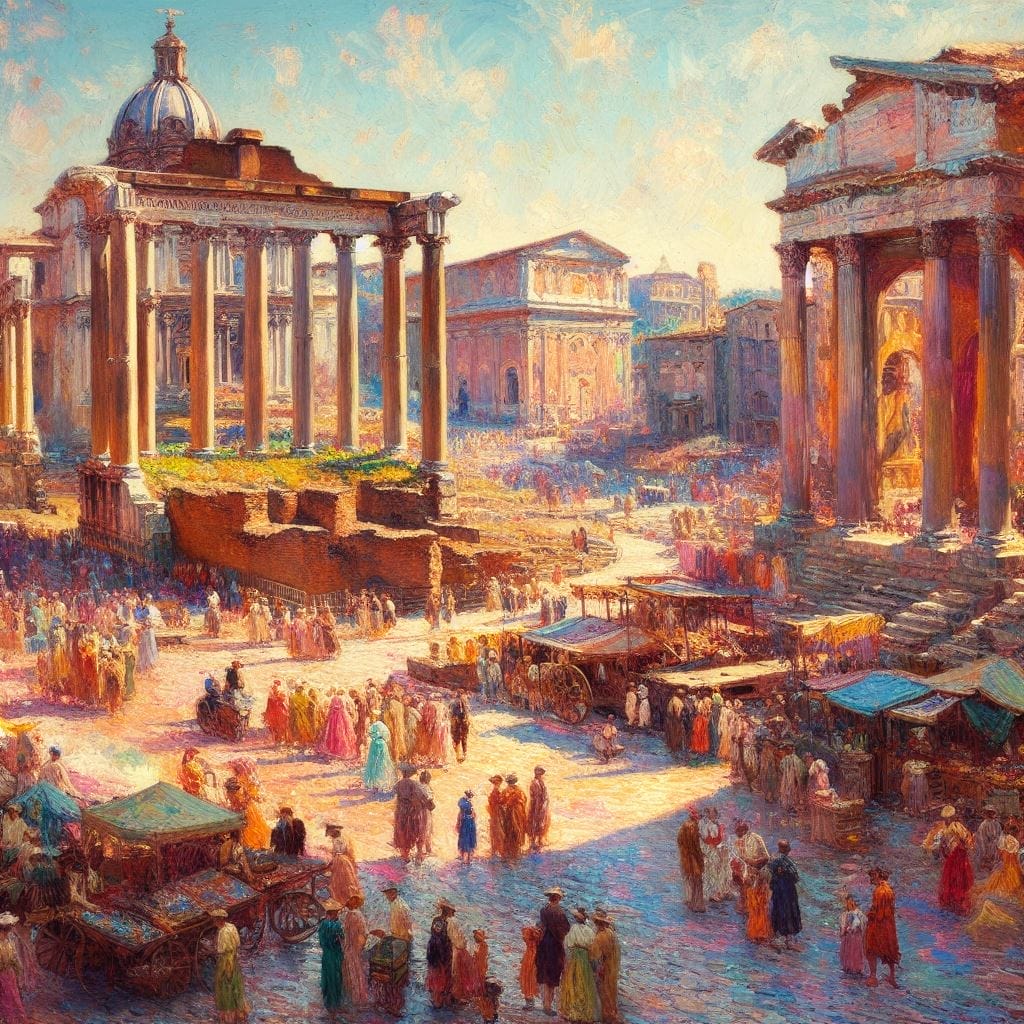
The Roman Forum’s history spans over a millennium, with its origins dating back to its humble beginnings as a marshland. As the site evolved, it transformed into a marketplace and eventually became the focal point of public life in Rome. It was around 500 B.C., when the Roman Republic was established, that people began to gather in the open-air Forum, setting the stage for the birth of the Roman Empire.
Throughout the centuries, the Roman Forum underwent numerous modifications and expansions, with each ruler leaving their mark on the landscape. For instance, during the Principate of Augustus, existing buildings were restored, unfinished projects were completed, and commemorative monuments were added, such as the temple dedicated to Julius Caesar. Emperors and their dynasties continued to contribute to the forum’s development, with structures like the Temple of Vespasian and Titus and the monumental Arch of Septimius Severus symbolizing their reigns.
The lasting legacy of the Roman Forum is evident in the ancient structures that remain today, as well as the continued excavation and preservation efforts that uncover new findings. Scholars such as:
- Rodolfo Lanciani
- Giacomo Boni
- Einar Gjerstad
- Andrea Carandini
Archaeologists and historians have played significant roles in the study and excavation of the Forum Romanum throughout the 19th and 20th centuries, shedding light on the fascinating history of this ancient city.
Notable Landmarks within the Roman Forum
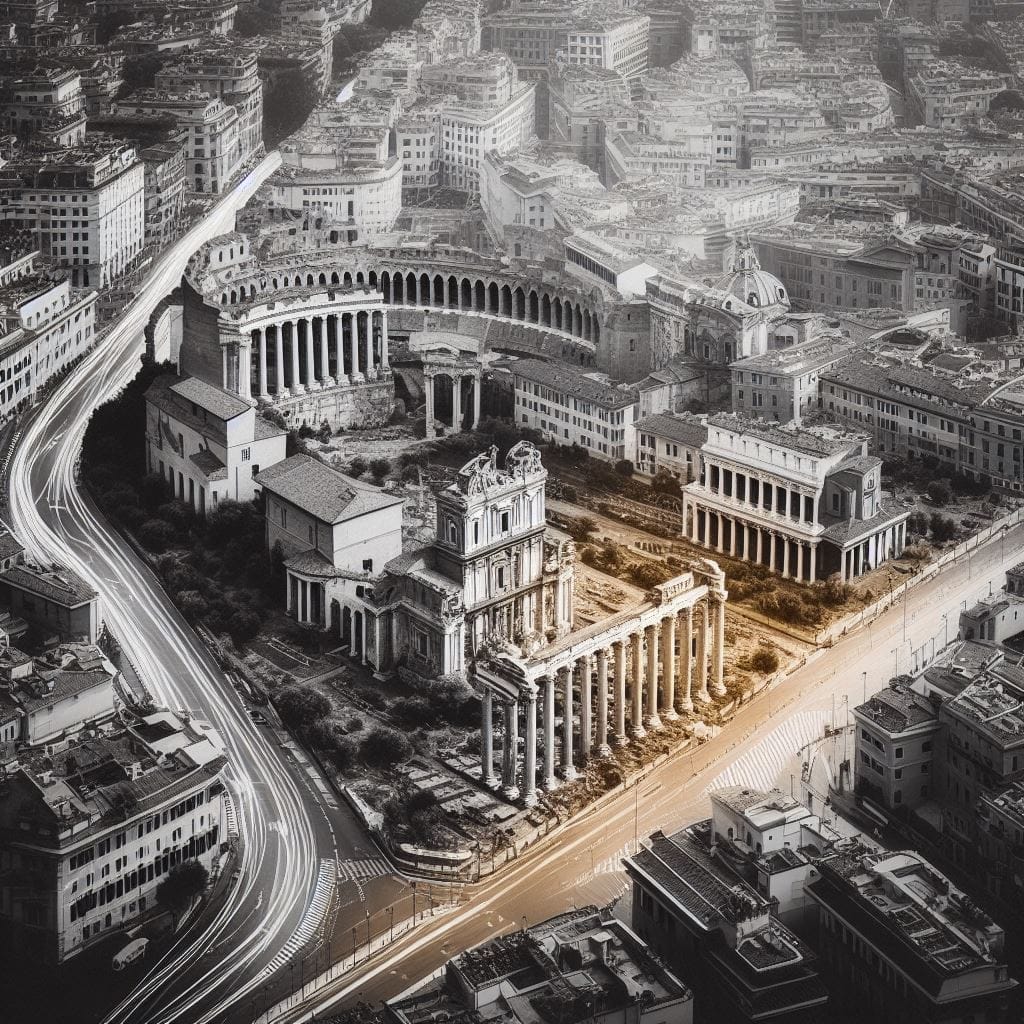
As you delve deeper into the Roman Forum, you will come across several key landmarks that stand as enduring testaments to ancient Rome’s rich history and architectural prowess. Among these ancient buildings are the Curia Julia, the Rostra, and the Via Sacra, each with its own unique story and significance.
The following sections delve into these remarkable structures in greater detail.
The Curia Julia
The Curia Julia, attributed to the architectural patronage of Julius Caesar , served as the Senate House of ancient Rome and played a crucial role in the city’s political life. Within its walls, significant political decisions were made, and public events took place. The Curia Julia was not the first Senate House in Rome, as earlier iterations such as the Curia Hostilia and Curia Cornelia had been used before. However, the Curia Julia would become the most enduring and iconic of them all.
Over time, the Curia Julia underwent numerous modifications and restorations. One notable restoration occurred under the Roman Emperor Domitian in 94 CE, followed by a rebuilding after a fire in 283 CE. The policy of open-door access during Senate meetings allowed ordinary citizens to sit outside and listen to the proceedings, reflecting the democratic ideals of ancient Rome.
Today, the Curia Julia stands as a reminder of the Roman Senate’s power and influence. In 630 CE, it was transformed into the church of Saint Hadrian , ensuring its preservation for generations to come. As you explore this ancient council house, you can almost hear the echoes of political debates and witness the unfolding of Rome’s storied history.
The Rostra used as a platform for public addresses, announcements, and ceremonies, was pivotal to the political life of ancient Rome. It was originally part of the Comitium, a triangular paved space intended for religious ceremonies, which evolved over time to include a stepped platform and ship’s prows affixed to the speaker’s podium.
This evolution transformed the Comitium into a space reminiscent of Greek ekklesiasteria, or public assembly forums, taking on a circular form by the 4th century BCE. The Rostra’s importance in ancient Rome’s political life is evident in the countless public speeches, announcements, and ceremonies that took place on its platform throughout the centuries.
As you stand before the Rostra, imagine the powerful orators who once graced its platform, their voices echoing through the forum as they addressed the masses. This speaker’s stage bore witness to pivotal moments in Roman history, and its presence in the Roman Forum serves as a testament to the importance of public discourse in the ancient city.
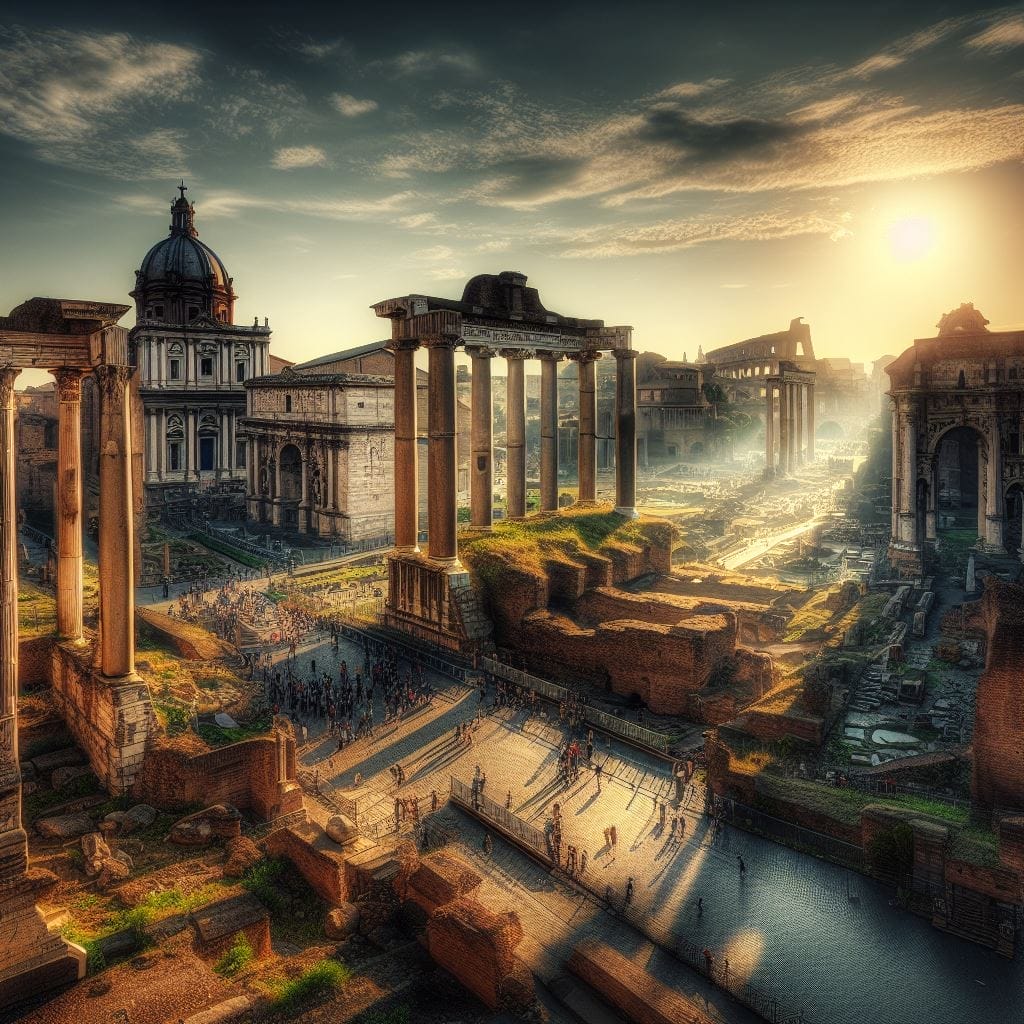
Serving as the most salient section of the processional route of Roman triumphs, the Via Sacra, the main street of ancient Rome, connected the Roman Forum to the Colosseum and other important sites. These triumphal processions were organized to celebrate Roman military victories, with the triumphal arches along the Via Sacra standing as enduring symbols of these momentous events. One such triumphal arch still captivates visitors today, showcasing the architectural prowess of ancient Rome.
As you walk along the Via Sacra, you are following in the footsteps of emperors, soldiers, and citizens who once traversed this ancient thoroughfare. The street’s significance in the Roman Forum is undeniable, as it not only connected important sites but also served as the stage for public events and celebrations that defined the spirit of ancient Rome.
The Via Sacra, with its rich history and connection to the Roman Forum, offers visitors a unique opportunity to experience the grandeur of ancient Rome. As you stroll along this ancient street, envision the triumphal processions of victorious generals and the jubilant crowds that lined its path, cheering on their heroes and basking in the glory of Rome’s past.
Visiting the Roman Forum: Practical Tips

Purchasing tickets in advance is recommended to make the most of your visit to the Roman Forum. This can be done online, allowing you to avoid long lines at the entrance. Additionally, wear comfortable shoes, as the ancient ruins and uneven terrain can be challenging to navigate. To avoid crowds and make the most of your time, plan to visit the Roman Forum early in the morning.
For an optimal visit, consider exploring the Roman Forum first, preferably in the afternoon, and then head to the Colosseum the following morning. This approach will allow you to fully immerse yourself in the history and significance of each site without feeling rushed.
Remember, the Roman Forum is a treasure trove of ancient history, and taking the time to explore its many wonders will undoubtedly enhance your appreciation for the incredible achievements of ancient Rome. With these practical tips in mind, you are well-prepared to embark on your journey through the Roman Forum and uncover the secrets of the Eternal City.
Exploring Nearby Attractions

After visiting the Roman Forum, you may be eager to explore more of ancient Rome’s fascinating landmarks. Nearby attractions include Palatine Hill, the Colosseum, and the Catacombs of Rome. Each site offers a unique glimpse into the life and culture of ancient Romans, providing a well-rounded understanding of the city’s storied past. The Colosseum is just 5 to 10 minutes away, on foot.
Palatine Hill, once home to Rome’s ruling classes, boasts an array of imperial palaces and offers some of the most impressive views of the Roman Forum. The Colosseum, an iconic symbol of ancient Rome, stands as a testament to the architectural prowess and entertainment culture of the time. Lastly, the Catacombs of Rome provide a fascinating and eerie insight into the subterranean burial practices of early Christians.
Exploring these nearby attractions not only deepens your understanding of ancient Rome but also creates lasting memories of your journey through the Eternal City. So, venture forth and discover the treasures that await you beyond the Roman Forum.
Guided Tours and Experiences

Reserving a guided tour can enhance your visit to the Roman Forum and help you gain a deeper understanding of its history and significance. Guided tours offer the advantage of time-saving and queue-skipping, as well as a more comprehensive knowledge of the site. Additionally, private guides are available for a more personalized experience.
For a truly immersive journey into ancient Rome, the Circo Maximo Experience offers a unique opportunity to explore the world of chariot racing through the use of Virtual Reality headsets. This 40-minute walking tour transports you back to the 1st century C.E., providing a glimpse into the thrilling and competitive world of the Roman Empire’s favorite pastime.
Several tour providers, such as Through Eternity Tours, offer guided walking tours of the Roman Forum led by highly knowledgeable archaeologists. These tours provide an unparalleled level of expertise and insight, allowing you to fully appreciate the incredible history and architecture that the Roman Forum has to offer.
Dining and Shopping Near the Roman Forum

A day of exploring the ancient ruins of the Roman Forum might leave you needing sustenance and perhaps a little retail therapy. Luckily, a selection of dining and shopping options can be found in the vicinity, offering a variety of cuisines and local products to enjoy after your visit.
Dining options near the Roman Forum include:
- Pizza della Madonna dei Monti
- La Prezzemolina
- Flor Gelato Italiano
- La Nuova Piazzetta
- Osteria Maracuja
These establishments offer a diverse array of culinary delights, ranging from traditional Italian fare to artisanal gelato, ensuring that your taste buds are just as satisfied as your sense of adventure.
For those interested in shopping, the following places near the Roman Forum provide a variety of retail options and unique local products:
- Galleria Alberto Sordi
- Leather Craftsman
- Outlet Roma
- Riverside Market
- Mercato di Via Sannio
Whether you’re searching for the perfect souvenir or wish to indulge in some day-to-day shopping, you’ll find plenty of options to choose from near the Roman Forum.
The Ongoing Excavation and Preservation Efforts
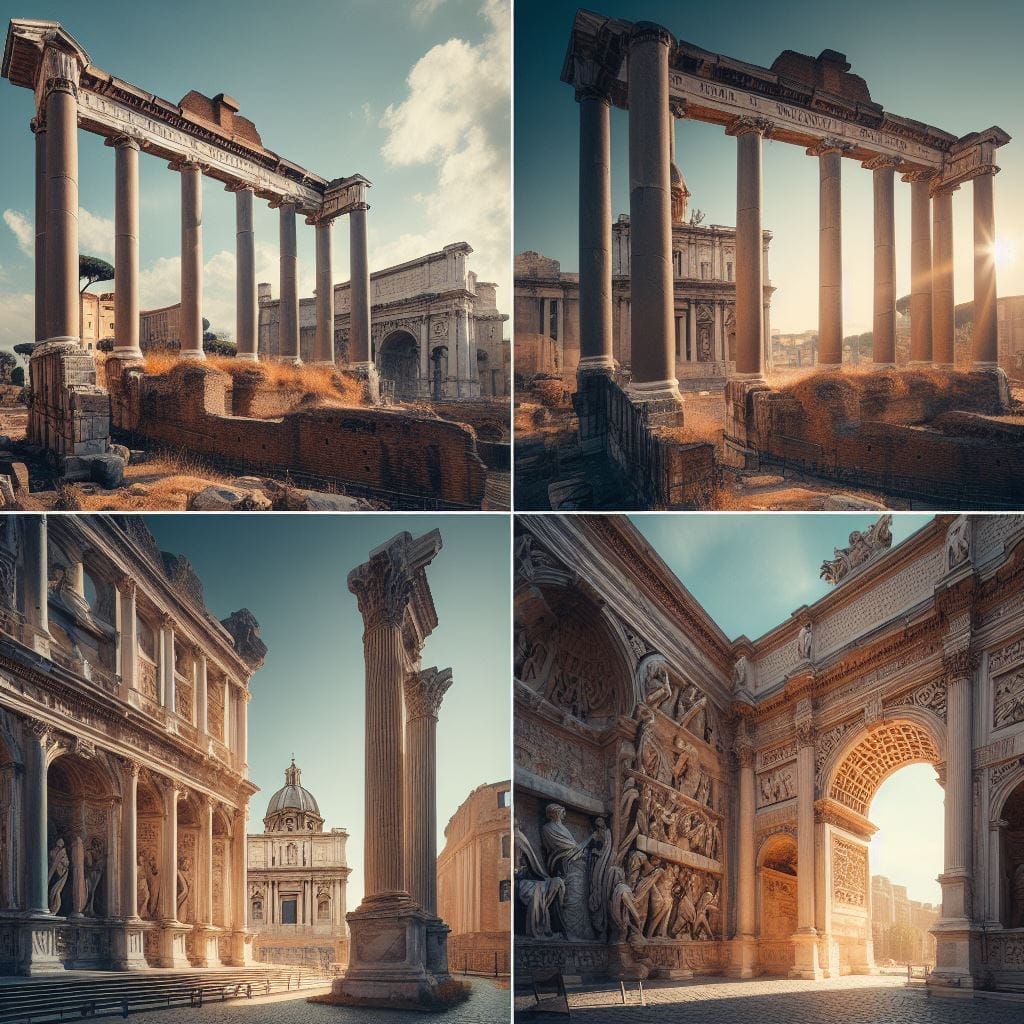
The rich history and architectural marvels of the Roman Forum continue to captivate the modern imagination, largely due to the ongoing excavation and preservation efforts at the site. These efforts not only uncover new discoveries but also ensure that the Roman Forum remains accessible and informative for future generations.
Archaeologists, researchers, and preservationists work tirelessly to study, excavate, and conserve the ancient structures and artifacts that make the Roman Forum such an important and enduring testament to the Roman Empire’s greatness. Their dedication and expertise have enabled countless visitors to experience the awe-inspiring history that lies within the forum’s ancient ruins.
Exploring the Roman Forum, take a moment to appreciate the ongoing excavation and preservation efforts that have allowed your journey through ancient Rome. Through their tireless work, the wonders of the Roman Forum will continue to inspire and educate visitors for generations to come.
In conclusion, the Roman Forum stands as a testament to the grandeur and importance of ancient Rome, providing visitors with an unparalleled glimpse into the political, religious, and social life of the eternal city. From its notable landmarks, such as the Curia Julia, the Rostra, and the Via Sacra, to the ongoing excavation and preservation efforts, the Roman Forum offers a unique and unforgettable experience. As you walk through the forum’s ancient ruins, embrace the opportunity to step back in time and immerse yourself in the rich history of the Roman Empire.
People also ask:
What was the roman forum known for.
The Roman Forum was the center of day-to-day life in Rome, hosting public meetings, law courts, gladiatorial combats, and open-air markets. It also served as a place for religious ceremonies, commerce and trade, elections, and public speeches.
What are 2 facts about the Roman Forum?
The Roman Forum was the center of public life in Ancient Rome and comprised two temples, the Temple of Saturn and the Temple of Castor & Pollux. It was also home to the Vestal Virgins and the world’s oldest shopping mall.
Is the Roman Forum worth seeing?
The Roman Forum was an area of immense cultural significance, with beautiful ruins from important religious, political, and economic buildings. Visiting it would certainly be worthwhile.
What was the difference between the Roman Forum and the Imperial Forum?
The Roman Forum was less organized compared to the Imperial Forum, which had a logical and homogeneous organization of spaces. It was also isolated from the rest of the city and structured around five large arcaded squares, giving it a distinct unitary architectural whole.
What was the Roman Forum’s main purpose in ancient Rome?
The Roman Forum served as a central hub for politics, religion, commerce, and social life in ancient Rome.
Related Posts
Subura, a bustling and lively neighborhood in ancient Rome, has long captivated historians and travelers alike with its rich history and vibrant atmosphere. As you delve into the nuances of…
Below you find the layout of camp of a Roman army on the march. Every night the legion would halt and erect a camp in this layout. As every Roman…
The Power of Enfranchisement At the heart of Rome's expansion was its unique strategy of 'enfranchisement', extending the rights and privileges of Roman citizenship to conquered territories, notably throughout Italy…

The Roman Forum..
Home » Attractions » Roman Forum
The Roman Forum in Rome

- - Updated on Februar 14, 2024
The Roman Forum was once the center of power of the Roman Empire. Today, numerous ruins of ancient buildings reflect the impressive architecture and the opulent economic conditions of the empire.
Walking the excavations along the gigantic columns and wall remains, you get an impressive sense of Roman architecture’s brilliance.
The Roman Forum in Rome was the first Roman Forum. During the time of Emperor Augustus (27 B.C. to 14 A.D.), far-reaching political decisions were made here.

It was also used to transact business, issue indictments, and worship religious shrines such as the Temple of Vesta. For more info about Roman Forum tickets , click here.
Many politically and legally significant decisions were made in the Forum. However, the excavations of one of the most valuable attractions of Rome began only at the beginning of the 19th century.
For example, the Triumphal Arch of Septimius Servus was fully excavated from 1803 to 1898. Even today, archaeologists worldwide continue to come across extraordinary finds in the extended area of the Roman Forum.
For example, the sarcophagus of the former founder of the city, Romulus , dating from the 6th century B.C., was probably found only recently.
Many ancient buildings had to regrettably give way in the 7th century. Even today, some ancient buildings have witnessed moderately severe earthquakes in contemporary history. In addition, large quantities of travertine stones were used repeatedly for massive building projects such as St. Peter’s Basilica .
Visitor Information:
Address: Via della Salara Vecchia, 5/6, 00186 Roma
Transportation: Metro station: Colosseo, line B Bus: lines 51, 75, 81, 85, 87 and 118 to the “San Gregorio” stop
Opening hours: October 31st – February 28th: 09:00 am – 16:30 pm March 1st – 26th: 09:30 am – 17:30 pm March 27th – August 31st: 09:30 am – 19:15 pm September 1st – 30th: 08:30 am – 19:00 pm October 1st – 30th: 08:30 am – 18:30 pm closed: January 1st & December 25th
Nearby: Colosseum (0,1 km) Palatine Hill (0,4 km) Domus Aurea (0,5 km) Circus Maximus (0,7 km)
Recommended exploration time: 1 – 2 hours
Roman Forum Tickets are generally only bookable together with the Entry to the Colosseum & Palatine.
Roman Forum Tickets:
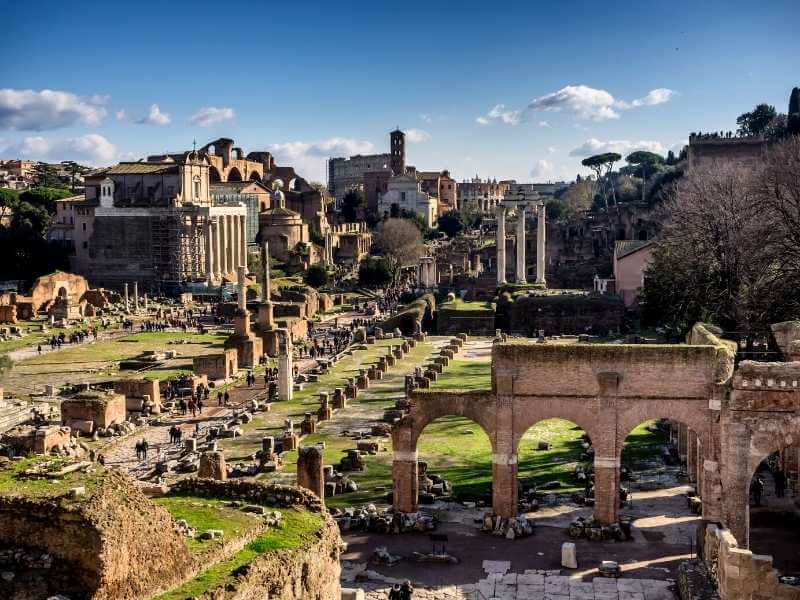
Roman Forum Tickets + Guided Tour:

Our hotel recommendations at the Colosseum:
Have you already found a suitable hotel? We have researched the best hotels nearby! -> Hotels close to Colosseum Rome
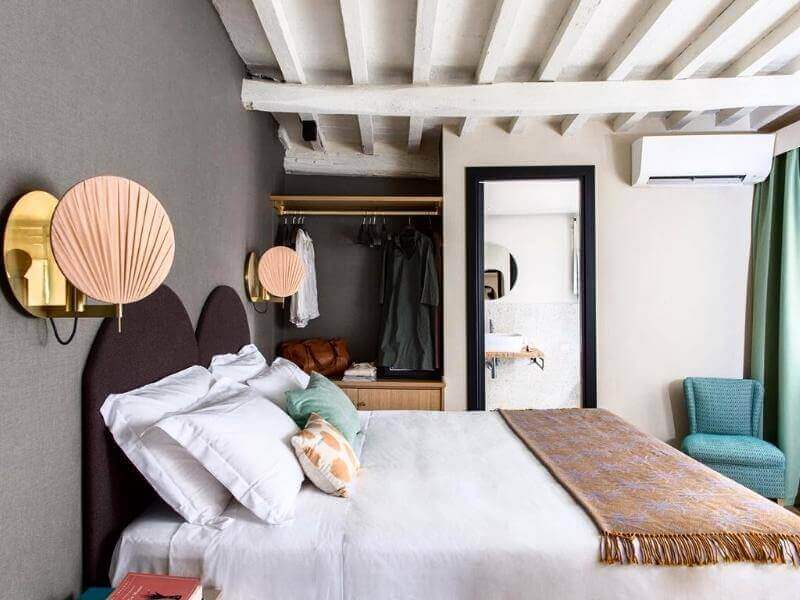
Condominio Monti
Rating: 8.8 (Excellent)
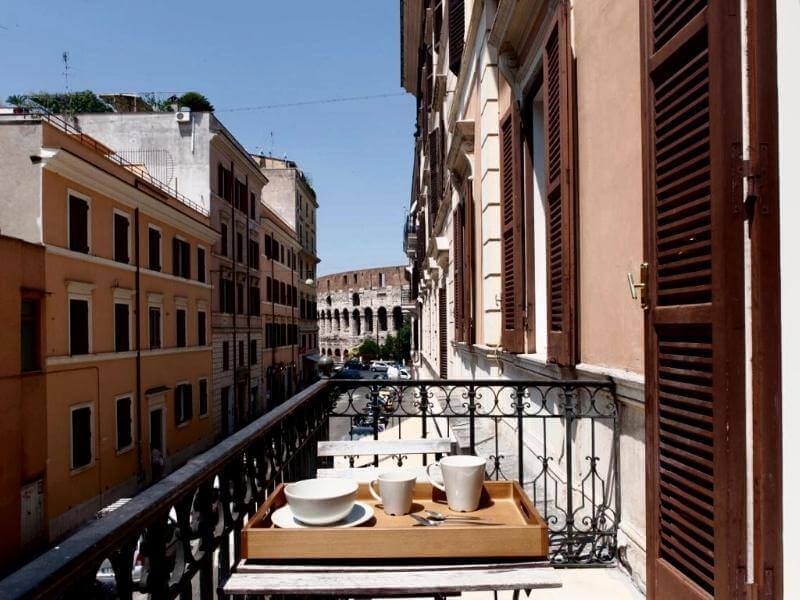
B&B Santi Quattro Al Colosseo
Rating: 8,7 (Excellent)
Some of the highlights in the Forum:
The Forum offers a few other highlights besides the large number of ancient temples:
- Arch of Titus : The triumphal arch commemorates Rome’s victory over Jerusalem. It was built after the death of Emperor Titus.
- Arch of Septimius Severus : An arch erected in 203 AD to commemorate the third anniversary of Septimius Severus as emperor.
- Temple of Saturn : Once the most magnificent temple in the entire Forum. First built in 497 BC.
- Temple of Antoninus and Faustina : Built in the 2nd century, the Temple of Antoninus and Faustina is the best-preserved temple in the entire Forum.
- Basilica of Maxentius and Constantine : one of the most important buildings of antiquity, today unfortunately largely destroyed
- The Curia : Senate building for political meetings.
- Column of Phokas : erected in 608 A.D. in honor of the Emperor of Byzantium (height: 13 meters).
The History of the Roman Forum
Today, as you walk through the grounds of the Roman Forum and pass the mighty ruins, you can sense the splendor and glory surrounding this place.
But this was only sometimes the case. At first, only the three city hills, Palatine, Capitol, and Esquiline, were inhabited. At the edge of the valley, there was also a burial place of the Romans.
Only in the construction of the Cloaca Maxima in the 6th century B.C. was the area around the Roman Forum drained. The later Forum gradually developed into the first settlement from the initial marshy area.
The first temples were dedicated to the gods Saturn and Castor. They were built between the years 501 and 498 B.C. It was not long before the new temple complexes became the meeting place of many Romans.
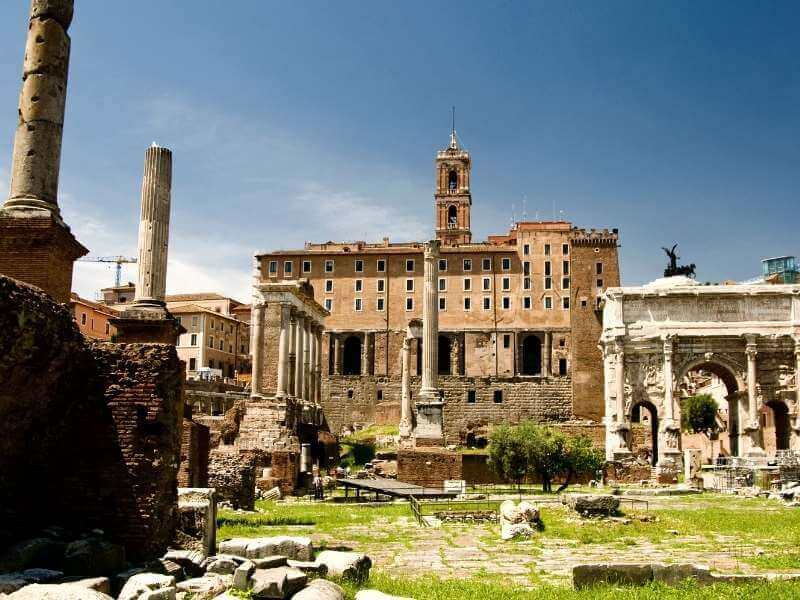
Under Caesar’s rule, the Romans rapidly expanded the ancient city center starting in 54 B.C. According to his plans, the new Forum was to be located directly at the foot of Capitol Hill and expand the Old Forum many times. Its shape was to be rectangular, as was the case with the public squares of Greece.
Striving for the best possible fame, Caesar eventually had the imperial fora we know today built:
- The Caesar Forum (Foto di Caesare) -> Here, a multimedia show on the person of Julius Caesar is shown in the evening.
- The Augustus Forum (Foro di Augusto) -> a multimedia show about ancient Rome , is shown in the evening.
- Forum of Vespasian with peace temple
- Trajan’s Forum (probably the most impressive Forum)
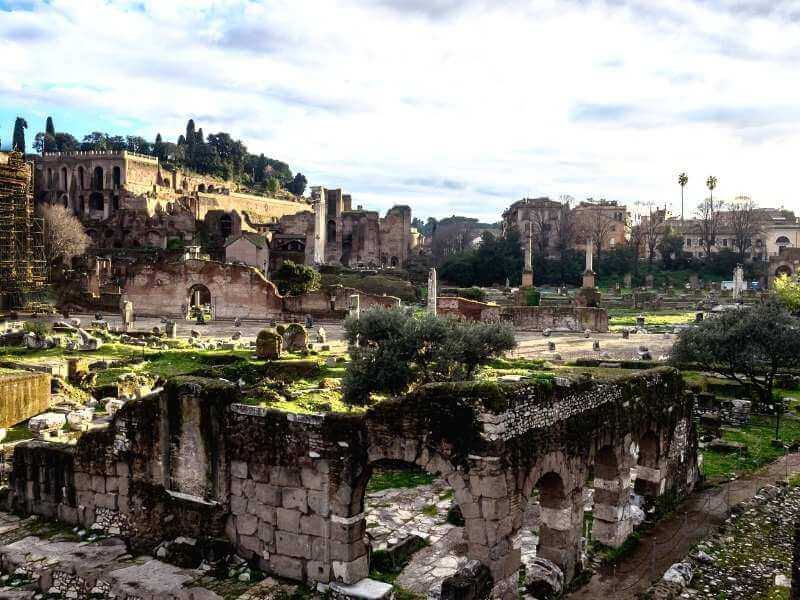
Only about 50 years later, the reconstruction of the Roman Forum was to continue under Emperor Augustus. The wooden huts that had been built up to that point had to make way for new temples made of marble. In addition, there was a large-scale expansion on the square’s east side.
The transformation of the center bore fruit. More and more Romans were drawn to the Forum. From here, they exchanged ideas and conducted politics. Incidentally, the infamous Catilinaric speeches against Catilina are said to have occurred here!
But not only the temples fulfilled their task with flying colors. In the basilicas, much trade and all kinds of business were done. Important raw materials such as wood, iron, and many other trade goods were exchanged.
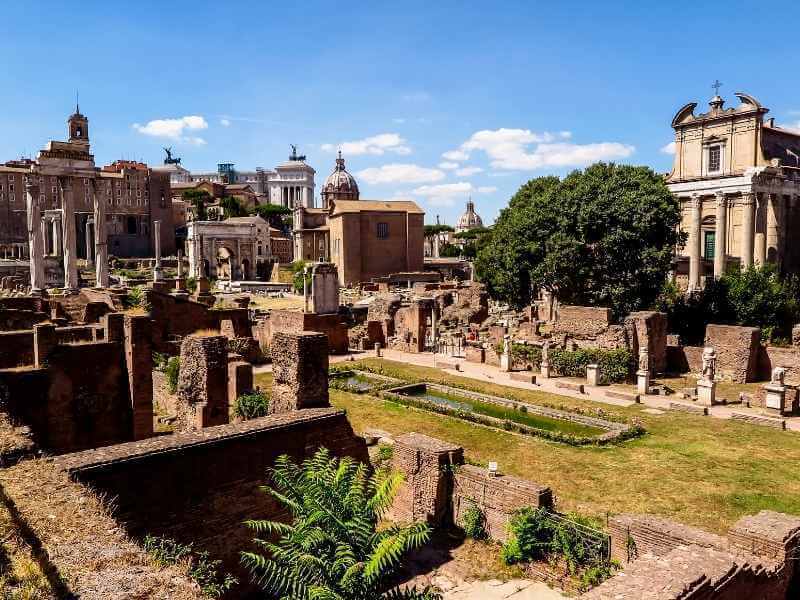
But the rapid upswing of the Forum came to an end. Under Emperor Augustus’ successors, the Forum was increasingly regarded as uninteresting in the following years. It needed to be more significant compared to newly won territories. In addition, Rome lost its political significance, so in 330 A.D., Emperor Constantine the Great already preferred Constantinople as his new residence.
At the latest, with the collapse of the Roman Empire, the Roman Forum was finally forgotten. The once magnificent square of the Eternal City gradually turned into a cow pasture. Over time, many of the stones were to give way to new cathedrals and palaces.
How to get to the Roman Forum in Rome
The most beautiful view of Rome’s former center of power is from Palatine Hill , just opposite the Forum. The best way to get there is to take the old main road “Via Scara,” which means “holy road.” Via Scara led from the Colosseum to Piazza del Campidoglio, Rome’s main street.
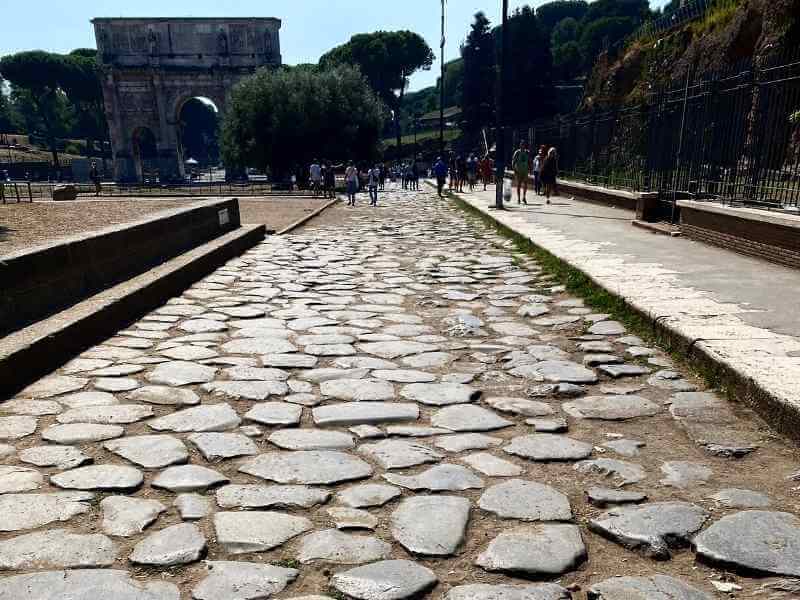
On the south side, on your left, there are the enormous ruins of the ancient court hall, the Basilica Iulia. This was commissioned by Caesar between the years 54 B.C. – 44 A.D.
However, the church was not completed until years later under his successor, Emperor Augustus. The 101 x 49-meter basilica was the largest church in the Forum and regularly attracted large crowds of Romans, especially on trial days.
Just opposite the Basilica Iulia, you will see the Basilica Aemilia, built in 179 BC. Following Via Scara, you will see other ancient monuments such as the Arch of Titus, the Triumphal Arch of Septimus Severus, the churches of Maxentius and Curia, the temples of Antony and Faustina, the Capitol Temple, and the ruins of the market halls and oratory tribunes.
Palatine Hill
According to legend, Romulus founded Rome in 753 B.C. on the Palatine Hill. The Palatine (palatium, imperial residence) is considered the city’s origin and is located in the center of the 7 hills of Rome. Besides many excavations, you will find some interesting buildings like the Domus Augustana (Emperor Augustus), the museum with exciting finds and interesting models of the first settlement, and the gardens of Cardinal Alessandro Farnese (16th century).
The hill is surrounded to the west by the Velabrum Valley and the Forum Boarium, to the south by the Circus Maximus , and to the north by the Forum Romanum. According to tradition, a Roman settlement was here as early as the 9th century B.C.
The Colosseum, as well as the Roman Forum, are in the immediate vicinity. So it makes sense to visit all three sights one after the other.
The 43-meter-high Palatine, with its archaeological excavations, is just a stone’s throw away from Rome’s ancient highlights. The Roman Forum ticket gives you access to the archaeological park on the Palatine and can be used as a Colosseum ticket simultaneously.
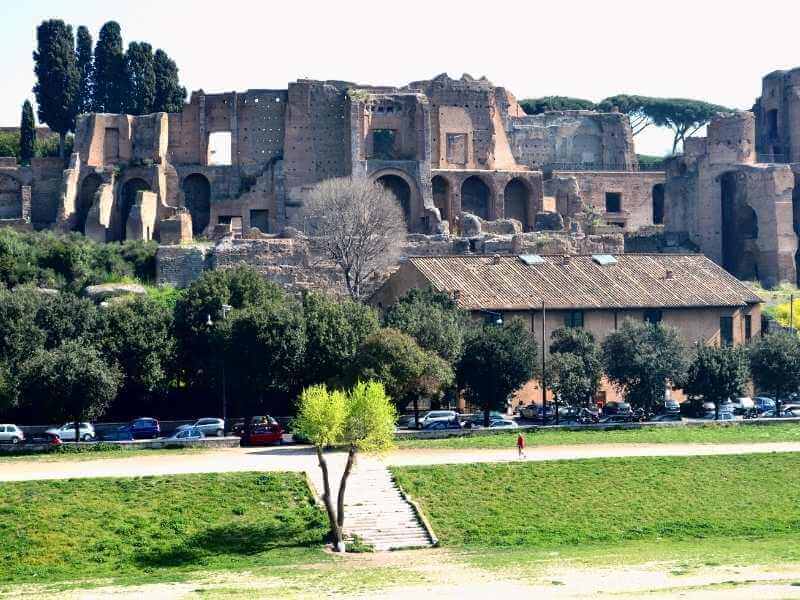
How to get to the Roman Forum, Rome:
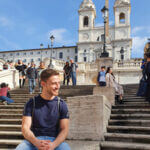
Editor: Sebastian Erkens Hey and welcome to Rome-Tourist! My name is Sebastian and I travel regularly to Rome, Italy. On our Rome blog you will get valuable travel tips. If you have any questions about specific tours or sights, feel free to leave us a comment.
These articles may also interest you:
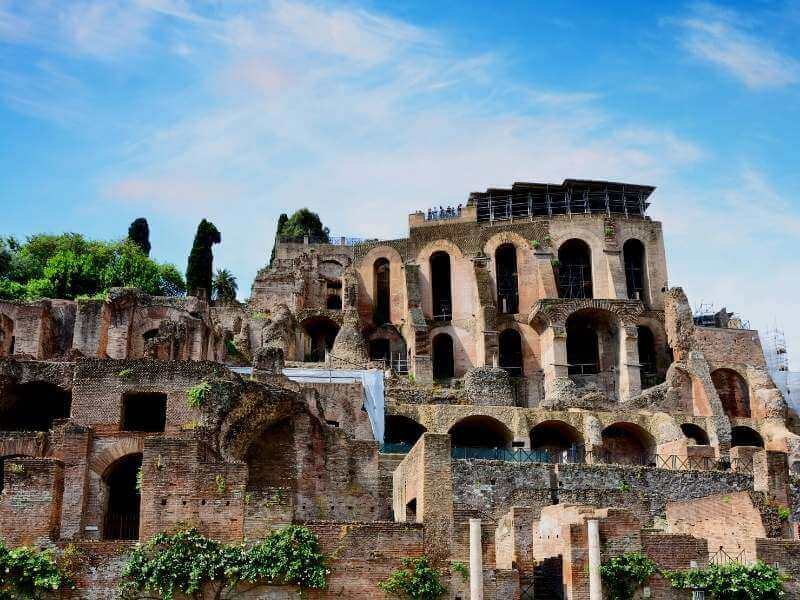
RELATED LINKS
On this page, colosseum & roman forum, major rome attractions, rome's best..., transport, tours & passes, outside rome.

- Rome hotels
- Venice hotels
- Florence hotels
- Naples hotels
- Pisa hotels
- Sorrento hotels
- Rome Fiumicino Airport
- Rome Ciampino Airport
- Venice Marco Polo Airport
- Pisa Airport
- Naples Airport
- Civitavechia (Rome) Cruise Port
- Naples Cruise Port
- Rome public transport
- Venice water bus (vaporetto)
- Florence public transport
- Naples public transport
- Sorrento local buses beyond Amalfi
Visit Roman Forum and Palatine Hill
Roman forum, palatine hill and colosseum tickets, entrance gates and tours.
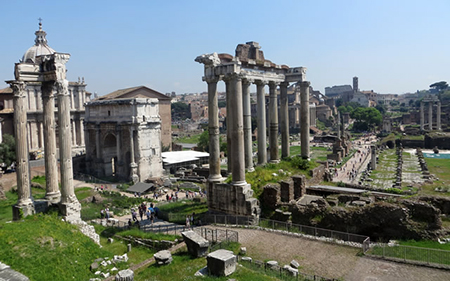
The Roman Forum (Forum Romanum) and the Palatine Hill are located in the same archaeological area and count as one admission.
The Roman Forum and the Palatine Hill are adjacent to each other and you can walk freely between the two. Both the Roman Forum and Palatine Hill have separate entrances.
The entrance ticket also gives you entrance to the Colosseum next to both and is valid for two days covering all three attractions.
About the Roman Forum Forum tickets & opening hours Buy fast track tickets Forum recommended route Roman Forum - what to expect Roman Forum & Colosseum walking tours
Roman Forum - what is it?
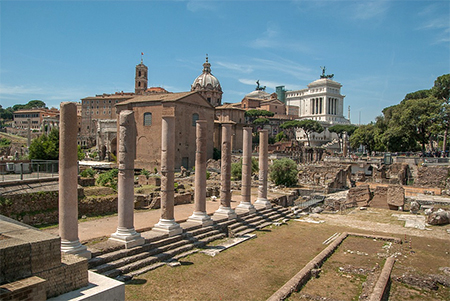
A walk around the Roman Forum is to glimpse into the founding of the ancient Roman Empire.
From what was marshland the Romans drained the area and turned it into a centre of political and social activity. The Forum was the marketplace of Rome, and later a gathering space for triumphal processions, criminal trials and gladiatorial matches.
The Roman Forum was home to some of the oldest and most important buildings in the ancient city – what you will see today is a mass of ruins, including shrines and temples, such as the House of the Vestal Virgins. The most ancient monuments at the Roman Forum are from the first kings of Rome, dating back to the sixth century BC.
The Forum was then abandoned some time in the Middle Ages, and over time, buried under layers of earth, Some temples were transformed into churches, allowing their preservation in the course of time.
During the Renaissance the area of the Forum Romanum was used as a marble and stone quarry. However, it was not until 1898 that excavations began to be carried out, revealing what we see today.
Top of the page
Roman forum - tickets, opening hours and time slots.
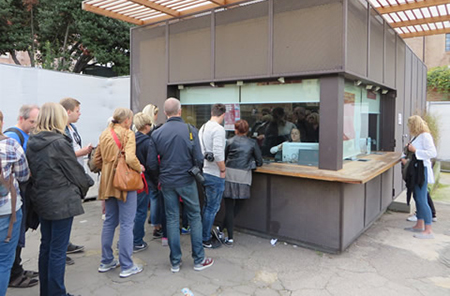
Time slot entries are now in place at the Colosseum/ Roman Forum. You are required to select your time slot in advance. You will receive a confirmation email upon booking and and on your voucher you can read how to reserve your time slot. Although you can do this at the Colosseum Ticket Office, it is sensible to do this online in advance because otherwise there is no way of securing your preferred date and time.
The standard admission ticket covers all three monuments, the Colosseum, Roman Forum and Palatine Hill.
Opening hours are from 8.30am to one hour before sunset, exact times are again on the link below:
Opening hours Colosseum + Roman Forum
You can gain Colosseum and Roman Forum entrance by:
Arriving first thing and queuing for a time slot later the same day or later that week (although still possible, this is risky because you are not guaranteed entry on the day you wish due to demand)
Buying a skip the line ticket avoiding the queues in advance for a supplement
Gaining entry using the Roma Pass
By guided tour as part of a group
Note : Within the Colosseum, there are parts you can only visit as part of a “special access” guided tour (see section below) for which the standard ticket has no validity.
Free Entrance:
Free entry on the first Sunday of the month (no reservation possible) – expect long queues
Free entry for those under 18 and discounted tickets for EU citizens aged between 18-25.
Free for EU citizens with disabilities and their companion, with valid medical documentation of the disability
Dedicated page covering all types of tickets for Colosseum and Roman Forum
Colosseum and Roman Forum - skip the line/fast track entrance tickets
Skip the Queue/ Fast Track tickets can be purchased in advance on-line with immediate delivery of tickets by e-mail.
Fast track Colosseum ticket - option 1
One fast track entry to the Colosseum and one entry to the Roman Forum/Palatine Hill
Escorted entry into Colosseum at selected time slots available throughout day
COLOSSEUM, ROMAN FORUM & PALATINE HIL VIP ACCESS 2-DAY ENTRANCE TICKETS
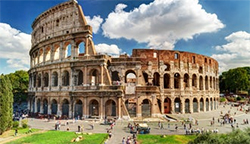
• Fast track entry Colosseum/ Roman Forum + Palatine Hill • Choice of time slots all day • Option to add Gladiator's arena • Audio guide available • Choose from independent entrance ticket or small group tour
Fast track Colosseum ticket - option 2
Entrance through fast track entrance gate with later time slots than option 1
• Fast track entry Colosseum/ Roman Forum + Palatine Hill • Later time slots than option one • Tickets are valid for 2 days after your first visit at the selected date • Free audio guide available
Visiting the Colosseum, Roman Forum & Palatine Hill - entrances and recommended route
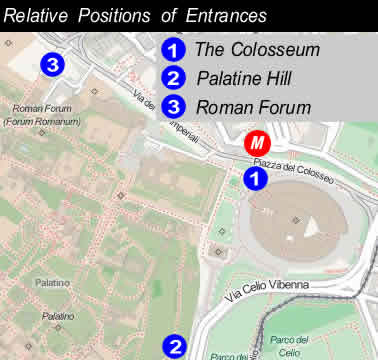
Main entrance
The main entrance gate for the Roman Forum is along the Via die Fori Imperiali between the Colosseum and Piazza Venezia, near the Piazza Venezia end. There is an exit gate from the Roman Forum close to the Colosseum. You cannot enter the Roman Forum at the gate nearest the Colosseum, this gate is just an exit.
The natural flow of a visit is to exit the Roman Forum at the Colosseum end of the site. You cannot enter or re-enter at this gate though. There are also exits at the Capitoline Hill end of the site, but again no entrance. The Palatine Hill towering above you is also linked both ways to the Roman Forum.
Where are the shortest queues?
The ticket kiosk at the Colosseum has by far the longest queues; we suggest you start and buy your ticket at the Palatine Hill entrance.
The ticket gate for the Palatine Hill often has no queues at all and is midway down the road Via di San Gregorio that runs from the Colosseum along the base of the Palatine Hill less than 5 minutes' walk from the Colosseum. Many of the hop-on hop-off sightseeing buses and tour buses board and drop between the Colosseum and the entrance to the Palatine Hill.
From the Palatine Hill entrance, walking uphill exploring the Palatine Hill is more gradual than from the Roman Forum and has more shade. After performing a circuit of the Palatine Hill you will get a great birds' eye view down onto the Roman Forum as you descend into it, getting a good initial orientation in the process.
The entrance of the Roman Forum is a long way from the Colosseum, but there is an exit only gate right next to the Colosseum.
Roman Forum - what to expect and facilities
The Roman Forum is a large area to cover with little shade, so do bring along plenty of fluids.
Another thing to bear in mind is that there are no food outlets at the Roman Forum. If you have, for example, spent the morning at the Colosseum and you go straight on to the Forum, be prepared to have a later lunch by the time you have walked round this ancient site.
Time needed to visit the Roman Forum
Most people allow a half day to visit the Roman Forum and Palatine Hill with the Colosseum. If you have a real interest in the subject matter you will need a day.
Your ticket allows you to see all three parts over two days (re-entry is not permitted) so you could take a more leisurely approach visiting the Colosseum on a separate day to the Roman Forum and Palatine Hill.
Colosseum & Roman Forum walking tours
Taking a walking tour with an expert guide with headphones and fast track entrance tickets provided is an efficient and cost effective way of covering the Colosseum, Palatine Hill & Roman Forum in around 3 hours.
Option 1 - Colosseum, Palatine Hill & Roman Forum walking tour
Skip-the-line access to the Colosseum, Roman Forum, and Palatine Hill
Groups of 25 people or fewer
Departure times available morning or afternoon
Informative, friendly and professional guide, headphones available
SKIP THE LINE: COLOSSEUM SMALL GROUP TOUR WITH ROMAN FORUM & PALATINE HILL
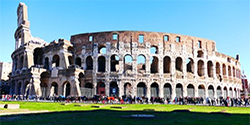
• Fast track entry Colosseum/ Roman Forum + Palatine Hill • 3-hour tour • Expert guide • Small group tour
Option 2 - Colosseum, Palatine Hill & Roman Forum walking tour with special access
With access to the Colosseum arena floor, the underground chambers and the third tier
Small groups of 12 people or fewer (select option after choosing date)
Departure times available morning or afternoon but limited availability
SKIP THE LINE: COLOSSEUM SMALL GROUP TOUR WITH ROMAN FORUM & PALATINE HILL WITH
Special access.
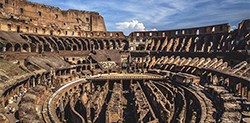
• Fast track entry Colosseum/ Roman Forum + Palatine Hill • With special access to higher levels & underground chambers • 3-hour tour
(Price shows after selecting date)
Ancient Rome walking tours including the Colosseum, Palatine Hill & Roman Forum
The Colosseum, Palatine Hill & Roman Forum are just one part of ancient Rome.
This tour also includes top icons the Pantheon and Piazza Navona (Roman circus).
On this small group tour with a maximum of 18 people you can be sure to have just the right amount of attention from your guide.
ANCIENT ROME WALKING TOUR + SKIP-THE-LINE COLOSSEUM
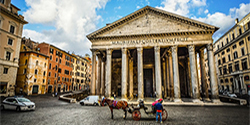
• Fast track entry Colosseum/ Roman Forum + Palatine Hill • Pantheon and Piazza Navona • Small group tour • Professional guide
MOST POPULAR ROME TOURS 2024
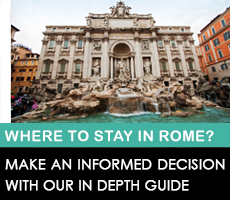

Visiting the Roman Forum: 10 Highlights
Written by Barbara Radcliffe Rogers Updated Dec 25, 2023 We may earn a commission from affiliate links ( )
Few sites are so filled with a sense of history as the Roman Forum (Foro Romano), where, for many centuries, the fate of Europe was decided. Although the surviving remains give only a hint of the grandeur and splendor of the Forum in ancient times, this area, with its columns still standing tall or lying tumbled on the ground, its triumphal arches, and its remains of once-important buildings, are still impressive even to 21st-century visitors.
The Forum is so vast, and often crowded, that it's difficult to make sense of it or know what happened where. That's why a tour using a headset with an expert guide is helpful, so you can listen as you snap photos and appreciate the grandeur of one of Rome's most popular and important tourist attractions .
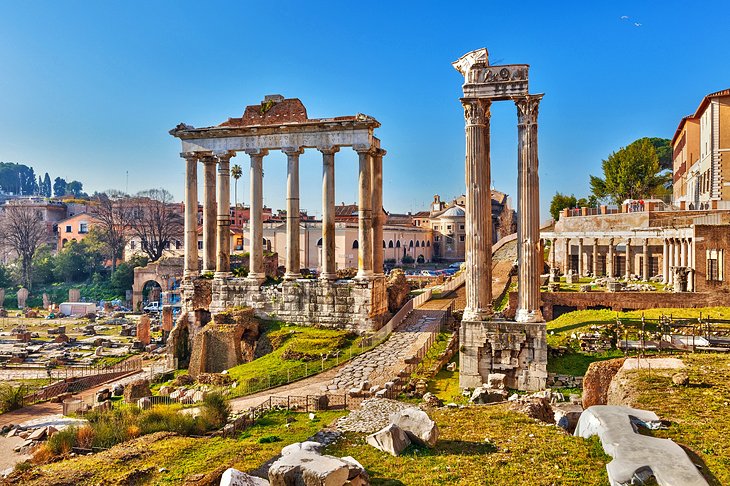
For more than a thousand years, the might of Rome, the magnificence of Roman art, and Roman law and religion found expression here and radiated throughout Europe and beyond. The first buildings here were temples, followed by public buildings.
This combination soon made the area the political center of the city–the meeting place of the courts and the assemblies that directed the affairs of the republic. Commerce soon joined religion and government, with the building of market halls that made the Forum the center of all public activity, not just for Rome, but for an increasingly large part of the continent.
By the end of the Imperial Period, the Forum was a densely built-up complex in which "modern" buildings rubbed shoulders with ancient ones, making it difficult today to identify individual buildings. This is further complicated by layers of later churches and fortresses that were built amid the ancient remains. The area served as a quarry of building stone and a cow pasture until 18th- and 19th-century excavations uncovered the Forum from a layer of dirt and rubble as deep as 15 meters.
See also: Where to Stay near the Roman Forum
1. Arch of Titus
2. basilica of constantine, 3. the curia, 4. temple of romulus, 5. temple of vesta & house of the vestals, 6. arch of septimius severus, 7. temple of saturn, 8. temple of castor and pollux, 9. temple of antoninus pius, 10. via sacra, where to stay near the roman forum, tips and tours: how to make the most of your visit to the roman forum, getting to the roman forum, nearby attractions, restaurants and cafés nearby, shopping nearby, map of the roman forum: highlights.
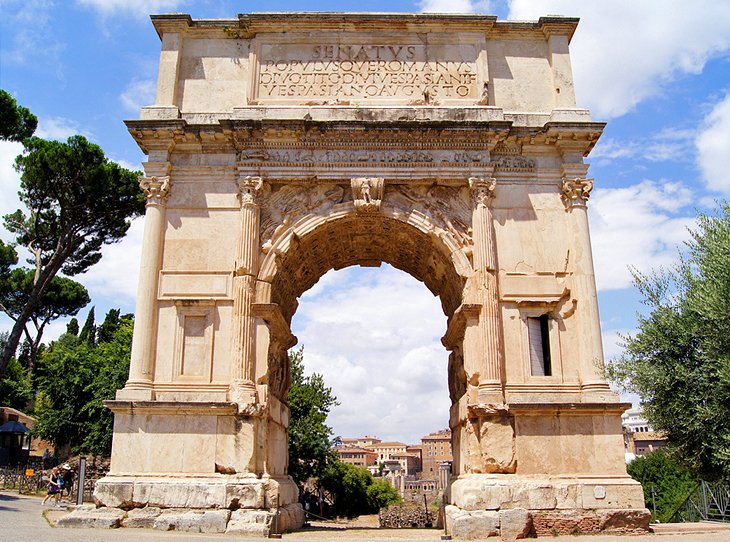
Standing at the end of the Forum farthest from the Capitol, the Arch of Titus is the oldest of the Roman triumphal arches, erected after the death of Titus by his successor Domitian. The reliefs on the arch show scenes from the victorious general's triumphal procession to the Capitol after Titus captured Jerusalem in the year 70 and thus put the final seal on the defeat of the Jewish people in Palestine.
Titus, who became Emperor in 79 AD, is shown in his chariot accompanied by the goddess of Victory holding a laurel wreath and by the booty brought back from the war - the Menorah, the table with the shewbread, and trumpets from the treasury of the Temple.
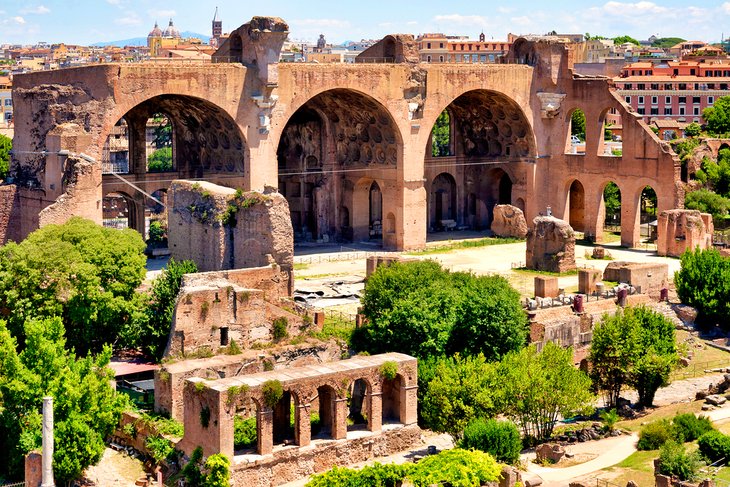
Only three soaring vaulted arches remain of what was the largest building in the Forum, but the Basilica of Constantine is still an imposing structure that towers over its surroundings. Finished by the Emperor Constantine in 303, it was begun by his predecessor, Maxentius.
The huge arched vaults still cover the remaining structure without support, an indication of the remarkable building skills of the Romans. A basilica in Ancient Rome was a courthouse and a place to make business and other transactions, with large central spaces flanked by apses, an architectural style later carried into Christian churches.
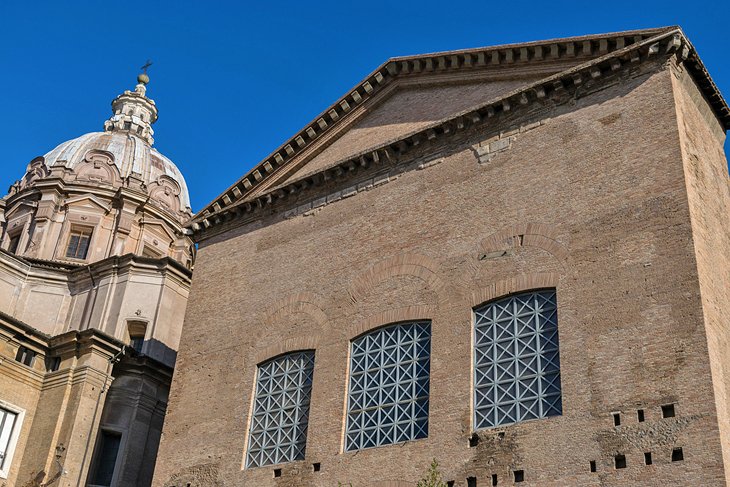
The meeting-place of the Roman Senate is one of the best preserved ancient buildings in the Forum, protected from further destruction when it was converted into a church in the seventh century. The first Curia was erected in the time of the kings and rebuilt frequently as a result of fires and other damage.
A plain and unornamented building, both inside and outside, it could seat 300 senators. Borromini adapted its bronze doors to serve as the main doorway of St. John Lateran , and the changes made to it over the centuries were stripped off between 1931 and 1937. It is now sometimes used for special exhibitions and preserves its inlaid marble floor from the third century, along with fragments of friezes.
The Anaglyphs of Trajan , two travertine slabs with reliefs depicting the emperor and the people of Rome, are displayed here. Outside the Curia and protected by a low roof is a block of black marble under which, according to legend, is the tomb of Romulus, founder of Rome. Opposite the Curia is the "newest" remnant from ancient times, the Column of Phocas , erected in 608.
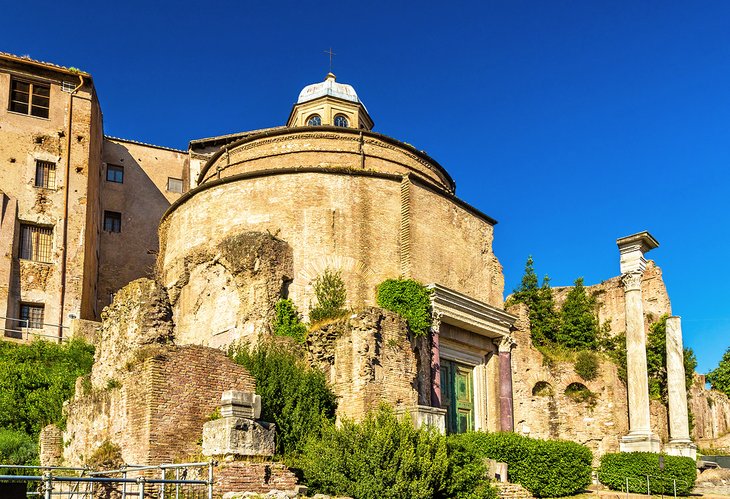
Among the best-preserved buildings in the Forum, the temple was dedicated by the emperor Maxentius to his son Valerius Romulus in 309 CE. The temple was later converted into a church, the Basilica of Santi Cosma e Damiano, which accounts for its state of preservation.
The bronze doors are the originals, and some of the 13 th -century wall paintings inside imitate the draperies that covered the walls when it was a temple. Other wall paintings are religious in nature and also date to the 1300s.
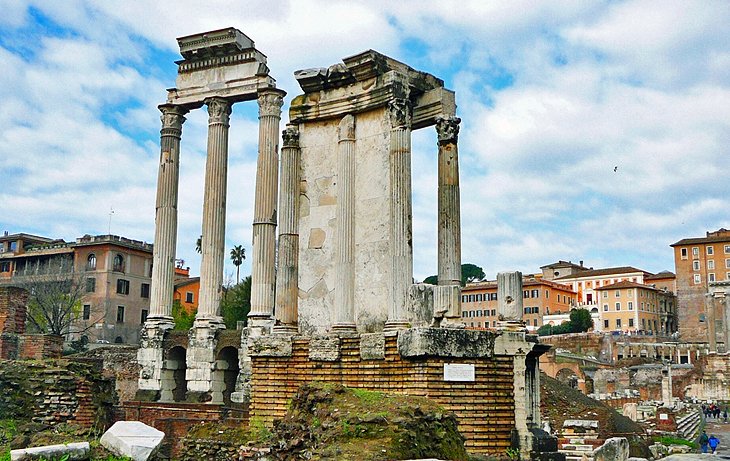
One of the most holy and important buildings in ancient Rome, the Temple of Vesta contained the Sacred Fire. The flame was guarded by the Vestals, six priestesses selected as children from the best families in Rome. This eternal fire was of great importance in Rome. On the first day of the new year, they put out the fires in their houses and lit new ones from the flame in the temple of Vesta.
The present remains, dating from the time of Septimius Severus, between AD 193 and 211, indicate that the temple was circular with 20 slender columns supporting the roof. An opening in the center of the roof let out the smoke from the sacred flame. The temple was mostly intact until the mid-16th century, when it was torn down and its marble used to build papal palaces and churches. What you see today was reconstructed in the 1930s during Mussolini's drive to reclaim Italy's ancient grandeur.
Adjoining the Temple of Vesta was the house of the Vestal Virgins, also built by Septimius Severus. You can still easily make out the plan of the building from the remains of its foundations. In the courtyard are the statues of the head vestals with inscriptions of their virtues on the pedestals. The sacred Palladium, an image of Pallas Athene brought by Aeneas from Troy, was kept in the House of the Vestals.
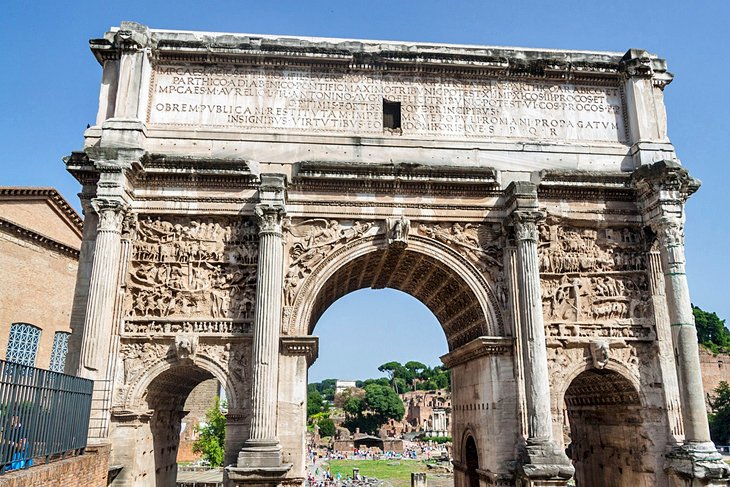
The Roman Senate and populace traditionally constructed triumphal arches honoring victorious emperors and generals, and in AD 203, this 23-meter arch was erected opposite the church of Santi Martina e Luca, to Septimius Severus and his sons Caracalla and Geta after their victories over the Parthians. On the arch, four deep marble reliefs represent episodes from these wars. Goddesses of victory hold trophies, and a large inscription proclaims the glory of the emperor and his sons (though the name of Geta was later removed).
The arch also features the base of a column commemorating the 10th anniversary of Diocletian's accession and the remains of the Rostra, the ancient orators' platform originally decorated with the prows of captured enemy ships. The arch was considered the spot of the Umbilicus Urbis, the navel or symbolic center of Rome.
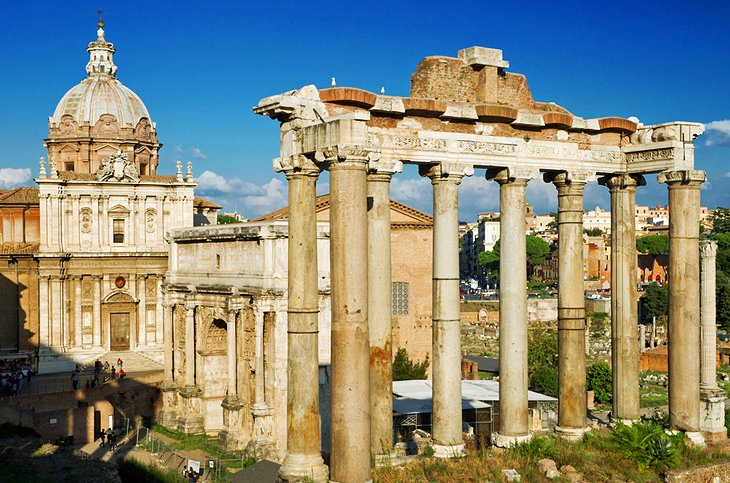
Built about 497 BC, the Temple of Saturn was one of the most important and venerated of the Republic. The first temple in the Forum, it was dedicated to the god that was probably of Etruscan origin but adopted by the Romans as the supreme god. It was destroyed by fire several times, the last in the fourth century AD, but was repeatedly rebuilt.
Under the Republic, the state treasury was kept in this temple, and annual celebrations of the Saturnalia started from here. You can recognize the Temple of Saturn by its eight weathered Ionic columns.
Adjoining the temple is a fragment of the Miliarium Aureum , the Golden Milestone, which was the starting point of the Via Sacra and all the Roman consular roads. On the stone, in golden figures, were inscribed the distance from Rome to the various provinces of the Empire.
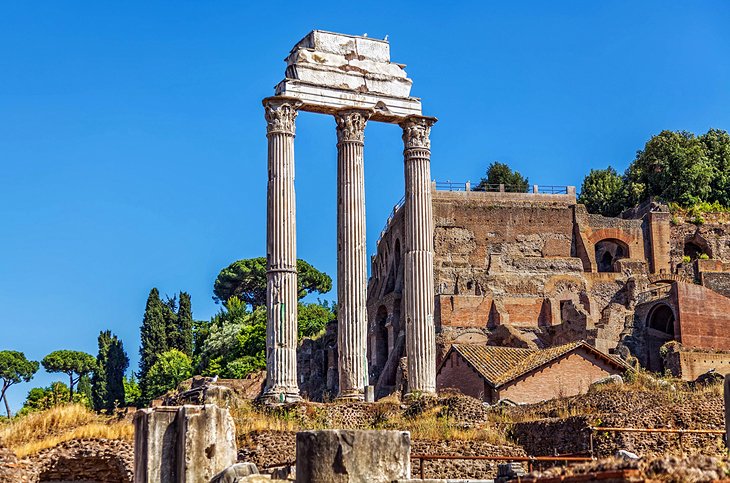
Three 12-meter Corinthian columns are all that survive from the Temple of Castor and Pollux , rebuilt in the reign of Tiberius in the first century AD to replace the original, built in 484 BC by the son of the dictator Aulus Postumius in thanks for the defeat of the Tarquins.
This victory was attributed to the help of the Dioscuri - Castor and Pollux, who were the subject of numerous myths, partly of Greek and partly of Etruscan origin. A legend held that after the victory, Castor and Pollux rode to Rome and watered their horses at a spring in the Forum. The three remaining columns are known popularly as The Three Sisters.
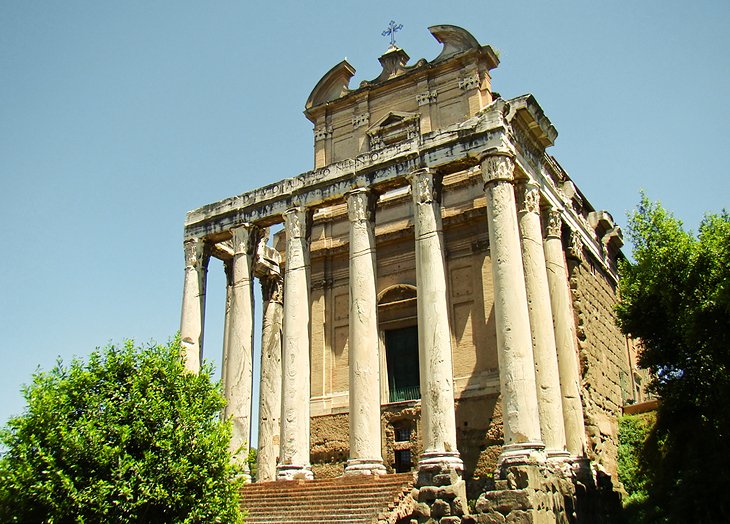
From the Via Sacra, steps leads up to the Temple of Antoninus Pius and his wife Faustina, built in AD 141 to honor the deified empress, and after his death, co-dedicated to him. Six columns with Corinthian capitals survive from the front, along with a number of columns along the side.
In the 12th century, the temple was converted into the church of San Lorenzo in Miranda, but when the Emperor Charles V visited Rome in 1536, the columns were disengaged from the medieval masonry.
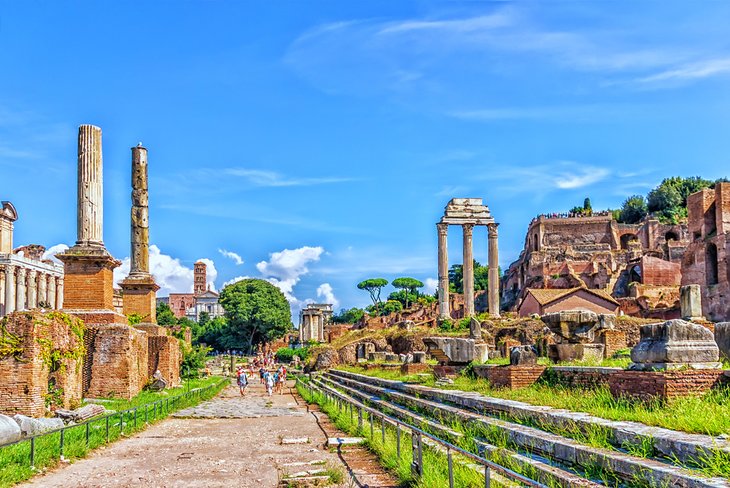
Passing under the Arch of Titus and through the Forum, the Via Sacra was ancient Rome's main street, along which triumphal processions marched between Capitoline Hill and the Colosseum . Some of the most important religious sites lay along it, and it was used daily by Romans engaging in business or socializing at the basilicas.
The Via Sacra was paved and lined by columns, and in places, you can still see the grooves made by wheels that passed over it centuries ago.

The lively, hip Monti neighborhood , north of the Forum, is a good place to look for a hotel, close to the ancient sights and within easy reach of Termini rail station. We recommend these hotels:
- The highly rated Nerva Boutique Hotel has attractive contemporary rooms, only a five-minute walk from the Forum, and serves complimentary afternoon tea and cakes to revive you after a day's touring.
- Equally close and in the upper-moderate price range , Monti Palace Hotel includes free breakfast with its modern rooms, and guests enjoy a rooftop terrace with views over the city.
- A bit farther into the Monti neighborhood, on busy Via Cavour, rooms at the moderately priced Hotel Centro Cavour are quiet, have small refrigerators, and are equipped for coffee and tea making.
- Only 100 meters from the Forum, the family-run Hotel Paba is a two-star boutique hotel with an elevator and nicely decorated rooms.
- In the same price range and also at the edge of Monti closest to Forum, Domus Real Cardello is in an elegant historic building and includes breakfast in the rate.
- Tours of the Forum and Ancient Rome: Half-day tours, in the morning or afternoon, include the Forum with the Colosseum and Capitoline Hill for a well-rounded introduction to ancient Rome. After visiting the highlights of these three sites, the three-hour Ancient Rome Half-Day Walking Tour continues on to the Pantheon, Trevi Fountain and Piazza Navona. The Skip the Line Ancient Rome and Colosseum Half-Day Walking Tour explores the Forum, Palatine Hill, and Circus Maximus, with priority-entrance tickets to the Colosseum. Both tours include a knowledgeable guide and headsets, so you can always hear the guide clearly. On either of these, be prepared for plenty of walking.
- Segway Tours: If you're not up to walking and prefer to get a broader overview of Rome's attractions, consider the Rome Segway Tour . You'll cruise past the Forum and other ancient sites on your own two-wheeled, self-balancing electric Segway (lessons and a helmet are included) listening to your expert local guide via an audio headset.
- Visiting the Forum on Your Own : The Forum is grouped with the Colosseum and Palatine Hill under one inclusive two-day ticket. You cannot re-enter any of these on the same ticket. The best time to avoid lines and crowds are early morning and around noon, when bus tour groups go to lunch.
- For Your Comfort: Wear good walking shoes. The Forum covers a large area with uneven stones underfoot. Much of the Forum is unshaded, so be sure to carry plenty to drink. You can picnic in the Forum, although Palatine Hill offers a better ambience–and shade.
- The Rome Metro Linea B, the Blue Line, stops at the Colosseum, two stops from Termini train station, but a better way to get to the Forum entrance is by any of the myriad bus lines from all over Rome that stop at Piazza Venezia.
- All the hop-on hop-off sightseeing buses stop here as well.
- Address: Via dei Fori Imperiali, Rome
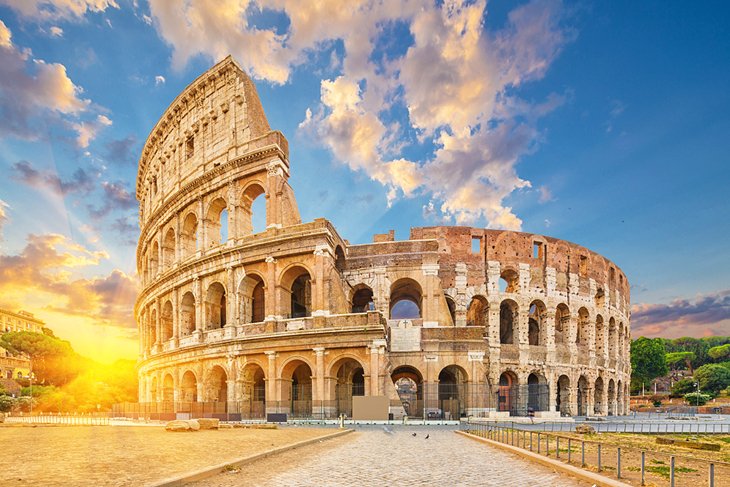
Not surprisingly, the Forum sat at the heart of ancient Rome, so many of that era's most important sights are all around it: the Colosseum , Palatine Hill , and Nero's recently excavated Domus Aurea (Golden House). It's only a short distance to the church of San Pietro in Vincoli , and the Basilica of San Clemente is not far beyond the Colosseum.
At the Colosseo Metro stop, the Oppio Caffe serves pizza and antipasto plates, and is a good stop for coffee. Right above it, on Via Nicola Salvi, is La Biga Ristoracaffe , with outdoor and indoor tables.
Or follow Via degli Annibaldi or Via Colesseo to Via Cavour, in the heart of the Monti neighborhood, where you'll find a concentration of restaurants. Trattoria Da Valentino , at #293 serves home-style Roman dishes. Even closer, opposite the Domus Aurea, Hostaria da Nerone also serves Roman comfort foods.

Via Cavour and its surrounding streets are filled with small shops and boutiques. For leather goods look for verypel , and for original designs in handmade clothing, stop at designer-owned Abito .
Momte is especially known for its vintage clothing shops. Among them are Pifebo on Via dei Serpenti, and Humana Vintage Roma on Via Cavour. For designer fashions, handcrafts, and art, don't miss the weekend Mercato Monti on Via Leonina, where young and emerging designers and artists display their works.
More Related Articles on PlanetWare.com

What to See in Rome: When you're visiting the top-rated tourist attractions in Rome be sure to see our handy guides to the top churches and the best museums and palaces . Our page on visiting Palatine Hill will help you get the most out of this less-visited attraction that's included with your Colosseum ticket.
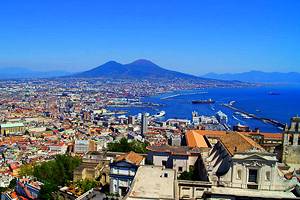
Where to Go from Rome: Many of the best places to visit in Italy are easy to reach on day trips from Rome. You can visit Pompeii and the other city destroyed by the eruption of Vesuvius in AD 79, Herculaneum , or take extra time to see the attractions of Naples .
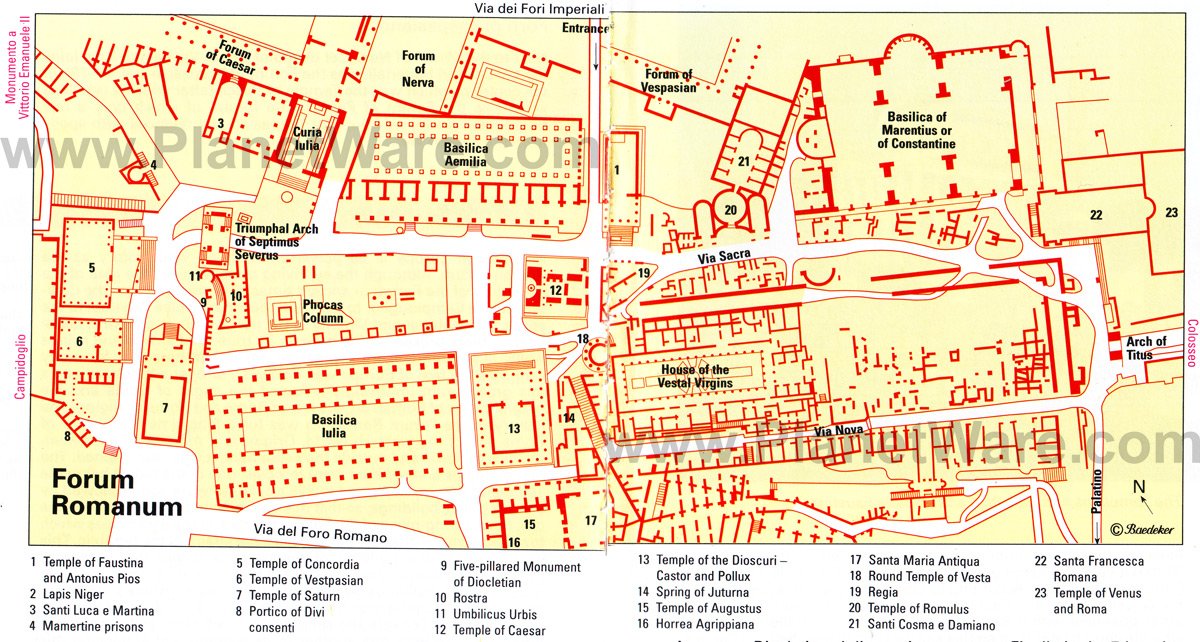
More on Italy

- HelpTourists in Paris
- HelpTourists in London
- HelpTourists in Lisbon

- The most beautiful
- Rome districts
- Parks & Garden
- For couples
- Useful Information
- Everyday life in Rome
- Saving Tips
- Sightseeing
- Architecture
- Holiday Preparation
- Arrival by plane
- Arrival by train
- Underground
- Restaurants
- Coffee shops
- Malls & Stores
- Guided Tours & Walking Tours
- Segway Tours
- New Year’s Eve
- Concerts & Festivals
- Exhibitions
Roman Forum Rome: Tickets, map, hours and entrance
You can find everything you need to know about the Roman Forum in Rome in this article, including opening hours, tickets and how to get there!
The Roman Forum in Rome: Important tips and information for your visit to the Roman Forum
In 1788 Carl Frederik von Fredenheim and his team of archaeologists discovered an amazing site. The Roman Forum in Rome , the biggest forum in the world. For many centuries the Roman Forum had been the center of public and social life in Rome. Public speeches and criminal trials were held there and from time to time gladiatorial contests took place as well. But the Forum was also used as a marketplace. Back in the days the Roman Forum used to be the most important place to buy and sell goods in the Roman Empire. Today it is nothing more but a ruin whose ancient political, religious, commercial and cultural buildings were discovered when excavations took place in the 19th and 20th century. 4,5 million tourists visit the Roman Forum in Rome every year. They gaze at one of the most important excavation sites of the Ancient Rome.
The History behind the Roman Forum in Rome
The Forum Romanum is located in a depression between the pala and the Capitoline Hill. Located not far from the Tiber , this area was often flooded and used to be just swampy waste land for a long time.
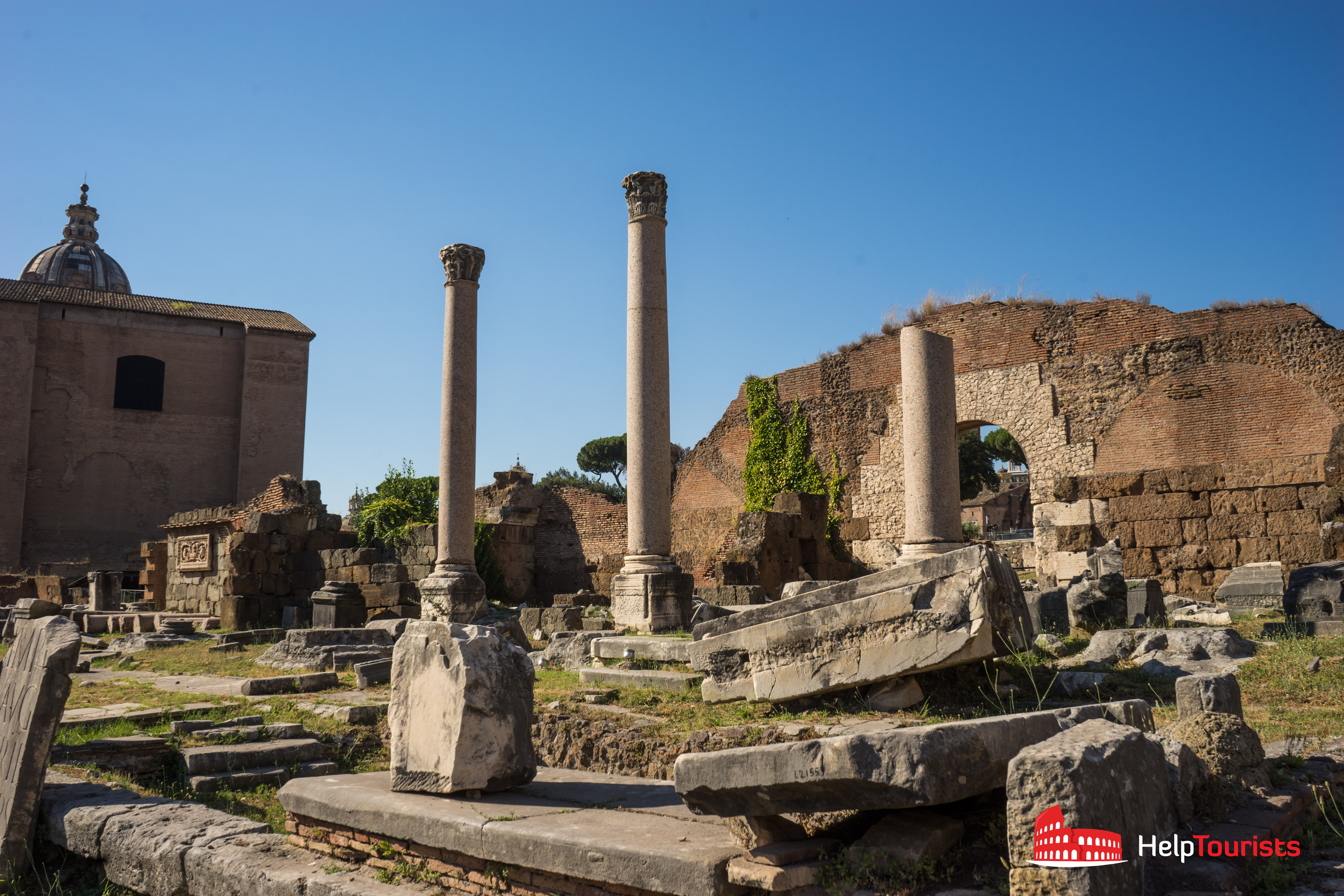
In the 7th century BC the Roman population decided to work against the bog and built the Cloaca Maxima, a drain system. They started building some first houses at this very place, including the Regia, the king’s house, and some temples, as for example the temple of Saturn in 498 BC. In the following centuries many buildings and temples joined the Roman Forum, also called the Forum Magnum and it slowly became the center of Ancient Rome. Many of the once marvelous buildings were destroyed throughout time and can only be guessed at today.
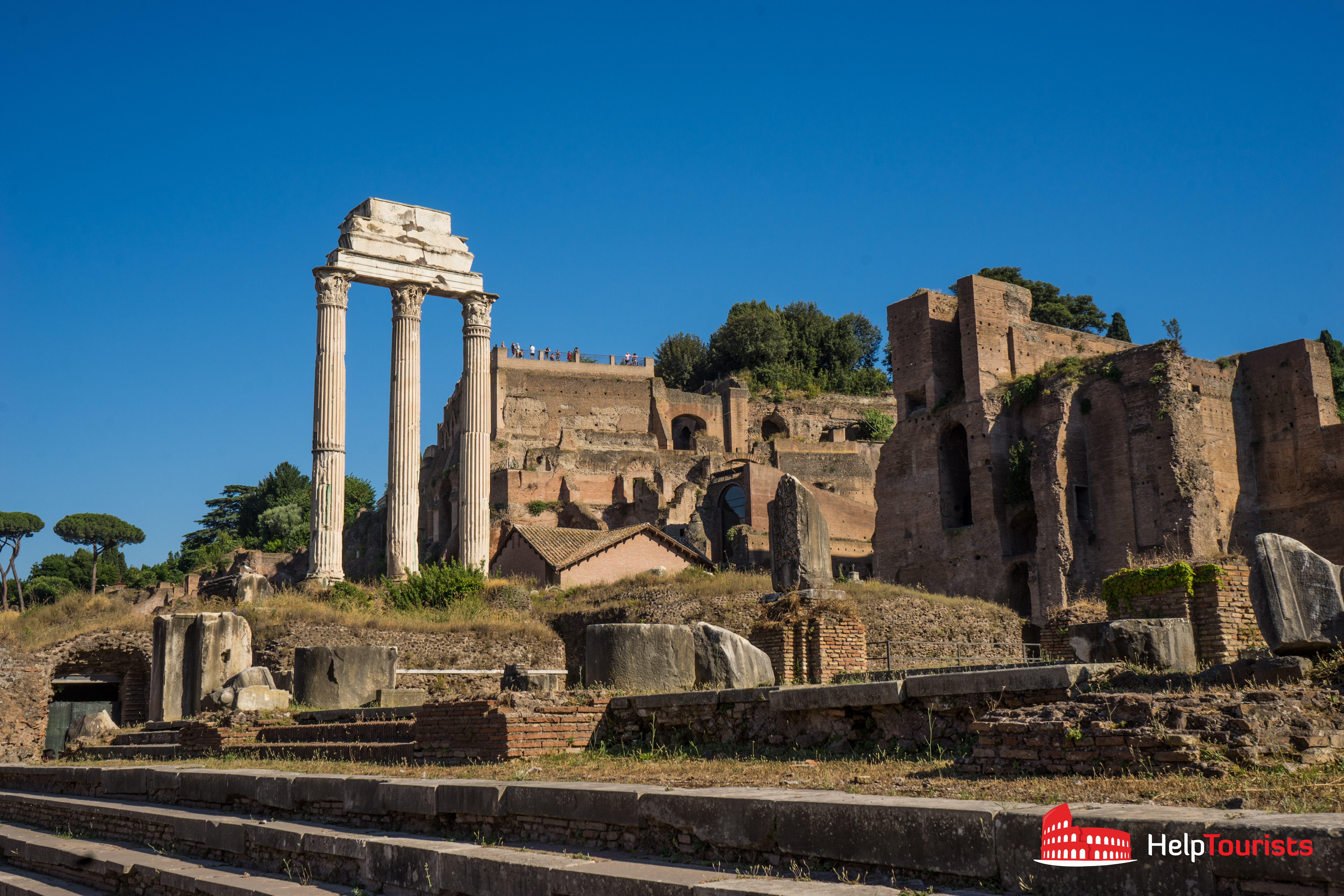
The Forum had its downfall in the 4th Century AD, when Constantine the Great decided to move the political center from Rome to Constantinople. This following, many temples were closed and the Forum lost its importance. Afterwards the Forum in Rome was misused as a stone quarrel by the Roman population. And in the 9th century a heavy earthquake jolted the Forum and many of the remaining buildings and temples collapsed.
Roman Forum Map: What to visit at the Roman Forum in Rome
Here you can see a map of the Roman Forum in Rome :
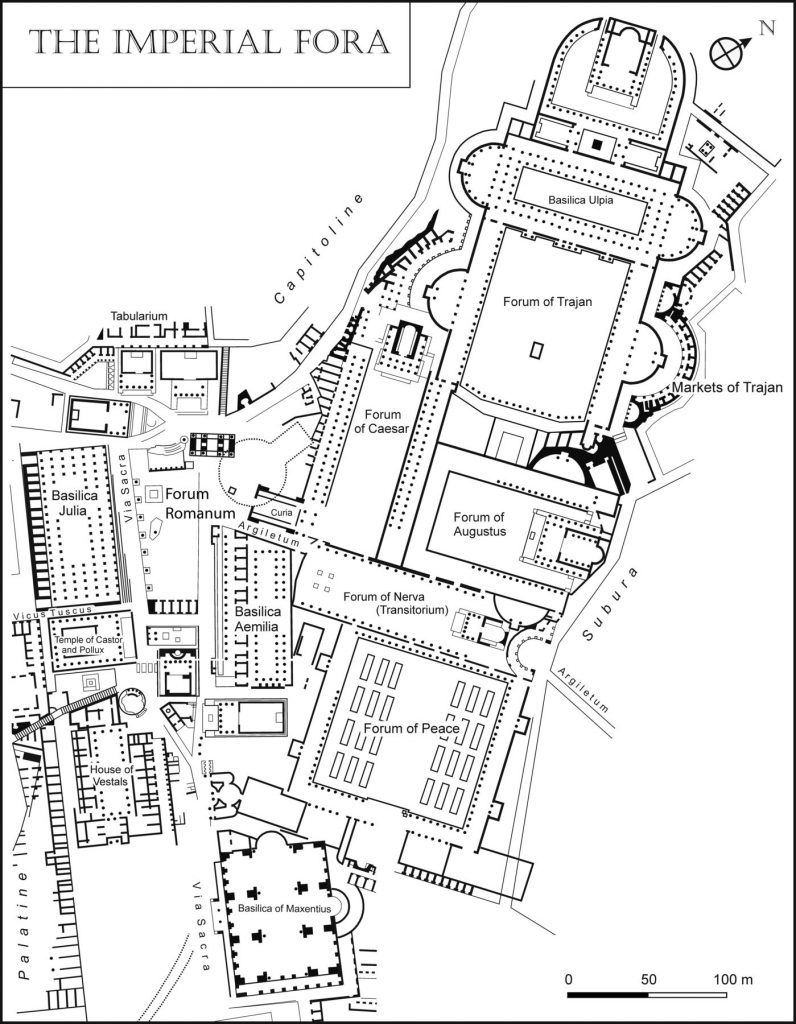
Nowadays few buildings are still recognizable as such. These include the Comitium, a square were the legislative assemblies gathered, the Curia Julia, the former chair of the senate and the Arc of Septimius Severus, an arc which is 20m tall and was made of marble to honor 3 former Roman emperors.
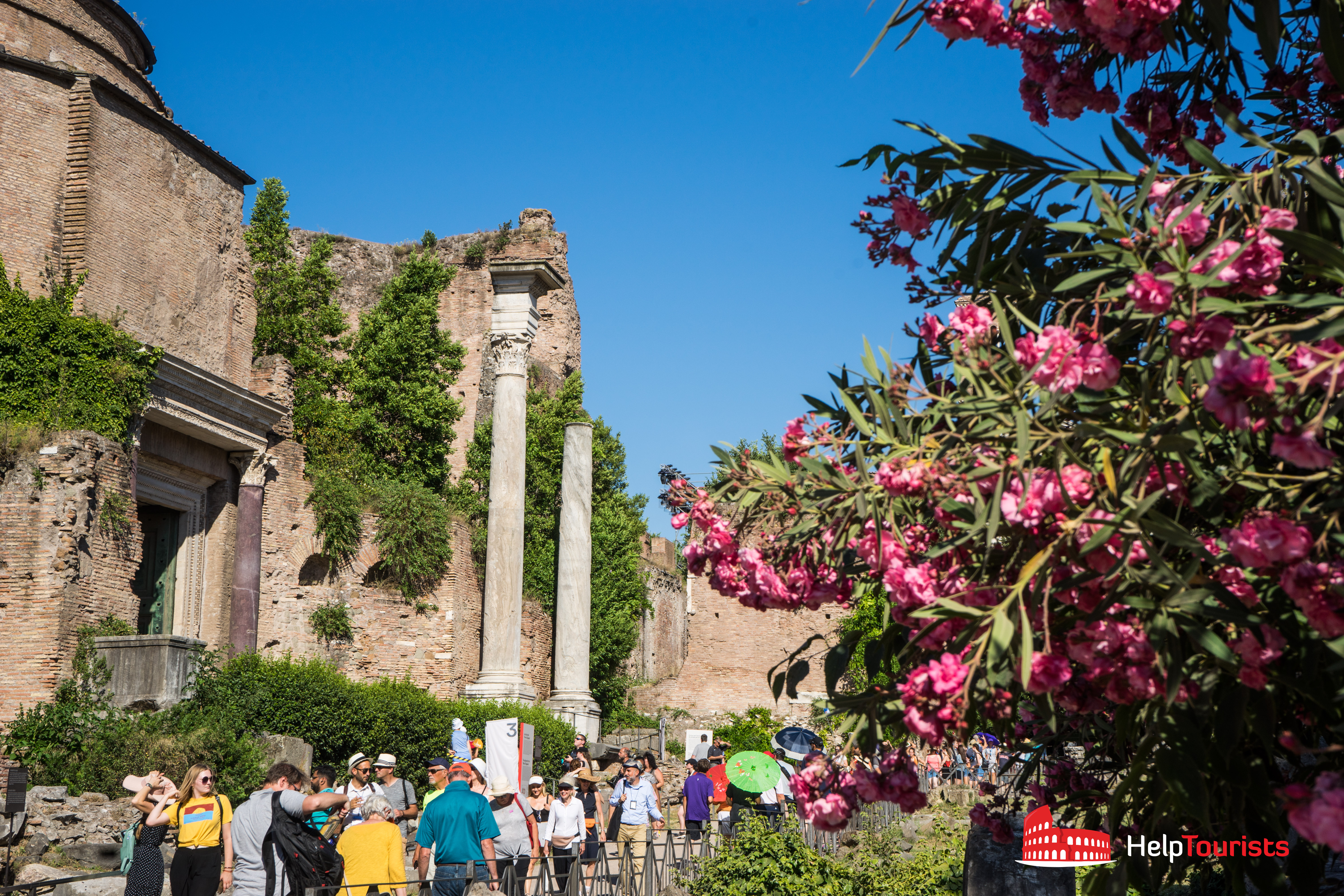
Many other buildings have been destroyed to the point that nowadays only headstones, single columns or walls are left over. To give an example, the only part left to see of the Temple of Saturn is the front wall with its columns. You visit the Roman Forum today? You can walk amidst the impressive scenery, the ruins and temples along the Via Sacra, a cobbled street. In the Ancient Rome the street led out of the Forum to the Capitoline Hill, where the most important Roman temple was located: The Temple of Jupiter Optimus Maximus. The Romans also used the Via Sacra for ceremonies and festivities.
If you visit Rome, do not miss on the Roman Forum. The Forum tells about the Roman history and is a unique testimonial of the Ancient Rome.
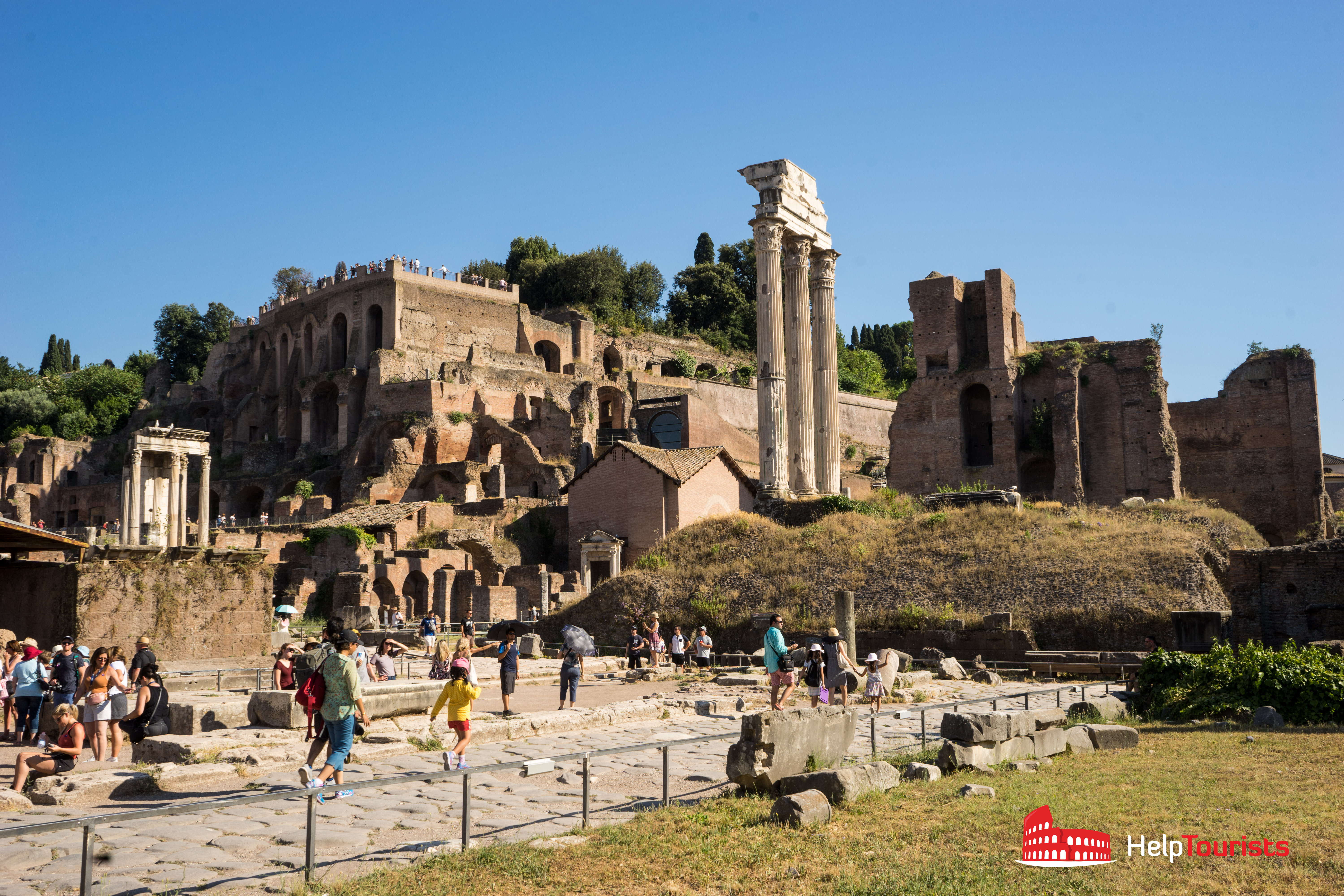
The table below lists the most important buildings in the Roman Forum :
Roman Forum in Rome: How to get there
The Forum Romanum is easily accessible through public transport : The metro station “Colosseo” of the line MEB is only a few steps away. There are also several bus lines, that will bring you very close to the Forum. Including the linen 51, 85, 75, 85, 87, 117 and 18 with bus stops in the Via dei Fori Imperiali. And the lines 40, 60, 80, 780, 781 and 916 which have bus stops at the Piazza Venezia.
Roman Forum in Rome: Entrance
There are two entries to the Forum . On the one hand you can access the Forum via the Via di San Gregoria by getting off at the bus station “San Gregorio” (lines 51, 75, 81, 85 and 87). Or at the tram station “Parco Celio” (lines 3 and 8). If you plan on visiting the Palatine Hill as well, this should be your entrance , as it is not far to both sites from there. Another way to access the Roman Forum is through the Via della Salaria Vecchia. Therefor get off at the bus station “Fori Imperiali/campidoglio” (lines 51, 85 and 87).
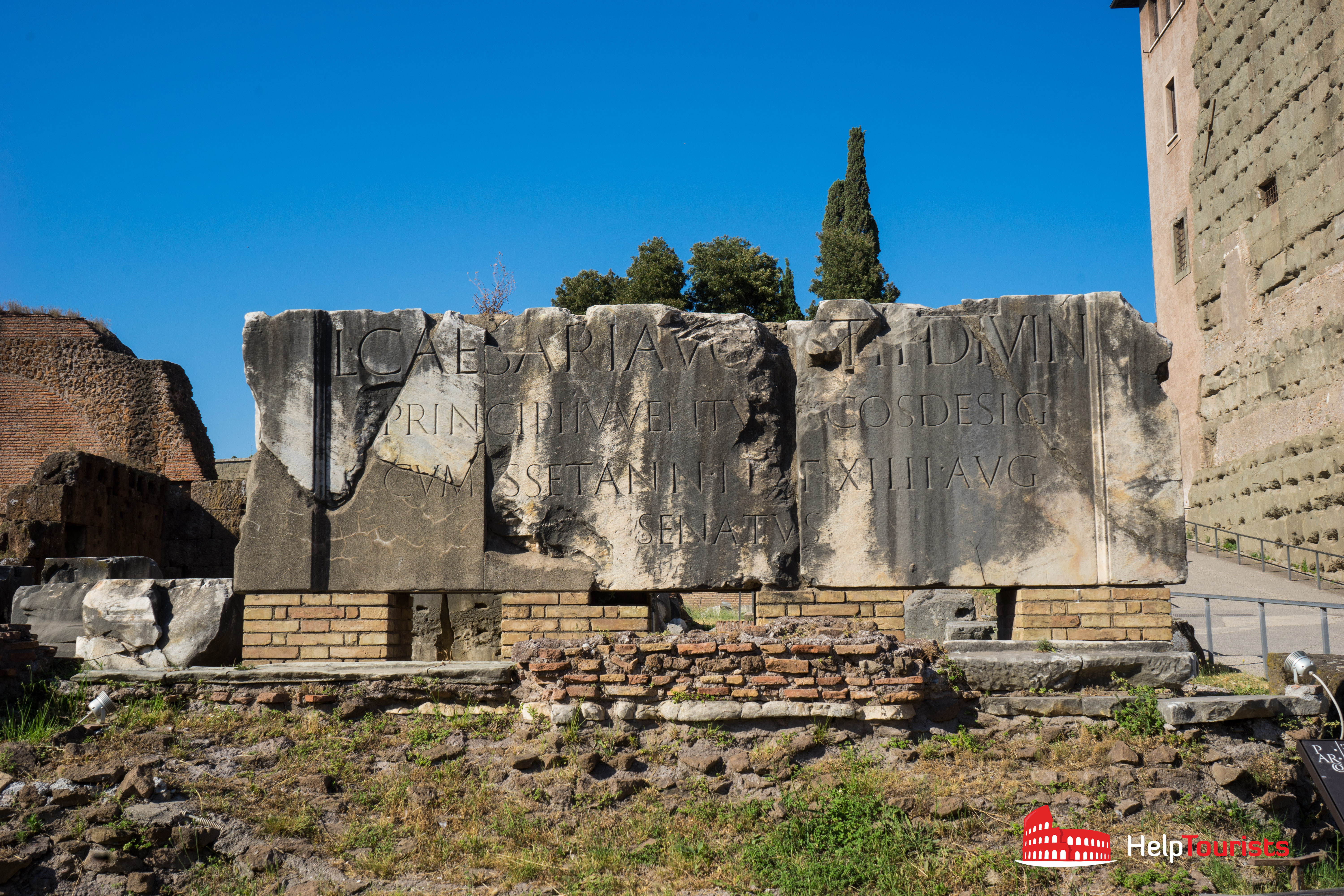
Roman Forum in Rome: Opening hours
The opening hours of the Roman Forum strongly depend on the season . When visiting the Forum make sure you are wearing suitable shoes and that you take enough water with you. Since the Forum is a historical site there are no snack shops inside.
The opening hours of the Roman Forum in Rome are the following. The ticket office closes one hour before the Forum closes.
- Last Sunday of October until the 15th of February from 8:30 am until 4:30 pm
- 16th of February until the 15th of March from 8:30 am until 5 pm
- 16th of March until the last Saturday of March from 8:30 am until 5:30 pm
- Last Sunday of March until the 31st of August from 8:30 am until 7:15 pm
- 1st until the 30th of September from 8:30 am until 7 pm
- 1st of October until the last Saturday of October from 8:30 am until 6:30 pm
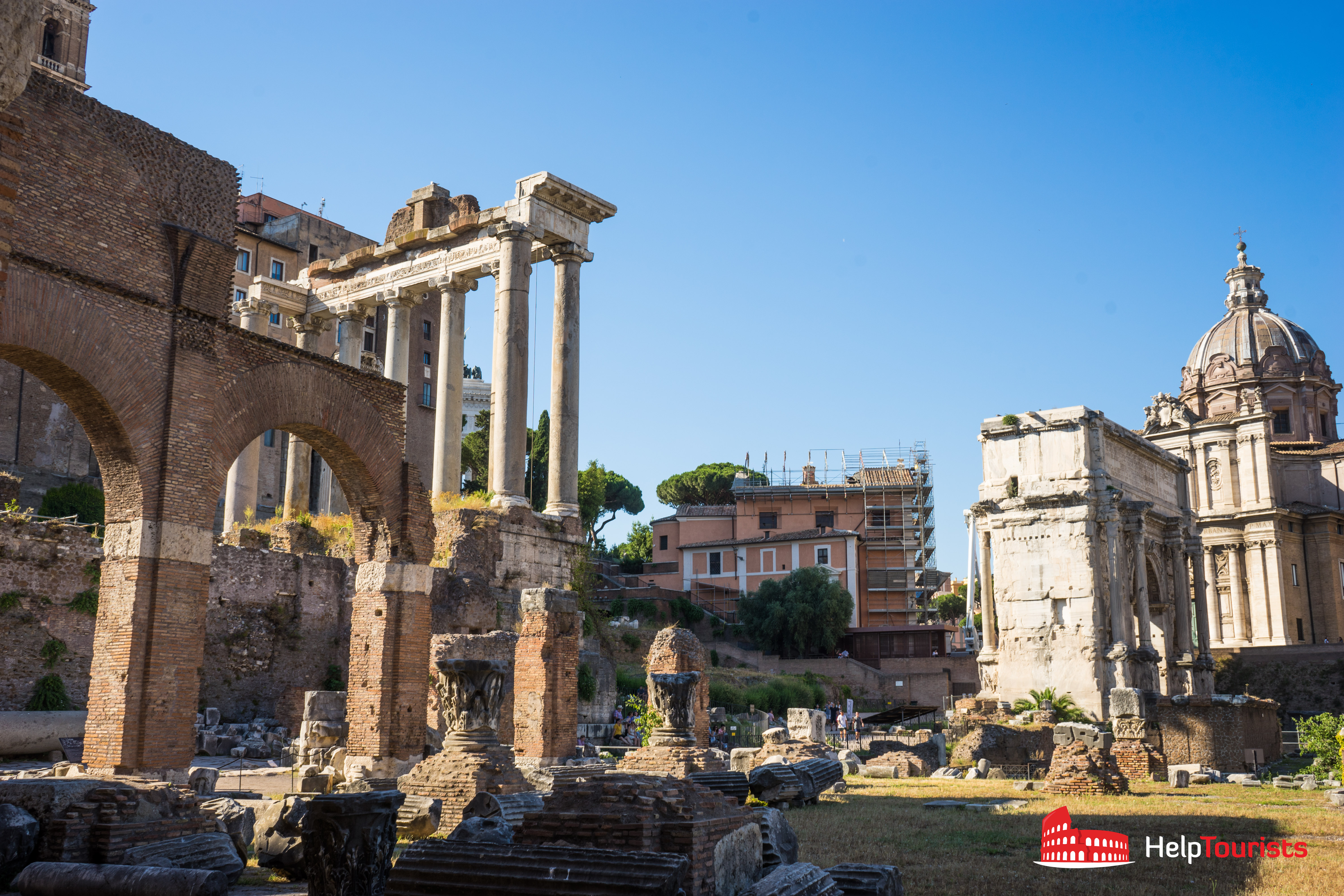
Roman Forum in Rome: Tickets and entry fees
The entry ticket for the Roman Forum also gives you access to the Colosseum and the Palatine Hill and its exhibitions and is valid for 2 days. Adults pay 12 euros, EU-citizens aged 18 to 25 years pay 7,50 euros and teenagers under 18 and disabled persons as well as their assistant can visit the Forum Romanum in Rome for free.
In general I advise you to buy tickets online and in advance. So you can avoid long waiting lines in front of the Roman Forum and the Colosseum.
If you enjoyed this article, subscribe now to receive more just like it.

3 Reader Comments
Comments RSS Feed
Note: cost for combined ticket is 18 € including fee as of 11/7/19. Get at official site if not on a tour
What sites if any, are open on the new year (31 Dec 2019 – 1 Jan 2020). Please specify days and hours.
You’ll find the opening hours for these two days on the official websites of the sites. It is different from site to site.
Sincerely, Denise and the HelpTourists Team.
Leave a Reply Cancel reply
Your email address will not be published. Required fields are marked *
Hi, I’m Denise, welcome to HelpTourists Rome!

Sightseeing Activities in Rome
Click on the button to load the content from getyourguide.com.
Load content
Best hotel room offers
Click on the button to load the content from booking.com.
OTHER CATEGORIES

Transportation
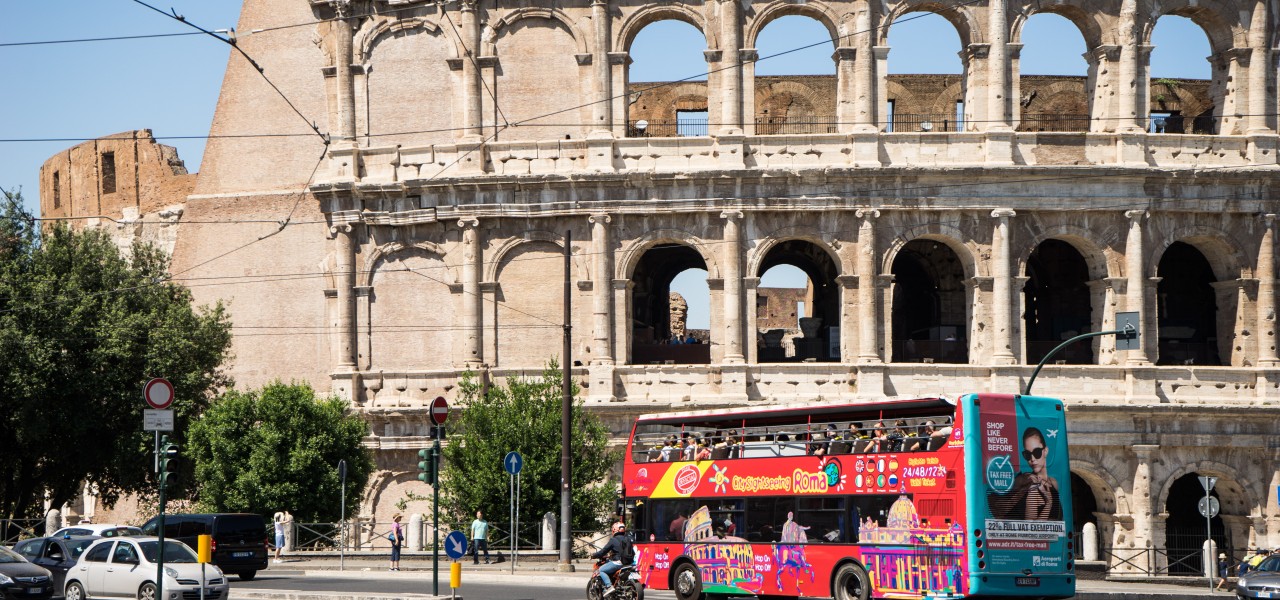
- Data Protection
- Cookie Preference

For those thinking about the Roman Empire.
Roman Forum: History, Location, Buildings, & Facts

The Roman Forum, or Forum Romanum in Latin, stands as a timeless testament to the grandeur and cultural significance of ancient Rome . Nestled in the heart of the modern-day city of Rome, Italy, this archaeological site offers visitors a unique opportunity to step back in time and explore the remnants of a once-thriving center of political, social, and religious life.
This article delves into the history, location, buildings, and intriguing facts surrounding the Roman Forum, and offers a timeline and further reading for easy reference, as well as a fictional diary entry that brings the Forum to life.
Table of Contents
Roman Forum History

The Roman Forum’s history is deeply intertwined with the rise and fall of the Roman Republic and Empire. Its origins date back to the 7th century BCE when Rome was a small village. Over time, as Rome expanded, so did the Forum, evolving from a marketplace to the epicenter of Roman civic life.
Roman Kingdom (c. 7th – 6th century BCE)
During the monarchy, the Forum was primarily a marketplace and meeting place for the community. It was a center for trade and religious activities, with temples dedicated to gods like Saturn and Venus .
Roman Republic (509 – 27 BCE)
The Forum evolved significantly during the Republican period. It became a hub of political activity, with the Senate House ( Curia Hostilia ) and the Rostra, a platform for public speeches. Temples like the Temple of Concord, Temple of Castor and Pollux, and Temple of Saturn were constructed.
Roman Empire (27 BCE – 476 CE)
The Forum continued to expand during the Imperial era, adding grand structures like the Arch of Septimius Severus and the Temple of Antoninus and Faustina. It remained the center of political power, but its significance began to wane as the city expanded and other areas developed.
Decline and Abandonment

As the Roman Empire declined, so did the Forum. It was gradually abandoned, and many of its buildings fell into disrepair. The fall of Rome in 476 CE marked the end of the ancient city and further contributed to the Forum’s decline.
Roman Forum Location
The Roman Forum is situated in the heart of Rome, within the valley between the Palatine Hill and the Capitoline Hill. Its central location made it easily accessible to Romans of all social classes, emphasizing its role as a public gathering place. The site is within walking distance of other iconic landmarks like the Colosseum and the Palatine Hill, making it a crucial stop for tourists exploring Rome’s rich history.
Roman Forum Buildings and Structures

The Roman Forum is home to a collection of remarkable buildings and structures that tell the story of Rome’s illustrious past. Here is a list of a few key monuments in the Forum, some remains of which have withstood the test of time and can still be seen today.
- The Curia Julia : The Curia Julia was the Senate House, where the Roman Senate convened. The original Curia was built by Julius Caesar , but the one we see today dates from the reign of Emperor Diocletian .
- The Rostra : The Rostra was a raised platform from which public speakers addressed the Roman citizens. It was adorned with the prows of ships (rostra) captured in naval battles, hence the name.
- The Arch of Septimius Severus : This triumphal arch, built in 203 CE, commemorates Emperor Septimius Severus and his sons’ victories in Parthia. It features detailed reliefs depicting these victories.
- The Temple of Saturn : Dedicated to the god Saturn, this temple once housed the Roman state treasury. Its iconic columns and pediment are among the Forum’s most recognizable features.
- The Temple of Vesta : This circular temple was dedicated to the goddess Vesta and her priestesses, the Vestal Virgins, who were responsible for maintaining the sacred flame that symbolized the eternal life of Rome.
- The Basilica of Maxentius and Constantine : This colossal basilica, completed in the early 4th century CE, showcased the grand architectural achievements of the time.
Roman Forum Facts
Below are some of the most intriguing facts about the Roman Forum:
- Vestal Virgins : The Vestal Virgins, who tended the sacred flame in the Temple of Vesta, were selected at a young age and took vows of chastity for 30 years. If they broke their vow, they faced severe punishment, including being buried alive.
- Julius Caesar’s Assassination : The assassination of Julius Caesar took place at the Theatre of Pompey, located near the Forum. This event marked a turning point in Roman history, and the exact location where Caesar died can still be seen today.
- Christianity’s Influence : Many ancient temples in the Forum were later converted into Christian churches. For example, the Temple of Antoninus and Faustina became the Church of San Lorenzo in Miranda.
- Excavation and Restoration : The Forum underwent extensive excavation and restoration efforts in the 19th and 20th centuries, allowing us to witness its grandeur today.
Questions and Answers about the Roman Forum
In this section, we explore some of the most frequently asked questions about the Roman Forum, in order to get a deeper understanding of this key area in Rome.
Who created Roman Forum?
Romulus is traditionally considered to have created the Roman Forum, in cooperation with his rival Titus Tatius . We can’t say for sure whether this is true, but what we can confirm is that the Forum initially began as a marketplace in the 7th century BC and expanded under the rule of various Roman kings , leaders, and emperors throughout Rome’s history. Its development was influenced by several Roman architects and leaders, such as Julius Caesar and Emperor Augustus , who contributed to its architectural and structural enhancements.

Why is the Roman Forum so famous?
The Roman Forum is famous for its historical significance as the heart of ancient Rome. It served as the center of Roman political, religious, and social life for centuries . It witnessed numerous important events, including speeches by renowned figures like Cicero and the funeral of Julius Caesar. Its ruins also provide a remarkable glimpse into the grandeur of ancient Roman architecture and culture, making it a renowned archaeological and historical site.
Why was the Roman Forum ruined?
The decline and ruination of the Roman Forum occurred over centuries due to various factors. One major factor was the fall of the Western Roman Empire in the 5th century AD , which led to neglect and abandonment of many Roman structures, including the Forum. Additionally, natural disasters, such as earthquakes and fires , played a role in damaging the Forum’s structures. The removal of valuable materials for use in other construction projects also contributed to its deterioration.
Did all Roman cities have a Forum?
While not all Roman cities had a Forum, many of them did . The Forum was a central feature of Roman urban planning and typically included a marketplace, temples, government buildings, and spaces for public gatherings. The size and grandeur of the Forum could vary depending on the city’s importance and wealth. Major cities like Rome had grand forums, while smaller towns might have smaller, simpler versions.
Is the Roman Forum still used today?
No, the Roman Forum is no longer used for its original purposes . It ceased to serve as a hub of political and social activity over a millennium ago. Today, it is primarily a historical and archaeological site, open to tourists and researchers who want to explore its ancient ruins and learn about its rich history.

Is Roman Forum worth visiting?
Absolutely, the Roman Forum is definitely worth visiting for anyone interested in history, archaeology, or ancient Roman culture . It offers a captivating journey back in time to the heart of one of the world’s greatest ancient civilizations. Exploring its ruins and imagining the bustling activities that once took place there is a remarkable and educational experience.
What was the difference between the Roman Forum and the Imperial Forum?
The Roman Forum and the Imperial Forum were both important public spaces in ancient Rome, but they served different purposes. The Roman Forum was the original forum of Rome and served as a multifunctional center for various civic and religious activities. In contrast, the Imperial Forums were a series of additional forums built by various emperors adjacent to the Roman Forum. Each Imperial Forum was dedicated to a specific purpose or emperor and often included grand temples, monuments, and commemorative structures. The Imperial Forums expanded the civic and architectural landscape of ancient Rome, showcasing the grandeur of imperial power.
In conclusion, the Roman Forum, a microcosm of ancient Roman civilization, continues to captivate visitors with its rich history and architectural marvels. As a place where politics, religion, and daily life intersected, it stands as a symbol of Rome’s enduring legacy. Whether you are a history enthusiast or simply a curious traveler, a visit to the Roman Forum is a journey through time that promises a deeper understanding of the grandeur of ancient Rome.
The following sections will delve into a timeline of the Roman Forum’s development, educational sources on its history, and a fictional diary that makes the Forum come to life.
Roman Forum Timeline
Here is a timeline of the Roman Forum’s development and significant events:
- 8th century BC: The Roman Forum’s place of origin as a marshy valley serving as a marketplace and meeting place for early Roman settlers.
- 7th century BC: Gradual development with the construction of simple wooden structures and temples.
- 509 BC: Founding date of the Roman Republic, marking the Forum’s growing importance as a political center.
- 5th century BC: Construction of the Temple of Castor and Pollux and Temple of Saturn, two of the oldest temples in the Forum.
- 46 BC: Julius Caesar’s renovations, including the Julian Basilica and the Temple of Venus Genetrix.
- 29 BC: Further development by Augustus, including the Temple of Divus Julius and the Temple of Apollo .
- 3rd century AD: Arch of Septimius Severus is erected in 203 AD.
- 4th century AD: Conversion of some pagan temples into Christian churches, including the Basilica of Maxentius and Constantine.
- 5th century AD: Decline of the Roman Empire, leading to the gradual abandonment of the Forum.
- 9th century AD: The Forum becoming a pasture for cattle and largely forgotten during the Middle Ages.
- 19th century: Archaeological excavations and renewed interest in its history and preservation.
- 20th century to today: Ongoing excavations and restoration efforts to uncover more about the Forum’s history.
Further Reading
Below is a list of recommended readings and resources to aid your exploration and expand your knowledge of the Roman Forum. These sources will allow you to have a closer look at various aspects of the Forum, from its architectural marvels to the pivotal historical events that unfolded within its precincts. Whether you are a history enthusiast, an architecture aficionado, or simply curious about the wonders of ancient Rome, there is a wealth of material to satisfy your curiosity.
- “The Roman Forum: A Reconstruction and Architectural Guide” by Gilbert J. Gorski and James E. Packer . This comprehensive guidebook not only provides a detailed overview of the Roman Forum’s history but also offers insights into its architectural evolution. It includes detailed reconstructions and illustrations, making it an invaluable resource for those interested in the Forum’s physical layout.
- “The Roman Forum” by David Watkin . In this book, David Watkin delves into the history of the Roman Forum, tracing its development from its humble beginnings to its peak during the Roman Empire. The book is well-researched and beautifully illustrated, making it a captivating read for history buffs.
- “The History of Rome” by Titus Livius (Livy) . Livy’s monumental work, “The History of Rome” (Ab urbe condita), includes extensive accounts of the Roman Forum and its role in the city’s history. Reading Livy’s original accounts can provide a firsthand glimpse into the Forum’s significance in Roman society.
Fictional Diary Entry
Below is an attempt at writing a fictional diary entry from the imagined character Chileos of Athens, in order to bring the Roman Forum to life. Enjoy!
March 29, 44 BC
Today, I had the extraordinary privilege of visiting the Roman Forum, a place that seems to be at the heart of the ancient world. As I walked through the bustling streets of Rome, I could feel the city’s pulse, its lifeblood flowing through the grand monuments and bustling marketplaces.
The grandeur of the Forum left me in absolute awe. Columns soared towards the heavens, adorned with intricate carvings and statues of gods and heroes. The Temple of Saturn stood tall, a symbol of Rome’s enduring strength, while the Rostra, adorned with prows of conquered ships, reminded all who passed of Rome’s maritime prowess.
I found myself drawn to the Senate House, where the fate of the Republic is debated and determined. The great orator Cicero’s voice must have once echoed through these hallowed halls, and I couldn’t help but imagine the heated discussions that took place within.
But the most captivating sight of all was the Temple of Julius Caesar, built to honor the great dictator . It was an emotional experience to stand in front of this temple, knowing that only a few weeks ago, on the Ides of March, the very day we commemorate today, Julius Caesar was assassinated not far from here. The tension in the air was palpable, as though the ghosts of history still lingered, whispering their secrets to those who would listen.
As I wandered through the Forum, I marveled at the everyday life unfolding around me. Vendors peddled their wares, citizens debated passionately, and slaves hurried about their duties. It was a bustling center of commerce, politics, and culture, a true testament to the spirit of Rome.
I couldn’t help but feel overwhelmed by the weight of history that surrounds me here. The Roman Forum is a living, breathing museum of the past, and today, on this momentous day, I felt as though I had stepped back in time to witness the glory and tumultuous events of the Roman Republic firsthand. What a remarkable place, and what a privilege it is to stand here in the heart of ancient Rome.
Chileos of Athens
Related Articles
- Romulus: Founder of Rome, First King of Rome, & Legacy
- Roman Republic: Definition, Origins, Government, History, Fall
- Gaius Julius Caesar: Biography, Facts, Gossip, & Death
Related posts:
- Rubicon River: Italy, Definition, Julius Caesar, & Facts
- Pantheon: Rome, Architecture, Build, & Dome Construction
- Roman Bridge of Córdoba: Significance & Architecture
- Vespasian: Biography, Significance, and Legacy
Do you have a topic you would like to write about?
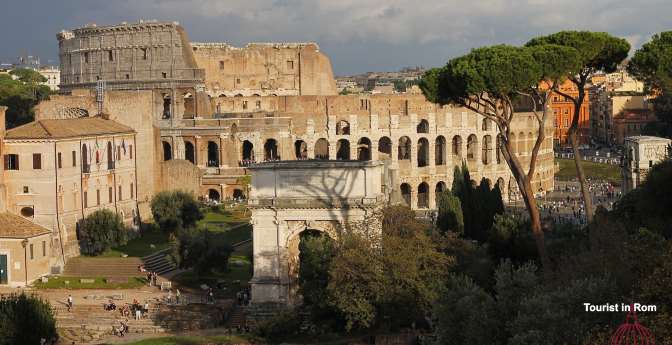
Discover the Roman Forum & Palatine – this is how to do it
With a little trick you save a lot of time when visiting the Imperial Forums, Roman Forum and Palatine and take the most beautiful route.
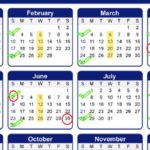
Partner-Links helfen uns dabei, unsere Informationen kostenlos bereitzustellen. Für abgeschlossene Buchungen erhalten wir eine Provision – ohne Mehrkosten für Sie! Mehr
Partner links help us to provide our information free of charge. For completed bookings we receive a commission – at no extra cost to you! More
I link dei partner ci aiutano a fornire gratuitamente le nostre informazioni. Riceviamo una commissione per le prenotazioni completate, senza alcun costo aggiuntivo per voi! Di più
Popular tickets and tours
GetYourGuide
How to save time
With the exception of the night tour of the Colosseum, all tickets include a visit to the archaeological park of the Forums and the Palatine. You can visit the park in the 24 hours before or after your reservation for the Colosseum. If you have the Colosseum entrance time in the early morning, you will visit the park more after, if you have the reservation for the afternoon, you better go to the park before.
The most beautiful route
The most beautiful route is also the fastest. Instead of going from Piazza Venezia to the Colosseum via Via dei Fori Imperiali, you go directly through the Imperial Forums and the Archaeological Park.
As an entrance, or an exit if you visit the park after the Colosseum, take the entrance at the Forum of Trajan. You cannot miss it. Already from Piazza Venezia you can see the column of Trajan in the middle of the Forum. The entrance is in Piazza della Madonna di Loreto. From there to the Arch of Titus, which is the closest to the entrance to the Colosseum, you need an hour. For the Palatine you will need another hour. It also takes an hour to visit the Colosseum. So in total you will need 3 hours.
The Imperial Forums
The imperial forums were built by Caesar and later emperors. They set monuments to themselves and showed their power. But new forums were also necessary, because the existing forums were no longer sufficient.
The Roman Forum
The Roman Forum is the oldest forum and is part of the National Museum of the Colosseum. It is the historical center of Rome and the oldest forum for trade, administration and court proceedings in ancient Rome. Here you will find impressive ruins and architectural masterpieces, including the Temple of Romulus, the House of the Vestal Virgins and the Ramp of Domitian. A guided tour of the Roman Forum is recommended to learn more about the history and significance of these sites.
The Palatine Hill
The Palatine is one of the seven hills of Rome and was probably inhabited 3,000 years ago. Later, dignitaries and rich citizens lived here and the emperors built their palaces here.
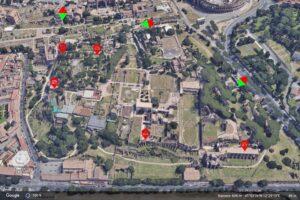
The Palatine is very large and it is easy to get lost there. There are some very nice viewpoints and you can take nice photos of the Colosseum, the Circus Maximus, the Roman Forum and the Capitol Hill. It will take you more than an hour to do this.
On the satellite photo we have marked some viewpoints in red.
You can find more details in our article Ancient Rome .
There are three entrances to the archaeological park consisting of the Roman Forum and Palatine Hill. There is also the entrance to the Imperial Forums.
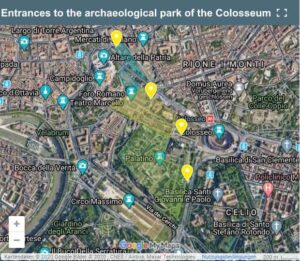
Depending on whether you visit the park before or after the Colosseum and what you want to see, you can choose different entrances. The entrances are:
- Via Sacra: Entrance at the Arch of Titus between the Roman Forum and the Palatine. This entrance is closest to the Colosseum.
- Via di San Gregorio: entrance to the Palatine.
- The entrance to the Forum of Trajan at Piazza Venezia / Piazza della Madonna di Loreto
- The entrance at Via della Salara Vecchia near the Roman Forum, serves only as an exit
- There is another exit to via Petroselli.
Full Experience
With the Full Experience ticket you can visit the arena in the Colosseum and some archaeological sites of the park and the museum on the Palatine.
The archaeological sites are part of the SUPER Ticket Seven Unique Places to Experience in Rome, currently offered only as Full Experience. Only a limited number of visitors are allowed to visit the different sites at the same time.

For Rome lovers and cultural experts, a visit to these sites is mandatory. Some sites may be closed for restoration work.
The opening times are:
House of Augustus 40 minutes max. 23 visitors
Curia Iulia
House of Livia 30 minutes max. 23 visitors
Santa Maria Antiqua with Oratory of the 40 Martyrs and Ramp of Domitian 30 minutes max. 60 visitors
Temple of Romulus 15 minutes max. 30 visitors
Palatine Museum ~ 1h
Emperor Nero’s Domus Transitoria
Criptoportico Neroniano 12 minutes max. 35 visitors
Aula Isiaca + Loggia Mattei 15 minutes max. 15 visitors
Opening hours
Roman Forum and Palatine have the same opening hours as the Colosseum:
From the beginning of winter time – end of February: 8:30 am – 4:30 pm
March – end of winter time 8:30 am – 5:30 pm
From the beginning of summer time – August 31, 9 am – 7:15 pm
September 9 am – 7:00 pm
October 1st – end of summer time 9 am – 6:30 pm
Eating around the Colosseum
There are few gastronomic highlights around the Colosseum. The top restaurant Aroma with a view of the Colosseum is located in Via Labicana on the top floor of the Hotel Palazzo Manfredi, In Via di San Giovanni in Laterano you can eat very well at Isidoro. At Isidoro you can order very tasty mixed antipasti or mixed 1st courses (Primi). Also in the side streets there are some quite nice restaurants. You will find a larger selection if you walk down Via dei Fori Imperiali and then turn right into Via Cavour. Angelino ai Fori is just on the corner. You will certainly find what you are looking for there and in the Monti Quarter beyond. You can also go down Via dei Fori Imperiali to Piazza Venezia and then left to Torre Argentina and left again to the ghetto. There you will find mainly Roman cuisine.
More about the Colosseum
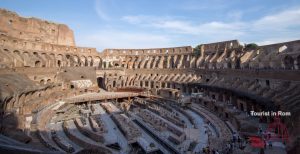
Colosseum Rome · Tickets & tours · Useful information
The Colosseum, originally called the Flavian Amphitheatre, is an iconic symbol of Rome and one of … >>>
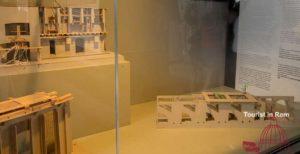
How the Colosseum Worked · Archaeological Research
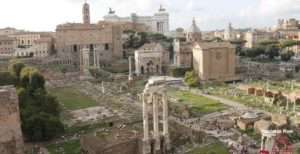
Walk through Ancient Rome · with 3D animations
Suggested combinations
After you have rested a little, you can think about how to proceed. The obvious thing to do is to visit the Caelius Hill with the beautiful churches that are located there. Or you can go up the Oppius Hill to the Basilica of San Pietro in Vincoli and continue towards Monti. Or maybe you’d like to go to the city center to see the Trevi Fountain and Spanish Steps, and to do some shopping.
If you want to see more ruins, you can also go to the Baths of Caracalla. With the bus 118 you can get to the catacombs on the Via Appia Antica.
Very relaxing is the onward journey with the hop on hop off buses . The bus stop is in Via di San Gregorio at the entrance to the Palatine. You can take buses 40 or 64 from Piazza Venezia to the Vatican.
Via San Giovanni in Laterano
Via di San Giovanni in Laterano starts from the Colosseum. Past the excavations of a gladiator school and the Basilica of the Dominican San Clemente, this small, cozy street with nice bars, restaurants and shops leads to the Basilica of San Giovanni and the Holy Stairs and on to Via Appia Nuova.
Oppius Hill
On the north side of the Colosseum rises the Oppius Hill, in which Emperor Nero’s Domus Aurea is buried. The golden palace can only be visited on weekends because excavations are carried out during the week.
There are picturesque streets on the Oppius. The Basilica of San Pietro in Vincoli is a well-known attraction.
If you continue along Viale Monte Oppio, you will come to the Basilica of Santa Maria Maggiore.
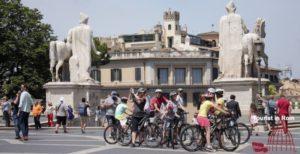
What's on in Rome
Hidden gems
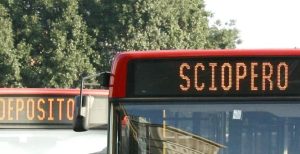

Stories by Soumya
The Travel Blog of a Culture Addict

Visiting Roman Forum – Hours, Tickets, And All You Need To Know
Last Updated on December 23, 2021 by Soumya
Visiting the Roman Forum? Planning to add this stunning Italian landmark to your Rome itinerary? Keen to find out all about Roman Forum tickets, opening hours, and guided tours?
Well, you are in luck. Because we have just the perfect Roman Forum travel guide for you.
Rome’s historic center, a UNESCO World Heritage Site, is home to 3 iconic monuments – the Colosseum, the Palatine Hill, and the Roman Forum. Colosseum refers to the ancient amphitheater. Palatine Hill housed the palaces of Roman emperors and the Forum was the official center.
After writing an in-depth travel guide for the Colosseum, I was inspired to put together a similar one for visiting the Roman Forum. Planning a trip to these huge historical landmarks can be a little overwhelming especially with so many things to do and plan before you go. But we are here to help you.
As you take time to plan your Italy trip , make sure to have this Roman Forum guide in your Rome arsenal. Here, you will find everything you need to plan an epic trip to the Forum in Rome including details on tickets, opening hours, history and best things to do.
Table of Contents
What is the Roman Forum?

The Roman Forum, or Forum Romanum for Latin, is a rectangular-shaped plaza in the center of Rome.
Many centuries ago, the Forum was the heart of all events and gatherings in the city. It was where Romans held elections, affairs of public speaking, commercials, criminal trials, and, of course, gladiator matches. Shop and stalls lined these streets. Many of the oldest and most significant government offices were located at the Roman Forum, or at least nearby.
The historical impact of the Roman Forum is overwhelming because it was once the epicenter of Ancient Rome and was even known to be the most important and celebrated meeting place in the history of the world.
Nowadays, its ruins are open for exploring and touring. If you want to get deep into the history of Italy, particularly the capital city Rome, visiting the Forum is one of the best things to do in Rome . After the Colosseum, of course!
Also see: Ultimate guide for visiting the Roman Colosseum
Please note: This post may contain affiliate links which means I may earn a commission if you make a purchase by clicking a link on this post. This will be at no additional cost to you. Affiliate links help me keep this website up and running. Thanks for your support!
History of the Forum
According to legends surrounding the Forum, it was initially built as a sign of an alliance between the creator of Rome, Romulus (he lived on Palatine Hill), and his rival, Titus Tatius (he occupied Capitoline Hill). Since there was a valley at a convenient location between the two settlements, the rulers decided to build a forum there, where the two communities could meet due to their newly-acquired peace.
The first time people began meeting here was when the Roman Republic was founded in 500 BC. It gradually expanded over time, especially noticeably during the reign of Julius Caesar. At one point, Caesar even had to acquire additional ground to make space.
However, as time passed. more and more political and economic gatherings started happening in other areas. The Forum was used less frequently. Gradually, it fell into disuse and most of it was destroyed around the time the Roman Empire began to fall in 410 A.D.
When you are at the Forum, try and imagine all the great emperors that addressed their people right here, with looming columns and precisely carved sculptures in the background. Gives you goosebumps, right?
The Roman Forum in recent past
A famous archeologist Carlo Fea rediscovered the Forum in 1803, but it took over a hundred years to thoroughly search the site and excavate the ground.
If you explore closely, you might still see the structural damage on the concrete made by heavy rains in 2008.
In 2020, Italian archeologists discovered a sarcophagus without a clear understanding of who it was for. Many debates eventually led them to believe that it might have been built for Romulus, the founder of the city.
Now, Roman Forum is a top-rated tourist attraction. Visitors are allowed to indulge in walking tours around the Forum and experience the vast architecture of Ancient Rome firsthand.
Archeological diggings are still active to this day because historians are sure that there are still many secrets that lie beneath the grounds of this ancient plaza.
Things to do at Roman Forum
The Roman Forum is filled with incredible things to do, most of them buildings and temples from ages ago. Here are some of the unmissable ones.

Via Sacra is the main street that crosses this establishment.
According to legends, this street is where Romulus won over Titus Tatius. Not only that but Via Sacra was also used for triumphant marching of the leaders after every big win. Later on, the street was used for military parades.
Walk with your head held high, and inhale the pride and power of the Romans, still lingering in the air.
Temple of Antoninus and Faustina
After walking Via Sacra, stop at the Temple of Antoninus Pius and Faustina.
A remarkable building in the Roman Forum, this temple is hard to miss. Its ten looming columns will catch your eye in an instant.
Roman Emperor, Antoninus Pius built the temple for his wife Faustina, who died in 141, making her the first empress to be deified. After the death of Antoninus, the temple was re-dedicated to both of them.
Between 600 – 800 AD, the temple was incorporated into the church of San Lorenzo.
Temple of Saturn
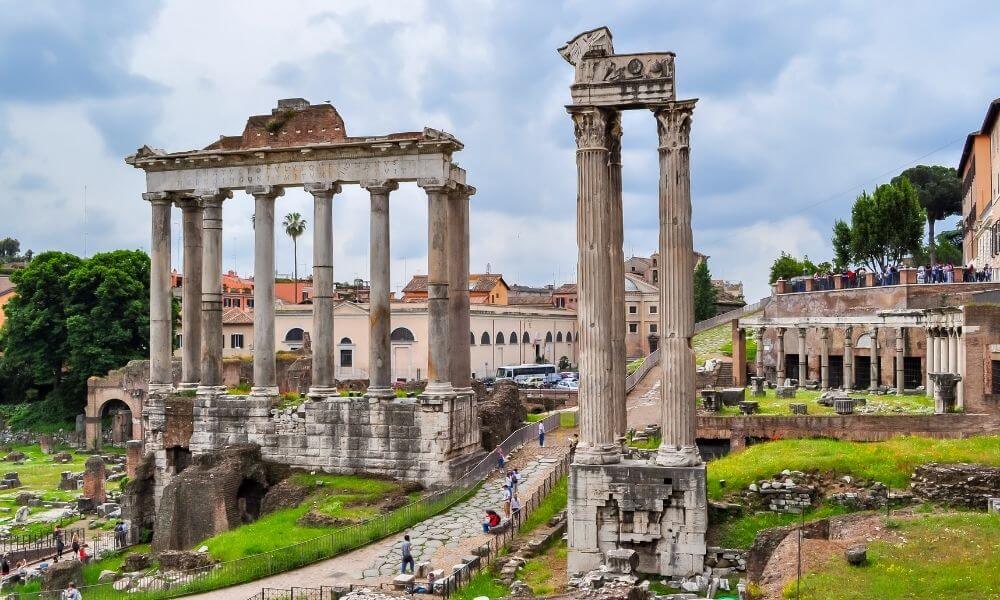
The Temple of Saturn is the most iconic of all surviving buildings in the ancient plaza. After all, this is the temple that we always see in pictures of the Roman Forum, don’t we?
This is one of the oldest sacred sites in the Forum and was dedicated to the Saturn, Roman God for seed-sowing and agriculture. It was originally built in the 5th century BC, destroyed by a fire, rebuilt in 42 BC, and again restored between 3rd and 4th century AD. The eight ionic columns that we see today belong to the 1st century BC.
Since Saturn was the God of agriculture and food, this temple held great importance for the Romans. It functioned as the State Treasury and a storehouse for the Empire’s reserves of gold and silver. It was also home to bronze tablets on which the Law of the Twelve Tables was inscribed. Plus, functioned as a safehouse for state archives, standards, and official weighing scales.
The Curia Julia

What looks like a plain, unexciting building from outside once used to be the meeting place of the Roman Senate. The Curia Julia is probably the world’s oldest senate buildings in existence today.
Julius Caesar commissioned the Curia in 44 BC but Augustus Caesar completed it in 29 BC. A fire damaged the building in 2nd century after which it was restored. Today, it is one of the best-preserved buildings in the Forum which was eventually turned into a church dedicated to St. Adrian in the 7th century.
Septimius Severus Arch
You cannot miss the ruins of Septimius Severus Arch, one of the most impressive monuments in the Roman Forum.
Built in 203 AD to commemorate the victories of Emperor Septimius Severus over the Parthians, the triumphal arch stands out among the ruins of the Roman Forum today. It is almost 70 feet high, built of white marble, and has 4 reliefs (in various states of repair) that show scenes from the Parthian wars.
Practical information for v isiting Roman Forum
The Forum is located right between the Colosseum and Palatine Hill. You will find all three of these legendary places in the heart of Rome, reachable by buses and metro if you are staying a little further away!
The exact address is Via della Salara Vecchia, 5/6, 00186 Roma, according to Google. You will find the Forum’s main entrance along Via dei Fori Imperiali between the Colosseum and Piazza Venezia.
How to get to the Forum in Rome?
The simplest way to get to the Forum is by taking the metro to Colosseum, Line B. It brings you right to the place; the Forum will be on your right when you get off.
You can also take a bus or tram. Bus numbers 75, 81, 673, 175, and 204 and Tram #30 are the ones that stop next to the Colosseum.
And of course, you can always take a cab. Just be ready with some cash because some of them will not accept card payments.

Opening hours
The Forum is open every day from 8 am to 7 pm except on December 25th and January 1st.
According to latest updates on the official website , the Forum is open from 9am – 4:30pm between 1st Nov, 2021 – 28 Feb, 2022. Be sure to check before visiting.
Roman Forum tickets and prices
It is a good idea to buy a ticket that combines visits to all three supersites (as the Romans call them) – the Colosseum, the Palatine Hill, and the Roman Forum.
A 24-hour ticket to all three costs €18 (price € 16 and reservation fee € 2) and that includes one timed-entrance for the Colosseum and one open entrance each for the Forum and the Palatine Hill. Get all details here .
One important point to remember is that you will need a free ticket for kids including small ones in strollers. Be sure to reserve them online in advance.
If you are look for a fast track ticket, buy yours here .
Best tours for visiting Roman Forum
Tours of the forum and ancient rome.
They include long and thorough walks through the Colosseum, Palatine Hill, and the Roman Forum. Some tours also include other famous monuments, such as the Pantheon, Trevi Fountain, and Piazza Navona. These are the ones that are the most tiring but will leave you the most knowledgeable too!
Here are a few great Ancient Rome tours to choose from.
Segway or bicycle tours
If you are not keen to walk around and prefer not to drive, try a Segway tour like this one or an electric bike tour like this one .
If you are a DIY person, then there is always the choice to travel independently and explore Rome’s gems on your own including visiting the Roman Forum. Be sure to grab a copy of this travel guide to plan a memorable visit.
There is a lot to take in but it is better to be well prepared for seeing such an important site as the Roman Forum. My last piece of advice would be that you take your time. Soak up as much as you can and do not leave until you have learned everything you want to know. Just have fun!
All images sourced from Canva Pro.
Visiting the Roman Forum? Pin this ultimate Forum guide.
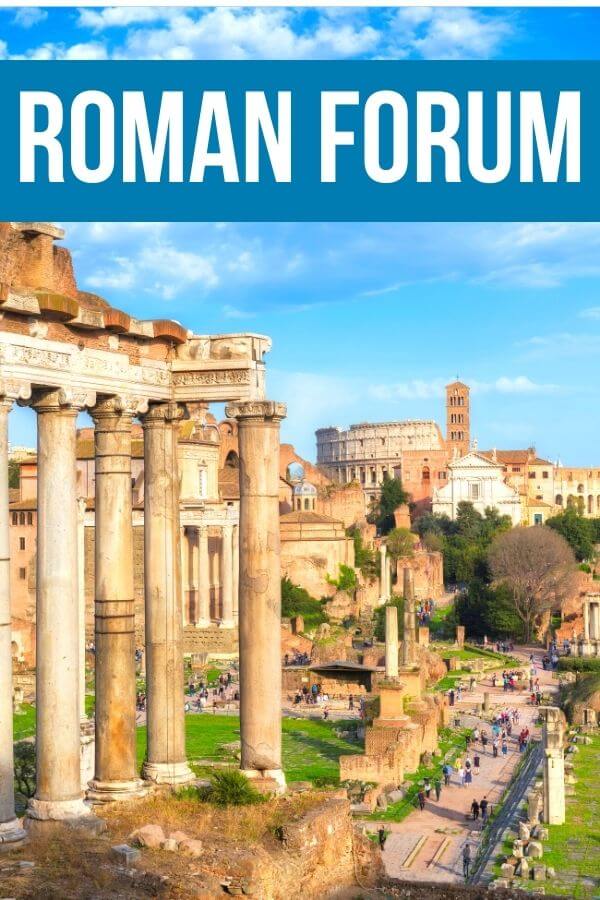
You may also like:
- 10 Must-Do Things In Rome
- A Complete Guide To Visiting The Colosseum In Rome
- How to Spend 3 Days in Rome - Perfect 72-Hour Itinerary
Leave a Reply Cancel reply
Your email address will not be published. Required fields are marked *
Post Comment
This site uses Akismet to reduce spam. Learn how your comment data is processed .
Begin typing your search term above and press enter to search. Press ESC to cancel.

COMMENTS
Palatine Hill is open from 10:00 - 19:15. While both the Colosseum and the Roman Forum are open 09:00 - 16:30. The last admission is an hour before closing. You should head to the Via dei Fori Imperiali entrance to enter the Roman Forum. You can choose between 5 visit routes, which vary from 30 minutes to 2.5 hours.
The best things to see in the Roman Forum. The Roman Forum is a rather large area with plenty of things to see. The Forum Proper is a flat area comprised between the Capitoline Hill and the Palatine Hill, the two most significant of the seven hills of Rome. The Palatine Hill is immediately above the Forum and it is accessible though it.
by Mihir. March 9, 2023. The Roman Forum (Foro Romano) sits at the top of any list of must-see Rome attractions for visitors, jostling for position along with the Colosseum, the Pantheon, St. Peter's Basilica, and the Vatican Museums. Though a highlight on the tourist trail around Rome, the Roman Forum can be a baffling disappointment as ...
Price. Combined ticket to visit the Colosseum, the Roman Forum and the Palatine: Adults: € 16 (US$ 17.10) European Union members (18 - 24): € 2 (US$ 2.10) Children (ages less than 17) and seniors (over 65) members of the EU: free entrance
Roman Forum History. Building in the Forum dates back to as early as the 7th century B.C. On the northern end of the Forum near the Capitoline Hill are some of the oldest ruins of the Forum including marble remnants from the Basilica Aemilia (note that a basilica in Roman times was a site of business and money lending); the Curia, where Roman ...
Tours of the Roman Forum. If you don't know what tour to choose, but you want to have a guide tell you all you need to know about the Roman Forum, here are 2 great options: 3-hour Guided Tour to the Colosseum and the Roman Forum. Colosseum, Roman Forum, Palatine Hill & Mamertine Prison Guided Tour.
1 October to 30 October: 9:30 AM-6:30 PM. 31 October to 26 March: 9:30 AM-4:30 PM. Last Entry: One hour before closing. Closure: The Roman Forum is closed on December 25 and January 1. NOTE: According to the month and season of the year, the Roman Forum extends or reduces its opening hours. Check the updated timings before making your visit.
The Temple of the Divine Caesar in the Roman Forum is a famous monument dedicated to Julius Caesar, a pivotal figure in Rome's transition from republic to empire. The temple told the story of Caesar's life. But it also marks the spot where Caesar, assassinated on March 15, 44 B.C., was cremated and buried.
The Roman Forum, also known by its Latin name Forum Romanum (Italian: Foro Romano), is a rectangular forum surrounded by the ruins of several important ancient government buildings at the centre of the city of Rome.Citizens of the ancient city referred to this space, originally a marketplace, as the Forum Magnum, or simply the Forum.. For centuries, the Forum was the centre of day-to-day life ...
Today, the Roman Forum is one of the most famous tourist sites in the world, attracting more than 4.5 million visitors annually. Forum's Early History .
The Palatine Hill is one of the seven hills upon which Rome was established and, along with the Roman Forum, is one of the most ancient parts of the city. Legend has it that founding twins Romulus and Remus were discovered in a cave here, being looked after by a she-wolf. And although little remains of the twins today, the hill is still home to ...
This 40-minute walking tour transports you back to the 1st century C.E., providing a glimpse into the thrilling and competitive world of the Roman Empire's favorite pastime. Several tour providers, such as Through Eternity Tours, offer guided walking tours of the Roman Forum led by highly knowledgeable archaeologists.
The Roman Forum was once the center of power of the Roman Empire.Today, numerous ruins of ancient buildings reflect the impressive architecture and the opulent economic conditions of the empire. Walking the excavations along the gigantic columns and wall remains, you get an impressive sense of Roman architecture's brilliance.
Roman Forum location entrances. The Arch of Titus near the Colosseum, the Temple of Venus, and Via di San Gregorio are the four main entrances to the Roman Forum, located midway down Via dei Fori Imperiali (via the Palatine). Opening hours. The site is open every day: 8:30 am until 7 pm and is closed on 25 December and 1 January. Roman Forum ...
The Roman Forum was home to some of the oldest and most important buildings in the ancient city - what you will see today is a mass of ruins, including shrines and temples, such as the House of the Vestal Virgins. The most ancient monuments at the Roman Forum are from the first kings of Rome, dating back to the sixth century BC.
Few sites are so filled with a sense of history as the Roman Forum (Foro Romano), where, for many centuries, the fate of Europe was decided. Although the surviving remains give only a hint of the grandeur and splendor of the Forum in ancient times, this area, with its columns still standing tall or lying tumbled on the ground, its triumphal arches, and its remains of once-important buildings ...
9.00 am - 6.30 pm. from 27 October to 31 December 2024. 9.00 am - 4.30 pm. Tickets. Accessibility and services. How to get here. The Forum was originally covered by a swamp. It was only in the late 7th century BCE that the valley was reclaimed and the Roman Forum began to take shape. It was destined to remain the centre of public life for ...
The Roman Forum was the scene of public meetings, law courts, and gladiatorial combats in republican times and was lined with shops and open-air markets. Under the empire, when it primarily became a centre for religious and secular spectacles and ceremonies, it was the site of many of the city's most imposing temples and monuments. Learn ...
The Roman Forum in Rome: Important tips and information for your visit to the Roman Forum. In 1788 Carl Frederik von Fredenheim and his team of archaeologists discovered an amazing site. The Roman Forum in Rome, the biggest forum in the world. For many centuries the Roman Forum had been the center of public and social life in Rome.
Roman Forum. The heart of the ancient world was the bustling Forum, which was the political, religious and commercial center of Rome. The forum was alive with government activity, merchant business, market stalls, temples, courts and brothels. Its monuments remind visitors of Rome's domination and power as the preeminent empire of the time.
The Roman Forum, or Forum Romanum in Latin, stands as a timeless testament to the grandeur and cultural significance of ancient Rome.Nestled in the heart of the modern-day city of Rome, Italy, this archaeological site offers visitors a unique opportunity to step back in time and explore the remnants of a once-thriving center of political, social, and religious life.
Already from Piazza Venezia you can see the column of Trajan in the middle of the Forum. The entrance is in Piazza della Madonna di Loreto. From there to the Arch of Titus, which is the closest to the entrance to the Colosseum, you need an hour. For the Palatine you will need another hour. It also takes an hour to visit the Colosseum.
Now, Roman Forum is a top-rated tourist attraction. Visitors are allowed to indulge in walking tours around the Forum and experience the vast architecture of Ancient Rome firsthand. ... Practical information for visiting Roman Forum Location. The Forum is located right between the Colosseum and Palatine Hill. You will find all three of these ...